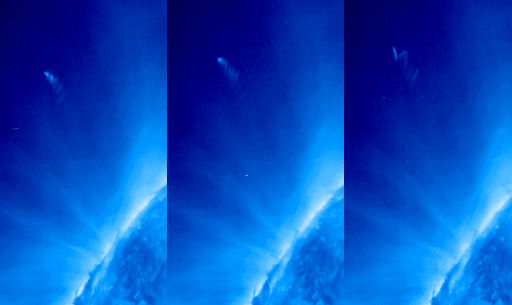Susan Joy Rennison's
Website

|
|

Financial System
Black Swan - Imminent!
30th January 2024
|
|
 The Book of Destiny
The Book of Destiny
28th November 2009
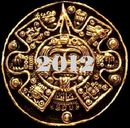 2012 What's Really Happening
2012 What's Really Happening
28th October 2009
Unidentified Aerial Phenomena: A Scientific Perspective
27th September 2009
 Watch Out!
Watch Out!
Planet Under
Reconstruction!
May 2009
2012 Galactic Cosmology
29th April 2009
MP3 Interview Update
 Don Alejandro Speaks
Don Alejandro Speaks
17th April 2009
 The Keepers of
The Keepers of
Ancient Knowledge
29th December 2008
 Major Milestones
Triumph!
Major Milestones
Triumph!
 28th October 2007
28th October 2007
DNA & Environment
May 2007
This website is best viewed with the FireFox browser, you can download it here

click icon
|
Space Weather & Energy Driven Evolutionary Change
The Celestial Deluge &
Arrival of Cosmic Fire
|
|

News of the Imbalance
Best of the Blog - Space & Cosmology
Menu   Next
Best of the Blog - Space & Cosmology (0)
Distant quasar illuminates a filament of the cosmic web
University of California News, 19th January 2014

Astronomers have discovered a distant quasar illuminating a vast nebula of diffuse gas, revealing for the first time part of the network of filaments thought to connect galaxies in a cosmic web. Researchers at the University of California, Santa Cruz, led the study, published January 19 in Nature.
Using the 10-meter Keck I Telescope at the W. M. Keck Observatory in Hawaii, the researchers detected a very large, luminous nebula of gas extending about 2 million light-years across intergalactic space.
Comment: I think this is another acknowledgment of the electric/electromagnetic universe.... A flow of charge literally lights up plasma in dark mode into glow mode and all of a sudden 'invisible' becomes visible... Another version Astronomers Capture The First Image Of The Mysterious Web That Connects All Galaxies In The Universe
Halton C. Arp, Astronomer Who Challenged Big Bang Theory, Dies at 86
New York Times, 6th January 2014

Halton C. Arp, a provocative son of American astronomy whose dogged insistence that astronomers had misread the distances to quasars cast doubt on the Big Bang theory of the universe and led to his exile from his peers and the telescopes he loved, died on Dec. 28 in Munich. He was 86.
The cause was pneumonia, said his daughter Kristana Arp, who said he also had Parkinson's disease.
Comment: I consider Halton C. Arp as a true truth-seeker, who preferred to challenge erroneous scientific beliefs despite the harsh penalities. Today, many more scientists are prepared to admit that there are some fundamental beliefs that need to change. The most important is the acknowledgment that space is filled with plasma that is subject to electromagnetic laws. As Space Weather ramps up, NASA and the military are being forced to send out more and more space probes to monitor the new harsh cosmic conditions and the electric currents connecting Earth with the sun. Plasma physicists are needed to develop new ways of mitigating the impact of cosmic rain that can knocking out satellites and therefore disrupt our modern technological dependency... Astronomers have no where to hide and more cooperation wioth plasma physicists is taking place. The world needs more people like Halton Arp, the brave ones who challenge the concensus of blind belief.
Fiercest meteor shower on record to hit Mars via comet
New Scientist, 6th December 2013
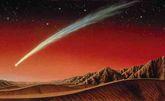
Comet ISON's visit to Earth was a bit of a disappointment – but next year Mars is getting a cometary visitor that looks like it will be anything but. Calculations suggest that the Red Planet's "comet of the century" will come closer to its surface than any comet has come to Earth's in recorded history – causing a meteor shower so epic that it may pose a danger to the spacecraft that orbit Mars.
Comet C/2013 A1, also known as comet Siding Spring after the observatory in New South Wales, Australia, where it was discovered, is due to cross Mars's orbit on 19 October 2014.
Early estimates of its path made it look as though the comet could smack into the Red Planet.
A more recent study rules out a collision – but only just – and raises the alarm for the fleet of orbiters overhead.
Comment: This is a nice reminder for all the cynics about why there has been such an effort to cry cometary wolf over the years... The Red Comet... Comet Siding Spring... is the one to watch...
-
Game ON! NASA Confirms New Smaller Version of Comet ISON: NASA Begins Search For What Is Left Of Comet ISON
NASA Science News, 4th December 2013
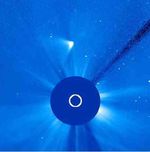 [...] Twelve NASA spacecraft and the International Space Station have observed and detected Comet ISON on its multi-million year journey from the Oort Cloud to the solar corona.
[...] Twelve NASA spacecraft and the International Space Station have observed and detected Comet ISON on its multi-million year journey from the Oort Cloud to the solar corona.
What NASA will be doing in the next days to clarify ISON's status:
- NASA will monitor the comet for the next several weeks. If there is nothing sizable and stable left, it will dissipate and disappear in this time, as already emitted dust leaves the vicinity. If there is still a central source of emission, even if it is very much smaller, we will see a new, much fainter coma and tail form, which currently may be overwhelmed by the dust emitted from before the disruption event.
- NASA's STEREO spacecraft will be using their cameras to search for bright fragments throughout the week, while the NASA Infrared Telescope Facility (IRTF) in Honolulu, Hawaii will use its 3m wide telescope to detect the comet spectroscopically, the same way it did on ISON's inbound journey. Radio telescopes around the world will also be able to tell us more about what has happened. NASA's recently launched MAVEN spacecraft may try to observe ISON next week. By mid- to late-December NASA's Hubble and Chandra observatories will be performing deep outer space searches for any remnants of the comet. Spitzer will also look for ISON in early 2014.
If a fragment that acts like a comet is detected, but at a much reduced level, it may be hard to see it from the Earth at the time of its closest approach on December 26, 2013.
Comment: This looks like NASA are being forced to admit that this comet survived perihelion and now poses a danger to Earth. The real concern is the size of the debris field that some claim is 40 million miles across plus the fact that Comet ISON has changed its original orbit. [In mid January 2014 Comet ISON will pass over Earth's North pole and I fully expect that some of the shattered comet that is trailing behind the remnant of Comet ISON will drop into Earth's atmosphere.] These facts alone explains why Russian astronomers made it known fairly immediately that Earth could get either a serious sprinkling of cosmic dust and/or unknown[?] sized meteors entering Earth's atmosphere.
-
Comet ISON Meteor Shower
NASA Science News, 19th April 2013
"For several days around January 12, 2014, Earth will pass through a stream of fine-grained debris from Comet ISON," says Wiegert. "The resulting shower could have some interesting properties."
Comment: After the break-up of Comet ISON, it is very likely that there is no longer just fine grains, hence the concern by Russian astronomers.
-
JamesMcCanneyScienceHour_December_05_2013.mp3
jmccanneyscience.com, 5th December 2013
Another useful radio show with information on comets in general with special reference to Comet ISON. [Info re Comet ISON attracting heavy elements in its tail (sodium and heavy metal) as it got close to the Sun's corona and then getting a new baked on nucleus of metal that will give this cosmic body [maybe it will become a moon] a magnetic field.
Video: Two comets to fly by Mercury November 18 and 19
EarthSky, 15th November 2013

On November 18, 2013, Comet Encke will pass within 0.025 AU of Mercury, followed a day later by Comet ISON at 0.24 AU (1 AU is the distance between the sun and Earth, 150 million km).
NASA's MESSENGER spacecraft, now orbiting Mercury, will turn away from the sun's innermost planet for a time and toward the passing comets. Astronomer Ron Vervack at the Johns Hopkins University Applied Physics Lab and a member of the science team for MESSENGER, called it:
… a unique coincidence and a golden opportunity to study two comets passing close to the sun.
Comment: I wonder if Earth's citizens will be allowed to see the close-up images of Comet ISON, especially now that it is in a seriously raging state.
Hubble sees asteroid spouting six comet-like tails
Phys.Org, 8th November 2013
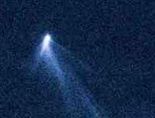
Phys.org) –Astronomers using NASA's Hubble Space Telescope have identified what they can only describe as a never-before-seen "weird and freakish object" in the asteroid belt that looks like a rotating lawn sprinkler.
Normal asteroids should appear simply as tiny points of light. But this asteroid, designated P/2013 P5, has six comet-like tails of dust radiating from it like spokes on a wheel.
Because nothing like this has ever been seen before, astronomers are scratching their heads to find an adequate explanation for its out-of-this-world appearance.
"We were literally dumbfounded when we saw it," said lead investigator David Jewitt of the University of California at Los Angeles. "Even more amazing, its tail structures change dramatically in just 13 days as it belches out dust. That also caught us by surprise. It's hard to believe we're looking at an asteroid."
Comment: We are back to the mechanistic mindset that wants to compartmentalize everything with strict definitions when the evidence is overwhelming that the universe generates variety on a continium. Charles Fort explained this nicely with the analogy that scientists like to define yellow and red, ignoring anything that is orange. Often orange will become defined when overwhelming evidence means reality can no longer be ignored. The scientific community make themselves look naive by moaning on about variation and failing to acknowledge this basic principal in the universe. James McCanney writes:
...oddly enough a small asteroid just went comet ... the pics are below from the Hubble space telescope ... astronomers cannot explain it but you all know it is my Plasma Discharge Comet Model in action ... astronomers admit that the asteroid is too hot to have water on the nucleus (so why do they also not admit that the hot dry rocks of comet nuclei cannot have water either ??? ) and anyway no water was observed ... the brightened 6 tails could not have been not due to their standard "an asteroid hit it" because it has 6 tails and what is the chance that 6 asteroids hit it all at the same time ??? zipppoooo ... clearly the asteroid went comet and the dust seen is coming INTO the comet (asteroid) ... Source: link
Newly Discovered 'Force Field' Shields a Colossal Cloud On Its Plunge into Milky Way's Center
Daily Galaxy News, 1st November, 2013
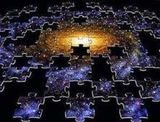
The Smith Cloud, a gigantic streamer of hydrogen gas that is on a collision course with the Milky Way Galaxy, is hurtling toward the Milky Way at more than 150 miles per second and is predicted to impact in approximately 30 million years. When it does, astronomers believe, it will set off a spectacular burst of star formation. But first, it has to survive careening through the halo, or atmosphere, of hot ionized gas surrounding the Milky Way. This discovery could help explain how so-called high velocity clouds (HVCs) remain mostly intact during their mergers with the disks of galaxies, where they would provide fresh fuel for a new generation of stars.
Comment: I think the evidence shows that sparks of consciousness exist to deliver change at all scales within our universe. The muttering about magnetic fields that keep this 'cloud' together, thus defying old obsolete ideas, is just a small admission that current cosmological theory is totally inadequate to explain what astronomers can observe in the universe.
Bolts Out of Thin Air
Thunderbolts, 31st October 2013
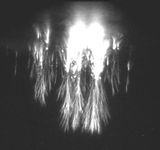
The discovery of 'mega-lightning', upper-atmospheric lightning or transient luminous events (TLEs) is relatively recent, due to the fleeting nature of these phenomena: most last no longer than a few milliseconds.
A menagerie of types – such as the playfully labelled 'sprites' and 'ELVES' – discharge energetically between the ionosphere and cloud cover, thus completing electrical circuits between the ionosphere and the earth's surface via ordinary lightning. [...]
A remarkable visual similarity joins sprites of all stripes, but especially the carrot, to the classic bilobate representation of the sacred 'thunderbolt' in ancient Mesopotamian and Neo-Hittite art, the Graeco-Roman world and India. In these cultures, the iconic symbol of the 'thunderbolt' is quite at odds with the familiar appearance of terrestrial lightning.
Comment: I just love Rens van der Sluijs's work integrating electric universe theory, modern day observations, ancient knowledge and mythology... Based on ancient depictions of sprites, we can presume that in the past, this atmospheric phenomena was much more prevalent. Today, the acknowledgement of transient luminous events after decades of denial, may be more solid proof it is related to the recent increase in energy levels on this planet.
A new mission designed to study the Sun's electrical relationship with Mars will soon be launched.
Thunderbolts News, 28th October 2013
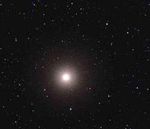
Sometime in the morning a few months from now, between November 18 and December 7, 2013, NASA will launch the Mars Atmosphere and Volatile Evolution Mission. Otherwise known as MAVEN, the project will investigate the upper atmosphere of Mars, the ionosphere, and the dynamics of solar wind interactions.
Onboard the spacecraft will be several instruments to monitor various phenomena that could provide valuable information to Electric Universe investigators:
Comment: Things are really changing quickly in our little solar system... I think fairly soon we are going to be told the atmosphere of Mars is now highly electrified... Maybe, NASA are already trying to work out how to spin the news...
Comet Linear Surprises Astronomers
Spaceweather.com, 27th October 2013
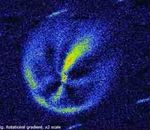 COMET LINEAR X1:
COMET LINEAR X1: The sun isn't the only thing exploding. Almost 450 million km from Earth, Comet C/2012 X1 (LINEAR) is having its own outburst. On Oct. 20th, amateur astronomers realized that the comet's brightness had increased 100-fold and its morphology resembled that of exploding Comet 17P/Holmes in 2007. Follow-up images in recent nights seem to show jet-like structures in Comet LINEAR X1's expanding atmosphere. Amateur astronomer Nick James of Chelmsford, UK, obtained these data on Oct. 26th:
Another set of images taken by James shows the comet's atmosphere or "coma" expanding over a period of two days. "The coma's diameter is increasing at a rate of 30 arcseconds per day," says James. "At a distance of 2.95 AU this corresponds to 65,000 km/day or a little less than 1 km/s." He made these observations using an 11-inch Celestron telescope.
Comment: Could astronomers be any more embarrassed than Comet Linear exploding at twice the distance of Jupiter from the Sun [2.95 AU]? This little dud, mysteriously acquired a huge amount of energy (from the solar wind?) and lit up... The image of the cometary jets by an amateur astronomer here is interesting.
Comet Linear Explodes
Spaceweather.com, 25th October 2013
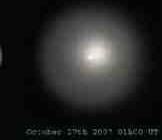 COMET EXPLOSION:
COMET EXPLOSION: Almost 450 million km from Earth, Comet C/2012 X1 (LINEAR) has exploded. Amateur astronomers are reporting a 100-fold increase in the comet's brightness compared to predictions, and the comet's atmosphere or "coma" now resembles that of exploding Comet 17P/Holmes in 2007. Using a remotely-controlled 0.5 meter telescope in New Mexico, European observers Ernesto Guido, Martino Nicolini and Nick Howes took this picture of the spherical explosion on Oct 21st:
"The predicted magnitude of the comet on Oct. 20th was about +14," says Guido. "Now it is close to +8.5." This is below the threshold for naked-eye visibility, but bright enough for backyard telescopes equipped with digital cameras.
Prompted by the reports of Guido et al, Romanian amateur astronomer Maximilian Teodorescu observed the comet on Oct. 22nd, confirming its brightness and spherical structure. "It looked exactly like Comet Holmes back in 2007," says Teodorescu.
Comment: Identical to Comet Holmes that exploded when a few planets lined up with the Sun and the electrical interaction caused an energy spike that destroyed the comet's capacitance. Comets are electric, talk about deep veins of ice evaporating that can be seen glowing from three hundred million miles away is just plain stupid... [McCanney says the comet is twice the distance of Jupiter away from the Sun and amount of sunlight is equivalent to a candle at 5 miles distance...] The need for denial is comical... See the Comet Holmes gallery at spaceweather.com. There is more info at the Best of the Blog archive for Comet Holmes.

NASA MAKES MARS CONFESSION
Spaceweather.com, 22nd October 2013
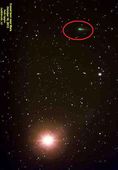 GREEN COMET, RED PLANET:
GREEN COMET, RED PLANET: Comet ISON, which will fly through the atmosphere of the sun on Nov. 28th, is now flying past the planet Mars. The green comet and the Red Planet are just 1o apart in the eastern sky before dawn. Parks Squyres photographed the odd couple from his private observatory in SaddleBrooke, Arizona, on Oct. 16th:
Mars is almost as bright as a 1st-magnitude star, easy to find in the constellation Leo near the blue star Regulus. The comet, on the other hand, is invisible to the unaided eye. Mid-sized backyard telescopes are required to see it.
"I used a Celestron 11-inch telescope," says Squyres. "The image is a stack of 80 15-second exposures."
The comet is green because its vaporizing nucleus emits diatomic carbon, C2, a gas which glows green in the near-vacuum of space. Mars is red because its rocky surface is widely rusted. The two colors make a heavenly ensemble. Amateur astronomers, if you have a GOTO telescope, enter these coordinates, and let the exposures begin.
Comment: So, we now have acknowledgement from NASA that Mars has also lit-up like a fairy light on a Christmas tree... That did not take long at all... MARS IS A PLANET NOT A STAR, SO WHY IS IT SHINING LIKE A 1ST MAGNITUDE STAR? THIS IS SHOCKING IF YOU CAN EXCUSE THE PUN... MCCANNEY WILL LOVE THIS CONFESSION...
Illuminating Earth's mysterious gamma ray flashes
ABC Net News, 18th October 2013
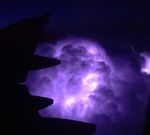
Electron avalanches could be generating some of the highest energy radiation bursts ever discovered on Earth.
The study in Geophysical Research Letters, suggests bursts known as terrestrial gamma ray flashes (TGF), are possibly produced by dark lightning generated by an avalanche of electrons. [...]
"In fact they're so bright, that they temporarily blind spacecraft."
The flashes were originally thought to be coming from the top of Earth's atmosphere, but spacecraft measurements and energy modelling show they're coming from altitudes below 20 kilometres.
"People now know they're coming from deeper down, from thunderstorms at about the same altitudes where aircraft fly," says Dwyer.
"We've been struggling to figure out how thunderstorms could generate these flashes."
Comment: Hmmm... Things are changing very quickly as the atmosphere becomes highly electrified. Check the archives, the last time there was a report it was only 500 TGFs a day around the world up from 50 per day. Now, we are being told one TGF blast per thunderstorm, the only problem with that is that NOAA claims there are as many as 40,000 thunderstorm occurrences each day world-wide. At the moment, I am struggling to believe that the scientists have got this right...
So, I am wondering if these blasts are being blamed as laser pen attacks on pilots and therefore they are not all being generated by delinquents with laser pens, see Laser pointer attacks on airplane pilots have jumped 1100% since 2005... We have the confession that they are blinding satellites but no confession that they are blinding pilots for obvious reasons... The comment "a half-dozen ways a thunderstorm can hurt you" is not generally elaborated upon in the media either...
New Data: Will Comet ISON Survive its Close Perihelion Passage?
Universe Today, 9th October 2013
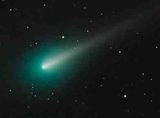
It's the question on every astronomer's mind this season, both backyard and professional: will Comet C/2012 S1 ISON survive perihelion?
Now, new studies released today at the American Astronomical Society's 45th Annual Division for Planetary Sciences meeting being held this week in Denver suggests that ISON may have the “right stuff” to make it through its close perihelion passage near the Sun. This is good news, as Comet ISON is expected to be the most active and put on its best showing post-perihelion… if it survives. [...]
Could we be in for a “surge” of activity from ISON coming from around November 20th on?
Comment: So astronomers think Comet ISON is going to kick off.... The info about Kreutz group sungrazers is useful, as one has has just appeared see above.
-
More ISON Craziness: Tales of Popes, a Prophet and a Comet
Universe Today, 19th September 2013
There's an astronomical tall tale from the Middle Ages that seems to get recycled as factual every time a “great” comet rolls around. This week, we thought we'd look at a story that just won't die, as well as a new twist in comet conspiracy that's rolling around ye' ole 'Net.
Comet [ISON] appears to glow green with poisonous gas.
Comet ISON surprises skywatchers as NASA tries to photograph it from Mars
Catholic Online, 2nd October 2013

Well, are you ready? After a year of breathless anticipation, skywatchers are prepared to receive the potential comet of the century next month as Comet ISON sails by Earth one it's first and last trip around the Sun
LOS ANGELES, CA (Catholic Online) - Astronomers have been watching Comet ISON closely as it approaches Mars this week, then continues in the general direction of Earth. When it was detected, now just over a year ago, astronomers originally predicted that its close brush with the Sun might cause it to brighten enough to rival the full moon. That prediction has been downgraded as the comet's brightness develops, but there are a number of other surprises that makes ISON worth paying attention to, including its color.
Backyard astronomers still have a couple weeks to wait before they can spot the icy comet, but professional and semi-professional astronomers with telescopes over 10 inches in diameter say they can already spot the fuzzy object near the planet Mars in the sky.
As of today, ISON is making its closest approach to the planet Mars and NASA astronomers are attempting to photograph the comet from the planet's surface and from orbit. If photographed, it would become the first comet ever imaged from the surface of another world.
Comment: Hmmmmm.... And this comet with a big coma of poisonous gas is doing a flying over of planet Earth in January.... Now, surprise surprise, Catholics are being vigilant and reporting the news.... if you are keeping the faith with this blog you will understand their keen interest.
-
Comet ISON Goes Green
Universe Today, 28th September 2013
As NASA and the European Space Agency prepare their remote photojournalists – Mars Express, Mars Reconnaissance Orbiter and the Curiosity and Opportunity rovers – to capture photos of Comet ISON's flyby of Mars early next week, amateur astronomers continue to monitor and photograph the comet from backyard observatories across the blue Earth. Several recent color photos show ISON's bright head or nucleus at the center of a puffy, green coma. Green's a good omen – a sign the comet's getting more active as it enters the realm of the inner solar system and sun's embrace.
Comment: The article focuses on explaining about the poisonous gases. The reminder of old advice about hiding from poisons in the air reminds me of the biblical Passover.... World powers will take this as a major sign... If you don't understand this I can't help you.
-
First HiRISE Images of Comet ISON
HiRise University of Arizona, 29th September 2013
-
MARS GOES COMET!!!!! (.MP3)
The Light of the Day Radio Show, 2nd October 2013
Comment: [6:52] Short .MP3 clip. James McCanney is wondering about the timing of the U.S. government shutdown... ALL the NASA ISON data is offline... This is a major astronomical event!!!!!! Listen to the McCanney latest radio show for more info...link
Comet ISON Goes Green
Universe Today, 28th September 2013
As NASA and the European Space Agency prepare their remote photojournalists – Mars Express, Mars Reconnaissance Orbiter and the Curiosity and Opportunity rovers – to capture photos of Comet ISON's flyby of Mars early next week, amateur astronomers continue to monitor and photograph the comet from backyard observatories across the blue Earth. Several recent color photos show ISON's bright head or nucleus at the center of a puffy, green coma. Green's a good omen – a sign the comet's getting more active as it enters the realm of the inner solar system and sun's embrace.
Comment: The article focuses on explaining about the poisonous gases. The reminder of old advice about hiding from poisons in the air reminds me of the biblical Passover.... World powers will take this as a major sign... If you don't understand this I can't help you.
First HiRISE Images of Comet ISON
HiRise University of Arizona, 29th September 2013
MARS GOES COMET!!!!! (.MP3)
The Light of the Day Radio Show, 2nd October 2013
Comment: [6:52] Short .MP3 clip. James McCanney is wondering about the timing of the U.S. government shutdown... ALL the NASA ISON data is offline... This is a major astronomical event!!!!!! Listen to the McCanney latest radio show for more info...link
Source of Space Weather, Northern Lights Found In Earth's Magnetic Field
Space.com, 26th September 2013
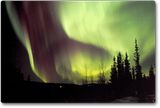 Scientists have discovered the powerhouse for the cosmic storms in Earth's magnetic field that fuel the planet's dazzling displays of northern lights.
The discovery could help scientists predict when stormy space weather could disrupt global power systems or expose astronauts to deadly radiation bursts, as well as add insight into the spectacular auroras over the Earth's polar regions. [...]
Scientists have discovered the powerhouse for the cosmic storms in Earth's magnetic field that fuel the planet's dazzling displays of northern lights.
The discovery could help scientists predict when stormy space weather could disrupt global power systems or expose astronauts to deadly radiation bursts, as well as add insight into the spectacular auroras over the Earth's polar regions. [...]
It turned out that, though Earth's magnetic field stretches thousands of miles, the energy from the solar wind was being stored in a fairly small part of the magnetic tail that stretches behind Earth's night side.
That stream of wind strengthens the magnetic field until it can't store any more energy, at which point it releases the energy in a violent burst, like a short-circuit, in the form of geomagnetic storms, said David Sibeck, a THEMIS project scientist and magnetospheric physicist who works at NASA Goddard Spaceflight Center, but was not involved in this study.
The results show that "even teeny tiny microphysics and very localized processes can have consequences for the whole environment of Earth," Sibeck told SPACE.com
Now that scientists know where these turbulent storms happen, the next step is trying to get a better picture of when they happen.
Comment: The article tells us nothing new but I think the exercise is raising awareness of space weather because there are millions and millions that just don't get the seriousness and why and how has space weather has changed the terms and conditions for humans living on planet Earth.
Everything you need to know about Comet ISON in 2013
Earth & Sky, 17th September 2013
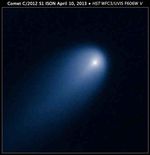 Comet C/2012 S1 (ISON) has been the most talked-about comet of 2013. When discovered in late 2012, it was said to have the potential to become a striking object visible to the eye alone around the time of its perihelion – or closest point to the sun – on November 28, 2013. People started saying Comet ISON and comet of the century in the same sentence. In June and July 2013, Comet ISON was behind the sun as seen from Earth, but when it was recovered in early August, it wasn't as bright as hoped. What will happen with Comet ISON in the remaining months of 2013? Comets are notoriously unpredictable, but it's safe to say that many are waiting to see if Comet ISON will sizzle … or fizzle.
Comet C/2012 S1 (ISON) has been the most talked-about comet of 2013. When discovered in late 2012, it was said to have the potential to become a striking object visible to the eye alone around the time of its perihelion – or closest point to the sun – on November 28, 2013. People started saying Comet ISON and comet of the century in the same sentence. In June and July 2013, Comet ISON was behind the sun as seen from Earth, but when it was recovered in early August, it wasn't as bright as hoped. What will happen with Comet ISON in the remaining months of 2013? Comets are notoriously unpredictable, but it's safe to say that many are waiting to see if Comet ISON will sizzle … or fizzle.
-
Is there a real threat from comet ison this fall?
Psychic Focus Sessions, 1st September 2013
Is there a real threat from comet ison this all?
A. It looks to me that, we do not get hit by a comet, but some debris around the comet makes it's way into our atmosphere. And it looks like it hits, either in, or really close to Greenlands, like the northern part of Greenland. And that is what causes, those huge chunks of ice to break apart, and then it starts this weather chain reaction. I see New York, and the Northern states above New York, hit with a lot of snow, almost blizzard like, and I keep flashing to that movie we watched, the one with all the snow at the station. The Day After Tomorrow. My mind just wants to focus on the snow in that movie. I keep seeing December with that also. Like we will see all that snow in December.
Comment: Updated: Since I think the woman at psychicfocus.blogspot is gifted and fairly sensible in how she reports her insights, I am interested in her opinion. Since she does not give a name, I have decided to call the 'The Focus lady'. She has no scientific training but I prefer a good savant that only descibes what the can see or intuit so that scientific and analytical skills can used to work out what is really going on. So, if you have been following Comet ISON news, then you will know that NASA scientists have already informed us that our atmosphere is going to be at least mildly polluted by Comet ISON (see link below) but of course, most people are not interested in this news that should set alarms bells ringing... Anyway, I am glad The Focus lady has made it clear 'The Red Comet' is not Comet ISON because 'The Red Comet' is Comet 2013 A1 (Siding Spring) and that is VERY VERY RED COMET see archives for a VATT image and info. Well, what is interesting is the rising number of people in the blogosphere reporting their dreams of what appears to be some sort of major tsunami disaster, but the suspected locations mostly in the United States vary... I am actually not convinced at all about Arctic ice breaking up but I have spent relatively very little time studying rising sea levels (or lack) and melting Arctic ice (or not). This is standard fare over at various climate skeptic blogs such as Watts Up With That... Meanwhile, world experts are adamant that the Arctic icecap is going to disappear, but a catastrophic event with huge chunks breaking up at once seems like sheer fantasy... In terms of science, some force has to be applied to cause the breakup and I think they already exist... There are already constant reports of booming and "sky noises" in the atmosphere which suggests that Earth is already processing/releasing tremendous amounts of energy... Then there are Terrestrial Gamma Ray Flashes (TGFs, extreme black hole energies that nobody can explain why this energy is being released in the Earth's atmosphere above the clouds... read the archives, we have now gone from 50 blasts to 500 blasts a day all over the planet and if you are flying too close when a blast goes off, you are going to get fried with excessive radiation... that is official. Still, is there such a thing as a tipping point? What new state of affairs can we expect? Actually, one extreme is the so-called "magnetic reconnection" blasts in the atmosphere and airbursts over an entire continent like the one that ended the Clovis culture in the United States circa 13,000 years ago.... Theoretically, I suppose it is feasible that some kind of electromagnetic interaction could cause a chain reaction but I don't know (I don't know if anyone knows) what could cause a catastrophic icecap breakup and I have never come across a historical precedent. Whatever, we will not have long to find out if this is true but the Focus lady was wrong with trying to give dates for the start of The Red Comet interferring with electronics; she does not even know its official name or that it has not arrived into the inner solar system yet... Whatever, Pope Benedict XVI warned us in Feb 2013 that “The time of testing is here”.... Since it is clear Vatican astronomers have been keenly watching out for certain cosmic objects and recently apologised for the calendars being wrong (why now?) we can only presume that they are expecting trouble... Btw, I think there is an historic precedent for big comets triggering massive geophysical upheavals and I think the geophysical rumblings around the New Madrid Fault and talk of a new ocean basins and the United States being split is still geophysically on the cards, see The New Madrid Earthquakes of 1811-12.
-
Comet ISON Meteor Shower
NASA Science News, 19th April 2013 Flashback!
 April 19, 2013: Anticipation is building as Comet ISON plunges into the inner solar system for a close encounter with the sun in November 2013. Blasted at point-blank range by solar radiation, the sungrazer will likely become one of the finest comets in many years.
April 19, 2013: Anticipation is building as Comet ISON plunges into the inner solar system for a close encounter with the sun in November 2013. Blasted at point-blank range by solar radiation, the sungrazer will likely become one of the finest comets in many years.
When NASA's Swift spacecraft observed the comet in January 2013, it was still near the orbit of Jupiter, but already very active. More than 112,000 pounds of dust were spewing from the comet's nucleus every minute.
It turns out, some of that dust might end up on Earth.
Veteran meteor researcher Paul Wiegert of the University of Western Ontario has been using a computer to model the trajectory of dust ejected by Comet ISON, and his findings suggest that an unusual meteor shower could be in the offing.
"For several days around January 12, 2014, Earth will pass through a stream of fine-grained debris from Comet ISON," says Wiegert. "The resulting shower could have some interesting properties. [...]
While the dust is “up there,” it could produce noctilucent clouds (NLCs).
Roundtable - Man's Genesis & The Future Direction of Humanity
Red Ice Radio, 6th September 2013
 Robert Schoch (Geologist, Geophysicist, Author), Robert Bauval (Egyptologist, Author) Marie D Jones (Author, Researcher), Laird Scranton (Author, Researcher, Cosmologist), Micah Hanks (Author, Researcher, Futurist), Scotty Roberts (Author, Researcher, Publisher) and John Ward (Archaeologist) come together for a special roundtable. In the first hour, we discuss human civilizations of the past including their knowledge of natural cycles, messages within mythology, paralleling ancient mysteries and various human fossils. What can we learn from the past and what is our place in the universe? In the second hour, we go deeper to discuss the future direction of humanity and the current modern view of being separate from the natural world. Can a modern society, highly dependent on technology, integrate into the natural world? We'll discuss the modern notion of "progress" and how future technology may end humanity as we know it. Schoch reminds us that in the past, big extinctions have followed after a civilization has reached the peak of their evolution. We end on the idea of outside assistance both in the past and in the present.
Robert Schoch (Geologist, Geophysicist, Author), Robert Bauval (Egyptologist, Author) Marie D Jones (Author, Researcher), Laird Scranton (Author, Researcher, Cosmologist), Micah Hanks (Author, Researcher, Futurist), Scotty Roberts (Author, Researcher, Publisher) and John Ward (Archaeologist) come together for a special roundtable. In the first hour, we discuss human civilizations of the past including their knowledge of natural cycles, messages within mythology, paralleling ancient mysteries and various human fossils. What can we learn from the past and what is our place in the universe? In the second hour, we go deeper to discuss the future direction of humanity and the current modern view of being separate from the natural world. Can a modern society, highly dependent on technology, integrate into the natural world? We'll discuss the modern notion of "progress" and how future technology may end humanity as we know it. Schoch reminds us that in the past, big extinctions have followed after a civilization has reached the peak of their evolution. We end on the idea of outside assistance both in the past and in the present.
Comment: I could not resist commentating on this roundtable discussion for Red Ice members only. I have great respect for Henrik Palmgren at Red Ice Creations. In my opinion he is very bright with the ability to integrate huge amounts of information and
come up with valid conclusions. In my opinion, solid Tier II. It is obvious to me that he realises humanity is sleepwalking to destruction and I sensed urgency at the start of this roundtable that I felt was not really
related to the conference that was being touted. The first hour was not very good as there was too much pretentiousness about being 'priviledged' researchers, but the second half warmed up a bit when the discussion focused on the eradication of previous human species (hominids) and civilisations on this planet. We actually got some useful insights and intelligent comment, but the highlight for me was when someone mentioned the frustration of being part of a dumbed-down society. Henrik summed this up as the idiocracy scenario and stated clearly that we have to consider who exactly would be fit for evolution... [Hour 2, 35.40] Yes, that is right, someone half-suggested we are ripe for extinction because overall we are too stupid to be eligible for evolution and we are more likely to go extinct. Micah Hanks actually gave a nicer and more eloquent argument for various scenarios that included nature wiping us out. Ding dong! Actually, I think the real opinion amongst the group was that we risked erradicating ourselves due to our dependence on technology and in reality, only those tribes living close to the Earth would survive..... Well, have you seen the Fukushima news lately? The latest about the proposed 2020 Tokyo olympics being at the same time as the scheduled removal of melted reactor cores is totally insane... AFP: Fears that Fukushima melted reactor cores have “eaten through” concrete of containment vessels – Tepco plan claims fuel to be removed at same time as 2020 Olympics in Tokyo & Endless Fukushima catastrophe: 2020 Olympics under contamination threat. The reports are now all about the Fukushima situation being completely out of control and no chance of recovering the situation because it is too late.... Endless Fukushima catastrophe: Many generations' health at stake & Analysis: Prepare for Fukushima's economic consequences, worst may be yet to come – Pay close attention to latest scientific data from plant, it could become even more tragic – Examine impact on rest of world. I am sure that many intelligentsia privately realise that societal support for psychopathic behaviour that often just looks like sheer idiocy will ensure the demise of humanity. The group of Oxford scholars pointing out the likelihood of our demise are among the few prepared to voice an opinion, see This is the end: Team of experts say humanity faces extinction. Well, for visionaries, the problem of the psychopathic idiocracy is very apparent, but quite frankly, it is something that has to be accepted and effort is required to insulate yourself against the worse of semi-humankind (savages). Personally, I don't think there is any solutions (besides knowing how the lowlife operate) and the solution is the problem will be dealt with by universal consciousness... Now that I have found the supporting scientific analysis, that I can combine with astrotheology, I am enlightened and feel somewhat relieved... I just wish I had been banged on the head 10 years ago and awoke to realise the impossible scenario of there being too many dumbed-down people... There is not much hope in the short term, but in the long term (a few hundred years), if there is no major natural disaster, the sperm count crisis will ensure a fresh start for humanity.
Move over Comet ISON. A new Comet Lovejoy has arrived
Weather Underground, 11th September 2013
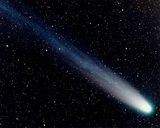 Australian amateur astronomer Terry Lovejoy has discovered a new comet. The new Comet Lovejoy will occupy the same part of the sky as Comet ISON by November 2013.
Australian amateur astronomer Terry Lovejoy has discovered a new comet. The new Comet Lovejoy will occupy the same part of the sky as Comet ISON by November 2013.
Many are anticipating the brightening of Comet ISON, which is now in Earth's predawn sky, not far from the bright planets Jupiter and Mars, but too faint to see without telescopes and/or photographic equipment. [...]
The new comet has been formally labeled as C/2013 R1 Lovejoy. Terry Lovejoy apparently used a relatively small 8-inch (20 cm) Schmidt-Cassegrain reflecting telescope to photograph the new comet for two nights, as this faint object was located on the sky's dome in front of the border between our constellations Orion and Monoceros.
Comment: Of course, the crazy cult hype has started to confuse those who are easy to dupe... I think this is a case of ignoring any source that is already known as a hoaxer especially the idiots who hyped up Comet Elenin.
-
Is Comet ISON a UFO? Hubble's scientists do a reality check
NBC News, 6th September 2013
-
JamesMcCanneyScienceHour_September_05_2013.mp3
jmccanneyscience.com, 5th September 2013
Comment: I have no idea about the Comet ISON - Mercury encounter (mid November) that McCanney talks about here because that has nothing to do with the expected encounter with the Sun in late November when we might get a major flare... I suppose the issue is the timing of the electrical link between Comet ISON and the Sun.... This might be a lot earlier than the timing of its closest approach.... Anyway, I simply can't agree with everything McCanney says because he sometimes generalises too much and my research over the years related to space weather provides more details... For example, McCanney does not know that the United States is about to start manufacturing its own cheaper transformers – common sense under the circumstances – he never mentions that the United States military have already confessed that they will be crippled too by an EMP strike. He also fails to correct the misunderstanding of a July 2013 Carrington level CME that actually missed Earth by a week in July 2012... I only promote McCanney because he was right over 30 years ago about comets being electric and he has published research papers to prove it. He also cares about how people will survive if we get hit by another cosmic conflagration that we must realise have wiped out previous civilisations on this planet. McCanney is often way ahead of the curve and that is the primary reason I have great respect for him and his work.
-
NASA to Launch BRRISON to Edge of Atmosphere to View ISON Comet [Video]
Guardian Express, 16th August 2013
A Change Is in the (Interstellar) Wind
Science Magazine News, 5th September 2013
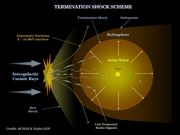 As Earth and the other planets orbit the sun, the solar system itself travels through space. Its slow journey is taking it though a wispy expanse of gas called the Local Interstellar Cloud. Now, astronomers have discovered signs of potential turbulence in the cloud, indicated by a shift in direction of helium atoms that flow into the solar system. If the shift is real and continues for hundreds to thousands of years–a dicey extrapolation–it could be a harbinger of more dramatic changes in our solar system, notes study co-author David McComas of the Southwest Research Institute in San Antonio.
As Earth and the other planets orbit the sun, the solar system itself travels through space. Its slow journey is taking it though a wispy expanse of gas called the Local Interstellar Cloud. Now, astronomers have discovered signs of potential turbulence in the cloud, indicated by a shift in direction of helium atoms that flow into the solar system. If the shift is real and continues for hundreds to thousands of years–a dicey extrapolation–it could be a harbinger of more dramatic changes in our solar system, notes study co-author David McComas of the Southwest Research Institute in San Antonio.
The finding, which McComas, Priscilla Frisch of the University of Chicago, and their colleagues report in the 6 September issue of Science, could foreshadow a change in the heliosphere, the vast bubble that shields the solar system from harmful cosmic rays. The heliosphere consists of charged particles blown out by the sun in the so-called solar wind. The size and shape of the heliosphere depends on the balance between the outward push of the solar wind and the inward pressure from gas in the Local Interstellar Cloud–the interstellar wind.
Comment: This change has been taking place for decades... Whatever, this is a major deal for the citizens of this planet as the cosmic environment will continue to become more hostile. For most, it will slowly become more obvious as electronics continue to become more unreliable and our modern technological world is forced to cope with the cosmic challenges. See the Joyfire intersellar 'etheric' cloud index for more background info and click the image icon for a larger image.
No Images of Comet ISON from Deep Impact/EPOXI Spacecraft Due to Communication Loss
Universe Today, 4th September 2013
Obviously, the Deep Impact probe got too close and was "zapped" by the highly electrical Comet ISON as other reports state it is now spinning out of control... This is something that has happened before when various space probes have got too close to highly electrical comets.... the best example was Comet Tempel 1 that also knocked out the same Deep Impact probe in July 2005. I am sure Electric Universe theorists are laughing to themselves again over this latest repeat...
Scientists baffled to discover that Venus' spin is slowing down
Tallbroke's Talkshop, 2nd September 2013
NASA's new mission to study what makes the moon glow
MSN News, 23rd August 2013
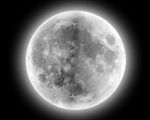 NASA's new LADEE orbiter could be described as a space-age vacuum cleaner, designed to suck up the fine lunar debris that shrouds the moon at high altitudes. [...]
NASA's new LADEE orbiter could be described as a space-age vacuum cleaner, designed to suck up the fine lunar debris that shrouds the moon at high altitudes. [...]
Unlike Earth, the moon is not protected by a strong magnetic field, nor does it have a thick atmosphere. This creates a "charged space weather environment" in which nighttime and daytime sides of the moon react very differently with dust due to the presence of light photons "slamming" into the surface and knocking electrons off atoms.
"That means the surface dust can get positively charged," Day said. "Imagine dust particles sitting on the surface of the moon, getting this positive charge as they start to repel each other, and lifting up."
As for why the moon is so dusty in the first place, look at its cratered surface. That's the result of billions of years of bombardment from comets and meteorites spreading bits of pulverized rock about the lunar surface.
Comment: This reminds me of the Stardust Mission where dust was collected on the edge of our solar system and delivered by to Earth... NASA already knows what makes the moon glow, see Electric Moon Jolts the Solar Wind, so I think this mission is about something else. Possibly, this is just monitoring progress as our whole solar system continues to charge up and become more electrified, new lessons need to be learnt and quickly. For people new to this blog, huge amounts of information about space climate change weather and the impact in our solar system are provided on my websites. Update: Presumably, the "dust fountains" are dust confined by strong magnetic fields and flowing in electric currents. Embarrassed NASA scientists don't want to point out the obvious, when they have been denying for decades that the cosmos is primarily ruled by electromagnetic forces and not gravity. Based on the principle of the charge to mass ration, planets are mostly influenced by gravity, but sub-atomic particles (plasma) and nano-sized dust particles are influenced by the electromagnetic force and that is why plasma cosmologists have been so successful in predicting and modelling what we see happening in the heavens. On a practical level, as our solar system charges up, we will see some severe electrical discharges when big comets interact with the biggest planets. When that happens, all doubts that we live in an electromagnetic universe will dissipate.
Black Hole Analogue Discovered in South Atlantic Ocean
Vortices in the South Atlantic are mathematically equivalent to black holes, say physicists, an idea that could lead to new ways of understanding how currents transport oil and garbage across
Technology Review, 19th August 2013
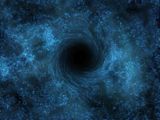 [...] Today, George Haller at the Swiss Federal Institute of Technology in Zürich and Francisco Beron-Vera at the University of Miami in Florida have found another analogue of a black hole, this time in the world of turbulence. [...]
[...] Today, George Haller at the Swiss Federal Institute of Technology in Zürich and Francisco Beron-Vera at the University of Miami in Florida have found another analogue of a black hole, this time in the world of turbulence. [...]
Haller and Beron-Vera put this similarity on a formal footing by describing the behaviour of vortices in turbulent fluids using the same mathematics that describe black holes. [...]
Haller and Beron-Vera go on to show that each vortex boundary in a turbulent fluid contains a singularity, just like an astrophysical black hole.
Comment: Hmmm.... Doesn't the use of the same mathematics that describe black holes and vortices in turbulent fluids imply that space is also a type of fluid? As we know, space can be a violent and turbulent place... but like black holes in space, vortices in oceans do not swallow everything in sight... So, unpopular heretics have been debunking popular black hole ideas for many years, see The Myth of the Black Hole. In a visible universe that is 99.999% plasma, I am sticking with MECO theory.
Most powerful magnetic field in universe that is 20 trillion times stronger than a fridge magnet
The strongest magnetic field in the universe has potentially been discovered – a dead star that packs the equivalent mass of our sun into an area just 12 miles across.
Telegraph, 15th August 2013
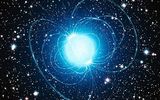 The former star, which has the catchy name SGR 0418+5729, is 6,500 light years from Earth and was initially thought to have an unusually low magnetic field.
New observations using the European Space Agency's XMM Newton Space Telescope have, however, revealed that it may be the strongest magnetic source in the known universe.
The former star, which has the catchy name SGR 0418+5729, is 6,500 light years from Earth and was initially thought to have an unusually low magnetic field.
New observations using the European Space Agency's XMM Newton Space Telescope have, however, revealed that it may be the strongest magnetic source in the known universe.
Astronomers estimate that it produces a magnetic field around 20 trillion times stronger than a standard refrigerator door magnet.
The dead star is a kind of neutron star called a magnetar – the dead core of a once massive star that has collapsed in on itself.
Comment: Oh goodness me! Are we being told a weak star has turned into a magnetar overnight? Well, that completely screws the existing theory! Sorry you will have to do your own research on this one or buy my Electrotechnics of the Heavens e-book for why this astronomical announcement has hit the mainstream media.
A gas cloud is sweeping past the Milky Way's central black hole
Earth Sky, 17th July 2013
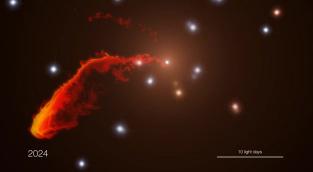 In 2011, astronomers in Germany announced the discovery of a cloud of gas – with several times the mass of the Earth – accelerating fast towards the supermassive black hole at the center of our Milky Way. They originally said that the cloud would pass closest to the black hole in mid-2013, but a new analysis suggests the date of closest passage as early 2014. The passage of the gas cloud near the black hole is already underway, and numerous observing programs have been set up to monitor the region around the Milky Way's center during 2013.
In 2011, astronomers in Germany announced the discovery of a cloud of gas – with several times the mass of the Earth – accelerating fast towards the supermassive black hole at the center of our Milky Way. They originally said that the cloud would pass closest to the black hole in mid-2013, but a new analysis suggests the date of closest passage as early 2014. The passage of the gas cloud near the black hole is already underway, and numerous observing programs have been set up to monitor the region around the Milky Way's center during 2013.
In April 2013, data acquired at the European Southern Observatory (ESO) showed that part of the gas cloud has already passed closest to the black hole. As expected, the cloud is undergoing what astronomers sometimes call spaghettification – or the noodle effect. That is, it's being stretched or elongated as it passes the hole, due to the hole's powerful gravity. [...]
Bottom line: Since 2011, astronomers have been following a gas cloud that is sweeping near the supermassive black hole at the center of our Milky Way galaxy. The gas cloud is becoming increasingly elongated, and different parts of the cloud are moving at different speeds. The main part of the cloud is now expected to come closest to the black hole in early 2014. The gas cloud is not expected to survive its encounter with the black hole.
Comment: Spaghettification.... the use of the term is truly cringeworthy from a plasma cosmology viewpoint.... Besides that, this is a major update of what is taking place at the centre of our galaxy, but no mention of the galactic centre lighting up in x-rays and radio waves thus providing some galactic fireworks for astronomers to watch...
Astronomer finds new moon orbiting Neptune
Reuters, 15th July 2013
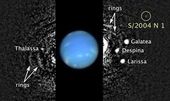 An astronomer studying archived images of Neptune taken by the Hubble Space Telescope has found a 14th moon orbiting the planet, NASA said on Monday. Estimated to be about 12 miles in diameter, the moon is located about 65,400 miles from Neptune.
An astronomer studying archived images of Neptune taken by the Hubble Space Telescope has found a 14th moon orbiting the planet, NASA said on Monday. Estimated to be about 12 miles in diameter, the moon is located about 65,400 miles from Neptune.
Comment: Neptune has captured a new moon... There is certainly a lot happening in the solar system, see The Joyfire Tour Solar System Transformation
Fixed It for Ya
Thunderbolts.info, 1st July 2013
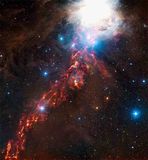
Fixed It for Ya The following press release from the European Southern Observatory has been corrected to reflect the discovery that 99.99% of the universe is composed of plasma.
This dramatic new image of cosmic clouds a plasma discharge in the constellation of Orion reveals what seems to be a fiery ribbon in the sky. This orange glow represents faint light coming from grains of cold interstellar dust, at wavelengths too long for human eyes to see. It was observed by the ESO-operated Atacama Pathfinder Experiment (APEX) in Chile.
Clouds of gas and interstellarPlasma in a gaseous state along with charged dust and the galactic-scale electric currents that shape them are the raw materials from which stars stellar plasmoids are made. But these tiny dust grains block our view of what lies within and behind the clouds dusty plasma – at least at visible wavelengths – making it difficult to observe the processes of star formation stellar discharge.
This is why astronomers need to use instruments that are able to see at other wavelengths of light. At submillimetre wavelengths, rather than blocking light, the dust grains shine due to their temperatures of being heated to a few tens of degrees above absolute zero from their slight resistance to the galactic current.
Comment: This is a typical example of how Electric Universe theorists have to re-write the story for the general public using plasma cosmology that takes into account that the visible universe is 99.999% plasma. Many conventional astronomers and cosmologists struggle to make sense of the universe because they refuse to acknowledge the existence of the most powerful and universal force in the cosmos, electromagnetism. As I wrote in my TTD book: Why would the universe use gravity when electricity is much more efficient?
How Did a Third Radiation Belt Appear in the Earth's Upper Atmosphere?
Science Daily, 20th June 2013
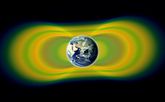 Since the discovery of the Van Allen radiation belts in in Earth's upper atmosphere in 1958, space scientists have believed that these belts consisted of two doughnut-shaped rings of highly charged particles -- an inner ring of high-energy electrons and energetic positive ions, and an outer ring of high-energy electrons.
Since the discovery of the Van Allen radiation belts in in Earth's upper atmosphere in 1958, space scientists have believed that these belts consisted of two doughnut-shaped rings of highly charged particles -- an inner ring of high-energy electrons and energetic positive ions, and an outer ring of high-energy electrons.
However, in February of this year, a team of scientists reported in the journal Science the surprising discovery of a previously unknown third radiation ring. This narrow ring had briefly circled Earth between the inner and outer rings in September 2012 and then almost completely disappeared.
Comment: This article carefully tells you as little as possible... Well, temporary radiation belts have been created by exploding nuclear bombs in the atmosphere and presumably something similar happened as there is vague talk of measuring the scattering of high energy relativistic electrons... Well, I think this might have been an example of what some scientists call a magnetic reconnection event but on a massive scale.... Scientists like to talk about magnetic lines of force that cross, cancel, and reconnect releasing magnetic energy in the form of heat and charged-particle kinetic energy, but plasma physicists think this is rubbish and we are really talking about electric currents because magnetic field lines don't exist right.... they are only like contour lines on a map.... So, in plain English, if electric currents merge huge amounts of energy are released.... If this were to happen low enough down in our atmosphere, we would get a repeat of what some scientists believed to be comet explosions that changed Earth's climate sufficiently to end the Clovis culture in North America about 13,000 years ago..... Note the date is about half a precessional cycle.... Tick tock... If you want to get really frightened, I recommend the book Magnetic Reversals and Evolutionary Leaps by Robert Felix where he points out the geological evidence that these blasts would actually create fireballs in the sky similar to those seen when military deliberately exploded nuclear bombs in the atmosphere just for the sake of it... This book radically changed my perspective on what could happen on this planet, but we must remember we are already getting huge mega blasts in our atmosphere that our scientists call Terrestrial Gamma Ray Flashes.... the mystery booms might not just be exploding meteors either, see archives for previous comments... Our planet is now experiencing a range of high energy atmospheric phenomena and that is because in the last 25 years, there has been a huge surge of energy from the cosmos that will force rapid evolutionary change.
-
NASA's Magnetospheric Mission Passes Major Milestone
PhysOrg.com, 6th September 2010
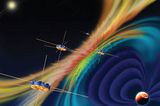 The universe is still an arcane place that scientists know very little about, but a new NASA Solar Terrestrial Probe mission is going to shed light on one especially mysterious event called magnetic reconnection. It occurs when magnetic lines of force cross, cancel, and reconnect releasing magnetic energy in the form of heat and charged-particle kinetic energy.[...]
The universe is still an arcane place that scientists know very little about, but a new NASA Solar Terrestrial Probe mission is going to shed light on one especially mysterious event called magnetic reconnection. It occurs when magnetic lines of force cross, cancel, and reconnect releasing magnetic energy in the form of heat and charged-particle kinetic energy.[...]
In 2014, NASA is scheduled to launch a satellite that will greatly increase our understanding of this phenomenon when it launches the Magnetospheric Multiscale (MMS) mission, a suite of four identical spacecraft that will study magnetic reconnection in the best possible laboratory - the Earth's magnetosphere. The spacecraft will obtain measurements necessary to test prevailing theories as to how reconnection is enabled and how it progresses. [...]
-
Article 4 : “No” to Magnetic Reconnection and “Yes” to Electrified Plasma
Thunderbolts.info, 24th December 2011
Electrical engineers and plasma cosmologists have been known to say that magnetic reconnection is one of the stupidest theoretical ideas that researchers ever derived from the mistaken belief that there are no significant electric currents in space. Yes, the mathematics can be made to fit – though with increasing difficulty as observations proceed – with the energy needs involved, but it should be remembered that processes of physics are not explained by such equations. However, in the case of “magnetic reconnection” there is a much deeper difficulty than that. I refer to the inconvenient truth that the lines of force of a magnetic field do not physically exist at all! They are only a mental aid for us to conceptualise the shape and intensity of a magnetic field.
Stellar Winds May Electrify Exoplanets
Space Daily, 6th June 2013
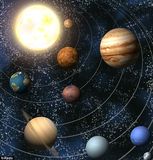 The strangest class of exoplanets found to date might be even stranger than astronomers have thought. A new model suggests that they are partially heated by electric currents linked to their host stars. Florida Gulf Coast University (FGCU) astronomer Dr. Derek Buzasi has proposed a model in which electric currents arising from the interaction between the planet's magnetic field and the hot charged wind from the star flow through the interior of the planet, heating it like an electric toaster.
The strangest class of exoplanets found to date might be even stranger than astronomers have thought. A new model suggests that they are partially heated by electric currents linked to their host stars. Florida Gulf Coast University (FGCU) astronomer Dr. Derek Buzasi has proposed a model in which electric currents arising from the interaction between the planet's magnetic field and the hot charged wind from the star flow through the interior of the planet, heating it like an electric toaster.
Comment: Another acknowledgement by cosmologists that unsolved problems maybe be tackled by considering the electromagnetic properties of cosmic objects that exist in an electromagnetic universe. What is interesting is that the induced heating caused by a fluctuating solar wind being compared to the same effect as an electric toaster is actually acknowledged for Earth. So cosmologists dare to mention it, but climate scientists have ignored this completely.... As I have already pointed out, a few scientists already think Earth's magnetic index helps us to understand what exactly is going on with global temperature trends.
ABC comets rise from the dead
ABC News, 21st May 2013
 Astronomers have found a group of comets that have risen from the dead.
Astronomers have found a group of comets that have risen from the dead.
The asteroidal belt comets - or ABCs for short - lie in the main asteroid belt between Mars and Jupiter, report astronomers on the on the pre press website ArXiv.org.
Dr Ignacio Ferrin, Dr Jorge Zuluaga and Pablo Cuartas from Columbia's University of Antioquia, say the group of eleven objects behave like comets, but have asteroidal orbits.
They propose the objects they've dubbed 'Lazarus comets' are extinct comets that have been rejuvenated when their orbits changed.
"The asteroidal belt contains an enormous graveyard of ancient dormant and extinct rocky comets, that [are rejuvenated], in response to a diminution of their perihelion distance [closest orbital position to the Sun]," the authors write.
Comment: This is exactly what NASA scientists claimed they were looking for, see press release from last week. This news really does bring to mind the ancient warnings.... I would describe this news as omninous...
How Electric Spacecraft Could Fly NASA to Mars
Space.com, 17th May 2013
 Electric vehicles aren't just popular on the ground – it turns out they're all the rage in space these days, too. While still not as common as traditional chemical spacecraft engines, electric engines are growing in popularity for both Earth-orbiting satellites and scientific spacecraft on missions to deep space. And electric engines could turn out to be a key element in NASA's goal of sending people to Mars, experts say.
Electric vehicles aren't just popular on the ground – it turns out they're all the rage in space these days, too. While still not as common as traditional chemical spacecraft engines, electric engines are growing in popularity for both Earth-orbiting satellites and scientific spacecraft on missions to deep space. And electric engines could turn out to be a key element in NASA's goal of sending people to Mars, experts say.
"The maturity of the various technologies that make up electric propulsion is getting there," said Vlad Hruby, president of the Busek spacecraft engine company. Hruby said he's been waiting for a renaissance in electric spacecraft for about 20 years. "Now it's finally coming to fruition."
Comment: Another reminder we live in an electromagnetic universe and the truth of this is now impossible to ignore as the near Earth environment is getting much more electrified these days.... The image icon came from an 2011 article: NASA picks five companies to study solar electric spacecraft propulsion.
Herschel finds hot gas[plasma] on the menu for Milky Way's black hole
The space observatory has made detailed observations of hot molecular gas that may be orbiting or falling toward the supermassive black hole lurking at the center of our galaxy.
Astronomy News, 7th May 2013
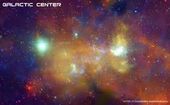 The European Space Agency's (ESA) Herschel Space Observatory has made detailed observations of surprisingly hot molecular gas that may be orbiting or falling toward the supermassive black hole lurking at the center of our Milky Way Galaxy.
The European Space Agency's (ESA) Herschel Space Observatory has made detailed observations of surprisingly hot molecular gas that may be orbiting or falling toward the supermassive black hole lurking at the center of our Milky Way Galaxy.
Our local black hole is located in a region known as Sagittarius A* – Sgr A* – after a nearby radio source. It has a mass about 4 million times that of our Sun and lies around 26,000 light-years away from the solar system. [...]
“The observations are also consistent with streamers of hot gas speeding towards Sgr A*, falling towards the very center of the galaxy,” said Goicoechea. “Our galaxy's black hole may be cooking its dinner right in front of Herschel's eyes.”
Just before material falls into a black hole, it is heated up enormously and can cause high-energy X-ray and gamma-ray flares. While Sgr A* currently shows little sign of such activity, this could change soon.
Using near-infrared observations, other astronomers have spotted a separate, compact cloud of gas amounting to just a few Earth masses spiraling toward the black hole. Located much closer to the black hole than the reservoir of material studied by Herschel in this work, it may finally be gobbled up later this year.
Comment: I read three or four versions and they all make the same misleading statements. Sagittarius A* is a region of space considered to be the galactic centre but it is filled with MILLIONS of stars with something that scientists are embarrassed to announce is our galaxy's "feeble" black hole (read my previous comments and links to the embarrassing info at Best of the Blog - Space & Cosmology). Scientists prefer to fudge the facts to sex-up our galaxy's black hole and this is achieved because this region has some humonguous active stars that emit huge amounts of radio waves. We were told in December 2011 to expect some action at the galactic centre in mid 2013, but we are still waiting... see more below.
-
ESO Astronomers are expecting Cosmic Fireworks from our Galactic Center in 2013!
Supermassive black hole will 'eat' gas cloud
BBC News, 14th December 2011
 Researchers have spotted a giant gas cloud spiralling into the supermassive black hole at our galaxy's centre. Though it is known that black holes draw in nearby material, it will be the first chance to see one consume such a cloud.
Researchers have spotted a giant gas cloud spiralling into the supermassive black hole at our galaxy's centre. Though it is known that black holes draw in nearby material, it will be the first chance to see one consume such a cloud.
As it is torn apart, the turbulent area around the black hole will become unusually bright, giving astronomers a chance to learn more about it. An article in Nature suggests the spectacle should be visible in 2013. [...]
Researchers using the European Southern Observatory's Very Large Telescope estimate that despite its size, the cloud has a total mass of only about three times that of Earth.
They have plotted the cloud's squashed, oval-shaped path and estimate it has doubled its speed in the last seven years - to 2,350km per second.
It should spiral in to within about 40 billion kilometres of the black hole in the middle of 2013.
Our local supermassive black hole, dubbed Sagittarius A*, lies about 27,000 light-years away, and has a mass about four million times that of our Sun.
-
Gas Cloud En Route To Milky Way's Black Hole [VIDEO]
Red Orbit, 15th December 2011
"Scientists say that by 2013, outbursts of X-rays and radio waves will be emitted as the cloud gets hotter and is obliterated by the black hole. The cloud is mostly made up of hydrogen and helium gas.
[ Video 1 ] | [ Video 2 ] | [ Video 3 ] |
Fermi and Swift see 'shockingly bright' burst
Phys.Org News, 3rd May 2013
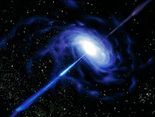 A record-setting blast of gamma rays from a dying star in a distant galaxy has wowed astronomers around the world. The eruption, which is classified as a gamma-ray burst, or GRB, and designated GRB 130427A, produced the highest-energy light ever detected from such an event.
A record-setting blast of gamma rays from a dying star in a distant galaxy has wowed astronomers around the world. The eruption, which is classified as a gamma-ray burst, or GRB, and designated GRB 130427A, produced the highest-energy light ever detected from such an event.
"We have waited a long time for a gamma-ray burst this shockingly, eye-wateringly bright," said Julie McEnery, project scientist for the Fermi Gamma-ray Space Telescope at NASA's Goddard Space Flight Center in Greenbelt, Md. "The GRB lasted so long that a record number of telescopes on the ground were able to catch it while space-based observations were still ongoing."
Just after 3:47 a.m. EDT on Saturday, April 27, Fermi's Gamma-ray Burst Monitor (GBM) triggered on eruption of high-energy light in the constellation Leo. The burst occurred as NASA's Swift satellite was slewing between targets, which delayed its Burst Alert Telescope's detection by a few seconds.
Fermi's Large Area Telescope (LAT) recorded one gamma ray with an energy of at least 94 billion electron volts (GeV), or some 35 billion times the energy of visible light, and about three times greater than the LAT's previous record. The GeV emission from the burst lasted for hours, and it remained detectable by the LAT for the better part of a day, setting a new record for the longest gamma-ray emission from a GRB.
Comment: Thus is almost like deja-vu.... The number of these ultra bright flashes is now really starting to stack up and I am waiting for an astronomer with a decent hypothesis for why this is happening but I have declared my opinion quite some time ago in my writings.
Undergraduate Student Discovers How To Tell Time On Saturn
Nature World News, 3rd May 2013
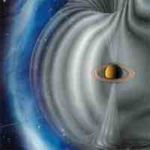 Time on Saturn has proved to be a fickle beast for scientists to pin down because of the thick layers of clouds and liquid gases rotate at their own speeds around the planet.
Time on Saturn has proved to be a fickle beast for scientists to pin down because of the thick layers of clouds and liquid gases rotate at their own speeds around the planet.
Decades ago, a strong and naturally occurring radio signal called the Saturn Kilometric Radiation (SKR) was thought to provide an accurate measurement of a Saturn day. But data gathered since then has rebuffed the idea.
But Tim Kennelly, a junior majoring in physics and astronomy at the University of Iowa, has made a significant observation about a process occurring Saturns's magnetosphere that is linked to the planet's seasons and changes with them. The find provides the breakthrough astronomers needed to accurately determine how time passes on Saturn and could also change our understanding of the magnetosphere on Earth.
Comment: I read a few of these articles on this discovery and this is the most straight forward. Obviously, this student was not brainwashed enough by the process of "education" and so managed to think outside the box... I think this article exemplifies how plasma cosmology is starting to dominate the way many space scientists can scientifically understand the complexity of the cosmos. Now that there are enough spacecraft in our solar system sending back data, the implications of the so-called vacuum being actually filled with plasma (sub-atomic particles) and that plasma being strongly influenced by electromagnetic forces can no longer be denied. These "flux tubes" are in effect MASSIVE electrical currents that are over a million amps (a flux tube that links the moon Io to Juipiter is about 4 million amps). The discussion of seasonal changes implies that there is a flux of charge but the article does not give any hints of what is causing the flux.
-
'Tis the season–for plasma changes at Saturn
Phys.Org News, 3rd May 2013
(Phys.org) –A University of Iowa undergraduate student has discovered that a process occurring in Saturn's magnetosphere is linked to the planet's seasons and changes with them, a finding that helps clarify the length of a Saturn day and could alter our understanding of the Earth's magnetosphere.
Saturn's magnetosphere is the third largest structure in the solar system, eclipsed only by the magnetic fields of the sun and Jupiter. Unlike Earth, which has a visible rocky surface and rotates once every 24 hours, Saturn is composed mostly of clouds and liquid gas layers, each rotating about the planet at its own rate of speed. This variation in rotation made it difficult for scientists to pin down time for the planet.
NASA Probe Gets Close-Up Views of Large Hurricane on Saturn
NASA JPL News, 26th April 2013
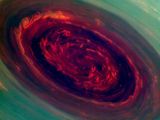 PASADENA, Calif. - NASA's Cassini spacecraft has provided scientists the first close-up, visible-light views of a behemoth hurricane swirling around Saturn's north pole.
PASADENA, Calif. - NASA's Cassini spacecraft has provided scientists the first close-up, visible-light views of a behemoth hurricane swirling around Saturn's north pole.
In high-resolution pictures and video, scientists see the hurricane's eye is about 1,250 miles (2,000 kilometers) wide, 20 times larger than the average hurricane eye on Earth. Thin, bright clouds at the outer edge of the hurricane are traveling 330 mph(150 meters per second). The hurricane swirls inside a large, mysterious, six-sided weather pattern known as the hexagon.
"We did a double take when we saw this vortex because it looks so much like a hurricane on Earth," said Andrew Ingersoll, a Cassini imaging team member at the California Institute of Technology in Pasadena. "But there it is at Saturn, on a much larger scale, and it is somehow getting by on the small amounts of water vapor in Saturn's hydrogen atmosphere."
Comment: I can't understand the surprise... the electromagnetic force and how it interacts with matter appears to be the same all over the universe....
Comet ISON Meteor Shower
NASA Science News, 19th April 2013
 April 19, 2013: Anticipation is building as Comet ISON plunges into the inner solar system for a close encounter with the sun in November 2013. Blasted at point-blank range by solar radiation, the sungrazer will likely become one of the finest comets in many years.
April 19, 2013: Anticipation is building as Comet ISON plunges into the inner solar system for a close encounter with the sun in November 2013. Blasted at point-blank range by solar radiation, the sungrazer will likely become one of the finest comets in many years.
When NASA's Swift spacecraft observed the comet in January 2013, it was still near the orbit of Jupiter, but already very active. More than 112,000 pounds of dust were spewing from the comet's nucleus every minute.
It turns out, some of that dust might end up on Earth.
Veteran meteor researcher Paul Wiegert of the University of Western Ontario has been using a computer to model the trajectory of dust ejected by Comet ISON, and his findings suggest that an unusual meteor shower could be in the offing.
"For several days around January 12, 2014, Earth will pass through a stream of fine-grained debris from Comet ISON," says Wiegert. "The resulting shower could have some interesting properties. [...]
While the dust is “up there,” it could produce noctilucent clouds (NLCs).
Comment: OMG! NASA scientists are giving some credence to James McCanney's claim about what we could happen with the Comet ISON passover! It seems, that we now need some serious focus by astronomers to provide the spectrum analysis of what chemicals are in the comet tail to see whether we should expect a major pollution event... See below:
-
Comet C/2012 S1 (ISON): JamesMcCanneyScienceHour_October_04_2012 (MP3)
James McCanney Science Hour, 4th October 2012 Flashback!

Comment: This is classic James McCanney where we are given a basic introduction to what is happening with Comet C/2012 S1 (ISON) and what he expects to happen and why there may be some severe space weather events THIS YEAR. He expects to see major cometary interactions with the gas planets of Jupiter, and Mars and then more interactions with Mercury... Nothing is absolutely certain, but it is very likely the citizens of planet Earth are going to witness major celestial fireworks of biblical proportions in the heavens.
-
Comet C/2012 S1 (ISON): JamesMcCanneyScienceHour_November_08_2012.mp3
James McCanney Science Hour, 8th November 2012
Flashback!

Comment: Only the first 23 minutes of this show is dedicated to talking about Comet C/2012 S1 (ISON) but we get a detailed description of 'The Red Hand of Death'. McCanney does not mention the comet 'Wormwood' in the show on the 4th October & 8th November 2012, but over the years worth of shows that I have listened to in the past, he has talked about a comet known to the Catholic Church that has polluted the Earth's waters in our ancient past and made them 'bitter'. Here is some introductory information from a short article with some science (chemistry) that is not too difficult to understand, so it is strongly recommended that the whole article is read especially for those readers who doubt the seriousness of what can happen when large comets come near to Earth... Simply, the analogy of a biblical Passover is not fanciful.
In the First Century AD, the Apostle John wrote an apocalyptic book called "Revelation" in which he described among many "end-time" events the collision of a star called Wormwood with Earth. Revelation states:
Rev. 8:10-11: The third angel sounded his trumpet, and a great star, blazing like a torch, fell from the sky on a third of the rivers and on the springs of water-- the name of the star is Wormwood. A third of the waters turned bitter, and many people died from the waters that had become bitter.
Wormwood is a botanical herb commonly known for its bitterness. See Botanical.com. It was used as a pesticide, medicinal tonic and liqueur ingredient. The term "wormwood" was often used to describe "extreme bitterness".
Let us consider the possibility of a "star" turning the waters bitter on Earth. The term "star" in classical terminology lacks the modern astronomical sense. It could have been referring to a comet, asteroid, "sun-like" star or planet. Since the possibility of a planet or sun colliding with earth is infinitesimal, we will eliminate this possibility.
Scientific Scenario Of A Comet's Impact And The "Wormwood Star" Prophecy by Marshall Beeber, Messianic Literary Corner.
Ignore the "heat shock" that is talk for infants. A comet nucleus does not need to be anywhere near Earth because comet tails can be thought of as electrical bare "wires" across space. What's more, NASA has measured these 'tails' to stretch for half a billion miles. So, it is the electrical interactions of these comet tails in our atmosphere that will cause chemical reactions in our atmosphere. For reasons that I will not disclose, I think a lot more people need to be aware that things may become very chaotic on this planet in the new future. You don't need to believe me but James McCanney has been preparing his audience for a very long time so that people will be able to better cope in any catacylsmic event. Despite the disinformation campaigns that target James McCanney, I have great respect. This is a man who actually cares about people.
-
JamesMcCanneyScienceHour_November_15_2012.mp3
James McCanney Science Hour, 15th November 2012 Flashback!

Comment: James McCanney continues talking about Comet C/2012 S1 (ISON) and more about 'The Red Hand of Death' and The Passover event detailed in The Bible (00.00 - 04:45 & 35.50 - 59.00) . Here, it is worth pointing out that some of the mythologising about 'the gods' make a lot more sense when we realise that astronomer-priests sought to preserve the stories of what happened when monster comets come into our solar system and cause havoc as they interact with the major planets of Saturn and Jupiter and then fling the end products on us on Earth... Due to the scientific merit, some mythologists are also now re-interpretating myths in terms of highly electrical plasma manifestations being seen in the heavens.
-
Will Comet ISON light up the night sky in late 2013?
Space News, 20th February 2013
 [...] Just how brightly Comet ISON will shine this year is currently up for debate between planetary scientists and comet-watchers. However, the general consensus is that ISON will hopefully be the brightest comet anyone alive has ever seen. Current predictions suggest that it will skim the Sun, approaching it at a distance within 1.1 million miles at the end of November 2013. It is here that ISON could reach, or even exceed, the brightness of the full Moon meaning that it will be visible to the naked eye quite easily.
[...] Just how brightly Comet ISON will shine this year is currently up for debate between planetary scientists and comet-watchers. However, the general consensus is that ISON will hopefully be the brightest comet anyone alive has ever seen. Current predictions suggest that it will skim the Sun, approaching it at a distance within 1.1 million miles at the end of November 2013. It is here that ISON could reach, or even exceed, the brightness of the full Moon meaning that it will be visible to the naked eye quite easily.
[...] Observers all over the world will be able to see ISON with everyone in the Northern Hemisphere getting a great view in the run-up to Christmas and into January passing directly over the north pole. In January 2014, astronomers predict that the comet will approach to within 37.2 million miles of Earth.
Blazar Markarian 421's flare-up is cosmic coincidence
BBC News, 16th April 2013
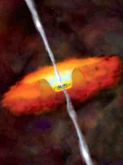 The skies are currently being flooded with the brightest display of gamma rays - the Universe's highest-energy light - ever seen by astronomers. The culprit is a staggering flare-up of Markarian 421, a "blazar" that hosts a supermassive black hole.
The skies are currently being flooded with the brightest display of gamma rays - the Universe's highest-energy light - ever seen by astronomers. The culprit is a staggering flare-up of Markarian 421, a "blazar" that hosts a supermassive black hole.
By sheer coincidence, a programme to study it had just begun, so dozens of the world's telescopes - from visible to radio to gamma-ray - were watching. And it came just in time for a meeting of many of the world's astrophysicists. [...]
Markarian 421 was already in the known catalogue of blazars, being somewhat variable and having had something of a brightening, or flare, in 1996. But the one that began late last week was unprecedented in the history of observations.
"I'm in shock and awe at how bright it is," said Julie McEnery, project scientist for the Fermi gamma-ray telescope. "This thing is blowing us away," she told BBC News.
Comment: More off the scale cosmic blasts. More: MAGIC and VERITAS detect an unprecedented flaring activity from Mrk 421 in very high energy gamma-rays. Thanks to S. Ferguson for the tip.
Exploding giant star sent longest gamma-ray blast, astronomers say - latimes.com
L.A. Times, 16th April 2013
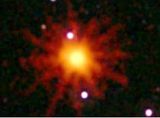 The most powerful stellar explosion since the big bang has been linked to a newly discovered class of ultra-long gamma ray burst, astronomers said Tuesday at the 2013 Huntsville Gamma-Ray Burst Symposium in Nashville, Tenn.
The most powerful stellar explosion since the big bang has been linked to a newly discovered class of ultra-long gamma ray burst, astronomers said Tuesday at the 2013 Huntsville Gamma-Ray Burst Symposium in Nashville, Tenn.
"We really think we've found this new class of gamma-ray bursts and a natural explanation for creating them in a type of star collapse that we haven't previously talked about," said Andrew Levan, an astronomer at the University of Warwick in Coventry, England, who led a study on the phenomena. [...]
Up until now, scientists have classified gamma-ray bursts as short (typically less than two seconds) and long (typically 20 to 50 seconds, with some lasting up to a few minutes). NASA's Swift satellite, launched in 2004, swivels around when it detects some high-energy activity to catch these fleeting events before their light disappears.
But these strange ultra-long bursts that Swift has documented in the last few years can last hours -- 100 times longer than those stellar flashes in the pan, said Bruce Gendre of the French National Center for Scientific Research.
Swift picked up the first such burst, GRB 101225A, on Christmas Day 2010. It baffled astronomers who guessed that the strange, long-lasting signal was either coming from a comet or asteroid falling onto a neutron star, or a neutron star falling onto a larger companion star.
Comment: Oh dear.... we have had so many reports of record-breaking bursts of energy hitting our planet that I have concluded that this is a side effect of the change in the properties of spacetime... It's like the fog clearing and being able to see for miles and miles or being able to feel the warmth of the sun when the clouds clear... With these huge blasts from very distant stars, it is like we receiving energy that we could not detect before.... Maybe I am wrong, but that is what I think is going on...
Collision Course? A Comet Heads for Mars
NASA Science News, 27th March 2013
 "There is a small but non-negligible chance that Comet 2013 A1 will strike Mars next year in October of 2014," says Don Yeomans of NASA's Near-Earth Object Program at JPL. "Current solutions put the odds of impact at 1 in 2000."
"There is a small but non-negligible chance that Comet 2013 A1 will strike Mars next year in October of 2014," says Don Yeomans of NASA's Near-Earth Object Program at JPL. "Current solutions put the odds of impact at 1 in 2000."
The nucleus of the comet is probably 1 to 3 km in diameter, and it is coming in fast, around 56 km/s (125,000 mph). "It if does hit Mars, it would deliver as much energy as 35 million megatons of TNT," estimates Yeomans.
For comparison, the asteroid strike that ended the dinosaurs on Earth 65 million years ago was about three times as powerful, 100 million megatons. Another point of comparison is the meteor that exploded over Chelyabinsk, Russia, in February of 2013, damaging buildings and knocking people down. The Mars comet is packing 80 million times more energy than that relatively puny asteroid. [...]
Even a near miss is a potentially big event. The latest orbit solutions put the comet somewhere within 300,000 km of the red planet at closest approach. That means Mars could find itself inside the comet's gassy, dusty atmosphere or "coma." Visually, the comet would reach 0th magnitude, that is, a few times brighter than a 1st magnitude star, as seen from the Red Planet.
Comment: The MARS - Comet 2013 A1 encounter will be an historic event regards of whether there is a direct hit because it is expected that the electrical discharges electrical discharges between these two cosmic bodies are going to be phenomenal and they will be seen on Earth. We will be seeing the thunderbolts of the Gods in real-time.
-
Comet Ison C/2012 S1 WTF Nasa?
YouTube, 27th March 2013
In this video, I show the data, latest images and videos, explain why Comet C/2012 S1 ISON is special, ask Nasa a question and make a special request.
Comment: Wicked but funny, profanity warning....
Comet Pan-STARSS Survives Solar Encounter, Emerges Brighter Than Ever
Red Orbit, 17th March 2013
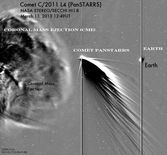 A comet making its first visit to the inner solar system has survived a journey that brought it close to the sun, and has emerged as one of the brightest comets in years, NASA astronomers confirmed on Friday.
A comet making its first visit to the inner solar system has survived a journey that brought it close to the sun, and has emerged as one of the brightest comets in years, NASA astronomers confirmed on Friday.
Comet Pan-STARRS, which according to the Daily Mail has been visible for several weeks in the Southern Hemisphere, could be viewed for the first time by stargazers in the northern parts of the world last week after dipping within the orbit of Mercury.
According to NASA, at its closest approach, Pan-STARRS was only 28 million miles away from the sun. Experts were unsure whether or not it would be able to survive such near proximity, with heat levels exceeding 10 times that felt here on Earth. The strong solar heat could have caused long-frozen gases in the comet's nucleus to vaporize, causing the comet itself to break up or be completely destroyed.
Not only did Comet Pan-STARRS survive, but it has emerged as “a gorgeous comet – one of the brightest in years,” Matthew Knight, an astronomer with the Lowell Observatory in Flagstaff, Arizona, said in a statement. NASA reported on Friday the solar heating from its approach has caused the comet to glow brighter than a first magnitude star, making it easily visible using binoculars and small telescopes during the first hour or two after sunset.
[...]
After processing images of the comet obtained by one of NASA's Solar Terrestrial Relations Observatory (STEREO) probes, Battams said, "The fine-structure is breathtaking. We think this is caused by some fairly complex interaction between the solar wind and the comet's rotating nucleus. It's going to take computer models to figure this one out."
Comment: I Imagine that some solar watchers are breathing a sigh of relief that the big CME blast associated with the passing of Comet Pan-STARRS did not cause a major space weather induced geomagnetic event on Earth.
-
Comet Pan-STARSS Break-Up or Something Else?
Spaceweather.com, 17th March 2013
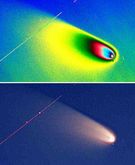 IS COMET PAN-STARRS FRAGMENTING? Veteran astrophotographer Peter Rosen has been monitoring Comet Pan-STARRS, and his latest images obtained on March 15th seem to show a fragment emerging from the nucleus. It is the speck just below and to the right of the comet's head:
IS COMET PAN-STARRS FRAGMENTING? Veteran astrophotographer Peter Rosen has been monitoring Comet Pan-STARRS, and his latest images obtained on March 15th seem to show a fragment emerging from the nucleus. It is the speck just below and to the right of the comet's head:
"It is visible also in two or three other image stacks," says Rosen. He notes how the stars in the image are trailed, but the apparent fragment is not. "It seems to follow the comet, not the stars. A plane passed through the field of view during the exposure, making a red streak through the comet's tail."
"The colorful image is a frequency modulation that increases the contrast and clearly shows the fragment as a dark
dot below the nucleus," he continues. "I hope this splitting can be confirmed or refuted soon by other observers."
-
JamesMcCanney Science Hour, February_21_2013.mp3
James McCanney talks about Comet PanStarrs [23:00 - 32:00]but as usual he talks about all sorts of other stuff plus details of the release of his latest e-book with all the sheenanigans.
CME, Comet and Planet Earth
NASA APOD, 15th March 2013
 Explanation: After appearing in a popular photo opportunity with a young crescent Moon near sunset, naked-eye Comet PanSTARRS continues to rise in northern hemisphere skies. But this remarkable interplanetary perspective from March 13, finds the comet posing with our fair planet itself - as seen from the STEREO Behind spacecraft. Following in Earth's orbit, the spacecraft is nearly opposite the Sun and looks back toward the comet and Earth, with the Sun just off the left side of the frame. At the left an enormous coronal mass ejection (CME) is erupting from a solar active region. Of course, CME, comet, and planet Earth are all at different distances from the spacecraft. (The comet is closest.) The processed digital image is the difference between two consecutive frames from the spacecraft's SECCHI Heliospheric Imager, causing the strong shadowing effect for objects that move between frames. Objects that are too bright create the sharp vertical lines. The processing reveals complicated feather-like structures in Comet PanSTARRS's extensive dust tail
Explanation: After appearing in a popular photo opportunity with a young crescent Moon near sunset, naked-eye Comet PanSTARRS continues to rise in northern hemisphere skies. But this remarkable interplanetary perspective from March 13, finds the comet posing with our fair planet itself - as seen from the STEREO Behind spacecraft. Following in Earth's orbit, the spacecraft is nearly opposite the Sun and looks back toward the comet and Earth, with the Sun just off the left side of the frame. At the left an enormous coronal mass ejection (CME) is erupting from a solar active region. Of course, CME, comet, and planet Earth are all at different distances from the spacecraft. (The comet is closest.) The processed digital image is the difference between two consecutive frames from the spacecraft's SECCHI Heliospheric Imager, causing the strong shadowing effect for objects that move between frames. Objects that are too bright create the sharp vertical lines. The processing reveals complicated feather-like structures in Comet PanSTARRS's extensive dust tail
Comment: This image is almost unbelievable... look at the 'feathers' on the comet tail... I think we have some evidence that a huge solar eruption was prompted by the close encounter of Comet Panstarrs.... Which does not bode well for the arrival of Comet ISON which is a much bigger comet and the likelihood of a massive solar eruption that could be similarly directed at Earth. Quote: "Recent findings about comets call for a new perspective on these bodies. The more we have learned about comets, the more the discoveries support an electrical interpretation. Highly energetic and focused jets explode from comets' nuclei. ", The Electric Comet This is a short article that serves as a tutorial by Wallace Thornhill and David Talbott, on the electrical nature of comets. See the archives for more links and online books on this same subject, Best of the Blog - Space & Cosmology.
Rare 'Zodiacal Light' will be visible in night sky soon
The Extinction Protocol, 8th March 2013
 [...] Most stargazers are unaware that they can actually see this interplanetary dust, when conditions are right. In some ways this disk of interplanetary dust is similar in appearance to the Milky Way. The glow of the Milky Way is the result of the combined light of millions of stars too faint to be resolved by the unaided eye. The interplanetary dust disk, called the Zodiacal Light, is the result of millions of dust particles too faint to be resolved. Unlike the Milky Way, which can be resolved with a telescope, the particles that make up the Zodiacal Light are too small to be resolved by any optical instrument. There are only a few windows of opportunity during the year to see the Zodiacal Light, and one of these is coming up over the next couple of weeks.
[...] Most stargazers are unaware that they can actually see this interplanetary dust, when conditions are right. In some ways this disk of interplanetary dust is similar in appearance to the Milky Way. The glow of the Milky Way is the result of the combined light of millions of stars too faint to be resolved by the unaided eye. The interplanetary dust disk, called the Zodiacal Light, is the result of millions of dust particles too faint to be resolved. Unlike the Milky Way, which can be resolved with a telescope, the particles that make up the Zodiacal Light are too small to be resolved by any optical instrument. There are only a few windows of opportunity during the year to see the Zodiacal Light, and one of these is coming up over the next couple of weeks.
Comment: This was originally from Space.com link. I think the real issue is the high levels of cosmic dust flooding our solar system, (not just from passing asteroids and comets). This assertion is based on all the press releases from space agencies in the last decade or so and the news that this dust is the cause of ever increasing reports of glowing electrified noctilucent clouds.
Comet to Make Close Flyby of Red Planet in October 2014
NASA Science News, 5th March 2013
 Comet 2013 A1 (Siding Spring) will make a very close approach to Mars in October 2014.
Comet 2013 A1 (Siding Spring) will make a very close approach to Mars in October 2014.
The latest trajectory of comet 2013 A1 (Siding Spring) generated by the Near-Earth Object Program Office at NASA's Jet Propulsion Laboratory in Pasadena, Calif., indicates the comet will pass within 186,000 miles (300,000 kilometers) of Mars and there is a strong possibility that it might pass much closer. The NEO Program Office's current estimate based on observations through March 1, 2013, has it passing about 31,000 miles (50,000 kilometers) from the Red Planet's surface. That distance is about two-and-a-half times that of the orbit of outermost moon, Deimos.
Scientists generated the trajectory for comet Siding Spring based on the data obtained by observations since October 2012.
Comment: I am sure this comet was spotted a lot longer than just two months ago... The Red Dragon was expected due to the preservation of ancient knowledge passed down over millenia to make sure our modern astronomer-priests knew that it would return, please see archives for previous reports and comments.
UK to invest in world's biggest telescope
FT.com, 3rd March 2013
 Britain will play a leading role in building and operating the world's biggest eye on the sky, the European Extremely Large Telescope in Chile, following a government decision to invest £88m in the €1.1bn project.
Britain will play a leading role in building and operating the world's biggest eye on the sky, the European Extremely Large Telescope in Chile, following a government decision to invest £88m in the €1.1bn project.
With its 39m mirror, the monster E-ELT may provide the first direct images of planets orbiting distant stars and indicate whether any of them host life, through the presence in their atmosphere of oxygen and organic chemicals associated with biological processes. Until now, all planets beyond our solar system have been detected using indirect methods.
Comment: See archives for more info on why astronomers are quickly building large new telescopes and watching the southern hemisphere and especially the galactic centre.
Van Allen Probes Discover a New Radiation Belt
NASA Science News, 28th February 2013
 Feb. 28, 2013: Earth's radiation belts were one of the first discoveries of the Space Age. A new finding published in today's issue of Science shows that we still have much to learn about them. NASA's twin Van Allen Probes, launched just last August, have revealed a previously unknown third radiation belt around Earth.
"Even 55 years after their discovery, Earth's radiation belts still are capable of surprising us," said Nicky Fox, Van Allen Probes deputy project scientist at the Johns Hopkins University Applied Physics Laboratory in Laurel, Md. "We thought we knew the radiation belts, but we don't."
Feb. 28, 2013: Earth's radiation belts were one of the first discoveries of the Space Age. A new finding published in today's issue of Science shows that we still have much to learn about them. NASA's twin Van Allen Probes, launched just last August, have revealed a previously unknown third radiation belt around Earth.
"Even 55 years after their discovery, Earth's radiation belts still are capable of surprising us," said Nicky Fox, Van Allen Probes deputy project scientist at the Johns Hopkins University Applied Physics Laboratory in Laurel, Md. "We thought we knew the radiation belts, but we don't."
Comment: Hmmm.... the gap between the original inner and outer belts was supposed to be the 'safe zone' for satellites and is the reason why NASA and the satellite communication industry are focusing a lot of attention on what is happening in the radiation belts. According to RT news this was a BIG surprise.... see NASA probe detects third radiation belt around Earth and I am sure not sure because this might really be a fourth belt because in 1991, anomalous cosmic rays (ACRs) were discovered trapped inside a belt that was close to the inner belt. The paper The new radiation belt of the earth from trapped anomalous cosmic rays, is dated from 1996. I think the real story is why new belts are forming and why it is such a problem for the satellite communication industry.
Comet C/2013 A1 (Siding Spring): Could a Comet Hit Mars in 2014?
Discovery News, 25th February 2013
 A recently discovered comet will make an uncomfortably-close planetary flyby next year – but this time it's not Earth that's in the cosmic crosshairs.
A recently discovered comet will make an uncomfortably-close planetary flyby next year – but this time it's not Earth that's in the cosmic crosshairs.
According to preliminary orbital prediction models, comet C/2013 A1 will buzz Mars on Oct. 19, 2014. The icy interloper is thought to originate from the Oort Cloud – a hypothetical region surrounding the solar system containing countless billions of cometary nuclei that were outcast from the primordial solar system billions of years ago. [...]
C/2013 A1 was discovered by ace comet-hunter Robert McNaught at the Siding Spring Observatory in New South Wales, Australia, on Jan. 3. When the discovery was made, astronomers at the Catalina Sky Survey in Arizona looked back over their observations to find “prerecovery” images of the comet dating back to Dec. 8, 2012. These observations placed the orbital trajectory of comet C/2013 A1 through Mars orbit on Oct. 19, 2014.
Could the Red Planet be in for a potentially huge impact next year? Will Mars rovers Curiosity and Opportunity be in danger of becoming scrap metal? [..]
According to calculations by NASA's Jet Propulsion Laboratory (JPL), close approach data suggests the comet is most likely to make a close pass of 0.0007 AU (that's approximately 63,000 miles from the Martian surface). However, there's one huge caveat.
Due to uncertainties in the observations – the comet has only been observed for 74 days (so far), so it's difficult for astronomers to forecast the comet's precise location in 20 months time – comet C/2013 A1 may fly past at a very safe distance of 0.008 AU (650,000 miles). But to the other extreme, its orbital pass could put Mars directly in its path. At time of Mars close approach (or impact), the comet will be barreling along at a breakneck speed of 35 miles per second (126,000 miles per hour).
Comment: This is madness... comet C/2013 A1 is yet another comet and it is big! I am not even sure this comes under the category of space weather, because this is more like star wars... See comments below...
-
Comet C/2013 A1 (Siding Spring) – a possible collision with Mars
Space Observatory, 25th February 2013
 There is a chance that the comet C/2013 A1 (Siding Spring), discovered in the beginning of 2013, might collide with Mars. At the moment, based on the observation arc of 74 days, the nominal close approach distance between the red planet and the comet might be as little as 0.00073 AU, that is approximately 109,200 km! [...]
There is a chance that the comet C/2013 A1 (Siding Spring), discovered in the beginning of 2013, might collide with Mars. At the moment, based on the observation arc of 74 days, the nominal close approach distance between the red planet and the comet might be as little as 0.00073 AU, that is approximately 109,200 km! [...]
Since C/2013 A1 is a hyperbolic comet and moves in a retrograde orbit, its velocity with respect to the planet will be very high, approximately 56 km/s. With the current estimate of the absolute magnitude of the nucleus M2 = 10.3, which might indicate the diameter up to 50 km, the energy of impact might reach the equivalent of staggering 2×10¹º megatonnes! This kind of event can leave a crater 500 km across and 2 km deep. Such an event would overshadow even the famous bombardment of Jupiter by the disintegrated comet Shoemaker–Levy 9 in July 1994, which by some estimates was originally 15 km in diameter. [...]
The current orbit uncertainty allows for a collision scenario, but the possibility of this is small. Astronomers keep watching this interesting comet, and I will keep you up to date with the news.
Comment: Thankfully we have the opinion of a real astronomer Leonid Elenin who is actually working with the Russian International Scientific Optical Network (ISON), which interestingly discovered comet ISON. It seems the discussion has been going on for quite some time, see Ian Musgrave's Astroblog 2nd Feb 2013, Will Comet C/2013 A1 (Siding Spring) Hit Mars?.
-
BREAKING NEWS – Mars to be hit by massive comet! 40 billion nuke bomb size explosion! CONFIRMED!
Investment Watch Blog, 26th February 2013
 The core of the comet will be moving 56 kilometers per sec when it smashes into Mars. The explosion it creates will be equal to 40 BILLION 500kt nuclear bombs (avg US and Russ arsenal weapon) going off at once, or 20 billion megatons of TNT, or 1.33 trillion Hiroshima bombs, or 1.3 billion Castle Bravo explosions. Its enough to kill all life on the planet if any were living there.
The core of the comet will be moving 56 kilometers per sec when it smashes into Mars. The explosion it creates will be equal to 40 BILLION 500kt nuclear bombs (avg US and Russ arsenal weapon) going off at once, or 20 billion megatons of TNT, or 1.33 trillion Hiroshima bombs, or 1.3 billion Castle Bravo explosions. Its enough to kill all life on the planet if any were living there.
Astronomers predict a large-scale disaster on the Red Planet in October 2014, when a comet may ram into Mars, creating a 500-kilometer crater, the website of the Russian observatory ISON-NM said. Pravda Source:
Link
Comet core 30 miles across
collision speed 35 miles per second (126,000 miles per hour)
It may make Mars temporarily as bright as the sun. The crater left behind will be 500 kilometers across. A lot of rock will be ejected into space and become stray asteroids. This will be an epic event.
Comment: At the moment Pravda is not a scientific institution and cannot confirm anything of this level of seriousness that would affect the future of the inhabitants of planet Earth. This is knee jerk sensationalist re-reporting of news from the infamous Russian Pravda media outlet, (I can't access the article so maybe the story has been removed).
-
Mars Meteorites
NASA JPL, February 2013
 Of the 24,000 or so meteorites that have been discovered on Earth, only 34 have been identified as originating from the planet Mars. These rare meteorites created a stir throughout the world when NASA announced in August 1996 that evidence of microfossils may be present in one of these Mars meteorites. The meteorites in the table below are grouped by their pairings and listed roughly in the order that they were found.
Of the 24,000 or so meteorites that have been discovered on Earth, only 34 have been identified as originating from the planet Mars. These rare meteorites created a stir throughout the world when NASA announced in August 1996 that evidence of microfossils may be present in one of these Mars meteorites. The meteorites in the table below are grouped by their pairings and listed roughly in the order that they were found.
Comment: Hmmm... If this meteor hits Mars, there could be a whole lot more asteroids coming our way... Whatever, it would be the cosmic event of our lifetime. NASA already make it clear the only natural process capable of launching martian rocks to Earth is a meteorite impact and this impact would be more than good enough, see google search link. I imagine NASA are in a pickle as they spend a lot of time trying to tell people that comets and asteroids are stony rocks covered in ice and they are nothing to be concerned about... Yet, it is becoming clear to thinkers and non thinkers alike that comets and asteroids are something that we need to guard against. The image icon is the Zagami meteorite found in Nigeria, in 1962, which is the largest single individual Mars meteorite ever found, click icon for more info.
-
[Comet ISON] Nasa craft spies 'the comet of the century'
BBC News, 6th February 2013
 A comet which could light up the skies over Earth in late 2013 has been filmed by Nasa's Deep Impact spacecraft, some 793 million km (493 million miles) away.
A comet which could light up the skies over Earth in late 2013 has been filmed by Nasa's Deep Impact spacecraft, some 793 million km (493 million miles) away.
Comet Ison was only discovered in September 2012 by Russian astronomers, and it is expected to pass extremely close to the Sun in November.
The comet already has a 64,000km-long (almost 40,000 miles) tail of dust and gas that may become visible to the naked eye - possibly even in daylight - later in the year.
-
Comet Ison caught on film by Deep Impact craft
BBC News, 6th February 2013
 [...] Deep Impact has now set its sights on comet Ison during a 36-hour period in mid-January.
The comet, discovered by Vitali Nevski and Artyom Novichonok and named for their institution, the International Scientific Optical Network, is still distant: 793 million kilometres away.
[...] Deep Impact has now set its sights on comet Ison during a 36-hour period in mid-January.
The comet, discovered by Vitali Nevski and Artyom Novichonok and named for their institution, the International Scientific Optical Network, is still distant: 793 million kilometres away.
It will make its closest approach to the Sun - at a distance of not much more than a million km from the Sun's surface - on 28 November.
If this "sungrazing" comet survives intact, it should emerge from the near-miss even brighter than before, and could be lighting up our skies through January 2014 - perhaps even in broad daylight.
-
Will Comet ISON light up the night sky in late 2013?
Space News, 20th February 2013
 [...] Just how brightly Comet ISON will shine this year is currently up for debate between planetary scientists and comet-watchers. However, the general consensus is that ISON will hopefully be the brightest comet anyone alive has ever seen. Current predictions suggest that it will skim the Sun, approaching it at a distance within 1.1 million miles at the end of November 2013. It is here that ISON could reach, or even exceed, the brightness of the full Moon meaning that it will be visible to the naked eye quite easily.
[...] Just how brightly Comet ISON will shine this year is currently up for debate between planetary scientists and comet-watchers. However, the general consensus is that ISON will hopefully be the brightest comet anyone alive has ever seen. Current predictions suggest that it will skim the Sun, approaching it at a distance within 1.1 million miles at the end of November 2013. It is here that ISON could reach, or even exceed, the brightness of the full Moon meaning that it will be visible to the naked eye quite easily.
[...] Observers all over the world will be able to see ISON with everyone in the Northern Hemisphere getting a great view in the run-up to Christmas and into January passing directly over the north pole. In January 2014, astronomers predict that the comet will approach to within 37.2 million miles of Earth.
Saturn's Shockwaves Reach Supernova Force
Daily Galaxy, 20th February 2013
 During a chance encounter with what appears to be an unusually strong blast of solar wind at Saturn, NASA's Cassini spacecraft detected particles being accelerated to ultra-high energies. This is similar to the acceleration that takes place around distant supernovas. "Cassini has essentially given us the capability of studying the nature of a supernova shock in situ in our own solar system, bridging the gap to distant high-energy astrophysical phenomena that are usually only studied remotely," said Adam Masters of the Institute of Space and Astronautical Science, Sagamihara, Japan.
Scientists are particularly interested in "quasi-parallel" shocks, where the magnetic field and the "forward"-facing direction of the shock are almost aligned, as may be found in supernova remnants. The new study, led by Masters describes the first detection of significant acceleration of electrons in a quasi-parallel shock at Saturn, coinciding with what may be the strongest shock ever encountered at the ringed planet.
During a chance encounter with what appears to be an unusually strong blast of solar wind at Saturn, NASA's Cassini spacecraft detected particles being accelerated to ultra-high energies. This is similar to the acceleration that takes place around distant supernovas. "Cassini has essentially given us the capability of studying the nature of a supernova shock in situ in our own solar system, bridging the gap to distant high-energy astrophysical phenomena that are usually only studied remotely," said Adam Masters of the Institute of Space and Astronautical Science, Sagamihara, Japan.
Scientists are particularly interested in "quasi-parallel" shocks, where the magnetic field and the "forward"-facing direction of the shock are almost aligned, as may be found in supernova remnants. The new study, led by Masters describes the first detection of significant acceleration of electrons in a quasi-parallel shock at Saturn, coinciding with what may be the strongest shock ever encountered at the ringed planet.
Comment: So, the energy levels on Saturn are strong enough to produce supernova status electrical phenomena...
A Green Comet Lemmon?
spaceweather.com, 21st February 2013
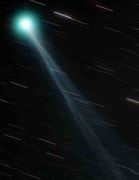 A GREEN LEMMON:
At the moment there are three significant comets plunging toward the sun: Comet ISON, Comet Pan-STARRS, and Comet Lemmon. The most beautiful so far is this one:
A GREEN LEMMON:
At the moment there are three significant comets plunging toward the sun: Comet ISON, Comet Pan-STARRS, and Comet Lemmon. The most beautiful so far is this one:
"Comet Lemmon has a beautiful tail with lovely fine structure," says Phil Hart of Lake Eppalock, Victoria, Australia, who photographed it on Feb. 17th.
The comet is now slightly closer to the sun than Earth. Solar heating has turned it into a binocular object (magnitude +5.5 to +6) barely visible to the human eye, but dazzling through backyard telescopes, as shown in Hart's photo above.
Comet Lemmon's verdant color comes from two of the gases boiling off its nucleus: cyanogen (CN: a poisonous gas found in many comets) and diatomic carbon (C2). Both substances glow green when illuminated by sunlight in the near-vacuum of space.
Comment: It looks quite blue to me...
The Year of the Comets: Three Reasons Why 2013 Could be the Best Ever
Universe Today, 19th February 2013
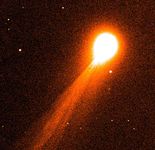 2013 could turn out to be a comet bonanza. No fewer than three of these long-tailed beauties are expected to brighten to naked eye visibility. Already Comet C/2011 L4 PANSTARRS has cracked that barrier. Sky watchers in Australia have watched it grow from a telescopic smudge to a beautiful binocular sight low above the horizon at both dusk and dawn. A few have even spotted it without optical aid in the past week. Excited reports of a bright, fan-shaped dust tail two full moon diameters long whet our appetite for what's to come.
2013 could turn out to be a comet bonanza. No fewer than three of these long-tailed beauties are expected to brighten to naked eye visibility. Already Comet C/2011 L4 PANSTARRS has cracked that barrier. Sky watchers in Australia have watched it grow from a telescopic smudge to a beautiful binocular sight low above the horizon at both dusk and dawn. A few have even spotted it without optical aid in the past week. Excited reports of a bright, fan-shaped dust tail two full moon diameters long whet our appetite for what's to come.
Comment: We are only expecting some serious action from Comet C/2012 S1 (ISON) from mid 2013 onwards as it interacts electrically with the biggest planets and might upset the Sun. This is the real reason why NASA are still talking about 'solar maximum' when the sun is extremely quiet and just acting very unpredictable. Solar experts are generally puzzled, see archive Best of the Blog - The Sun.
-
Comet C/2012 S1 (ISON): JamesMcCanneyScienceHour_October_04_2012 (MP3)
James McCanney Science Hour, 4th October 2012

Comment: This is classic James McCanney where we are given a basic introduction to what is happening with Comet C/2012 S1 (ISON) and what he expects to happen and why there may be some severe space weather events THIS YEAR. He expects to see major cometary interactions with the gas planets of Jupiter, and Mars and then more interactions with Mercury... Nothing is absolutely certain, but it is very likely the citizens of planet Earth are going to witness major celestial fireworks of biblical proportions in the heavens.
Comet C/2012 S1 (ISON): JamesMcCanneyScienceHour_November_08_2012.mp3
James McCanney Science Hour, 8th November 2012

Comment: Only the first 23 minutes of this show is dedicated to talking about Comet C/2012 S1 (ISON) but we get a detailed description of 'The Red Hand of Death'. McCanney does not mention the comet 'Wormwood' in the show on the 4th October & 8th November 2012, but over the years worth of shows that I have listened to in the past, he has talked about a comet known to the Catholic Church that has polluted the Earth's waters in our ancient past and made them 'bitter'. Here is some introductory information from a short article with some science (chemistry) that is not too difficult to understand, so it is strongly recommended that the whole article is read especially for those readers who doubt the seriousness of what can happen when large comets come near to Earth... Simply, the analogy of a biblical Passover is not fanciful.
In the First Century AD, the Apostle John wrote an apocalyptic book called "Revelation" in which he described among many "end-time" events the collision of a star called Wormwood with Earth. Revelation states:
Rev. 8:10-11: The third angel sounded his trumpet, and a great star, blazing like a torch, fell from the sky on a third of the rivers and on the springs of water-- the name of the star is Wormwood. A third of the waters turned bitter, and many people died from the waters that had become bitter.
Wormwood is a botanical herb commonly known for its bitterness. See Botanical.com. It was used as a pesticide, medicinal tonic and liqueur ingredient. The term "wormwood" was often used to describe "extreme bitterness".
Let us consider the possibility of a "star" turning the waters bitter on Earth. The term "star" in classical terminology lacks the modern astronomical sense. It could have been referring to a comet, asteroid, "sun-like" star or planet. Since the possibility of a planet or sun colliding with earth is infinitesimal, we will eliminate this possibility.
Scientific Scenario Of A Comet's Impact And The "Wormwood Star" Prophecy by Marshall Beeber, Messianic Literary Corner.
Ignore the "heat shock" that is talk for infants. A comet nucleus does not need to be anywhere near Earth because comet tails can be thought of as electrical bare "wires" across space. What's more, NASA has measured these 'tails' to stretch for half a billion miles. So, it is the electrical interactions of these comet tails in our atmosphere that will cause chemical reactions in our atmosphere. For reasons that I will not disclose, I think a lot more people need to be aware that things may become very chaotic on this planet in the new future. You don't need to believe me but James McCanney has been preparing his audience for a very long time so that people will be able to better cope in any catacylsmic event. Despite the disinformation campaigns that target James McCanney, I have great respect. This is a man who actually cares about people.
-
JamesMcCanneyScienceHour_November_15_2012.mp3
James McCanney Science Hour, 15th November 2012

Comment: James McCanney continues talking about Comet C/2012 S1 (ISON) and more about 'The Red Hand of Death' and The Passover event detailed in The Bible (00.00 - 04:45 & 35.50 - 59.00) . Here, it is worth pointing out that some of the mythologising about 'the gods' make a lot more sense when we realise that astronomer-priests sought to preserve the stories of what happened when monster comets come into our solar system and cause havoc as they interact with the major planets of Saturn and Jupiter and then fling the end products on us on Earth... Due to the scientific merit, some mythologists are also now re-interpretating myths in terms of highly electrical plasma manifestations being seen in the heavens.
Enigmatic "Ribbon" Of Energy Discovered by NASA Satellite Explained
University of New Hampshire, 5th February 2013
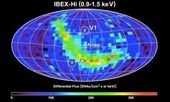 DURHAM, N.H. -- After three years of puzzling over a striking "ribbon" of energy and particles discovered by NASA's Interstellar Boundary Explorer (IBEX) at the edge of our solar system, scientists may be on the verge of cracking the mystery.
DURHAM, N.H. -- After three years of puzzling over a striking "ribbon" of energy and particles discovered by NASA's Interstellar Boundary Explorer (IBEX) at the edge of our solar system, scientists may be on the verge of cracking the mystery.
In a paper published Feb. 4, 2013, in the Astrophysical Journal, researchers, including lead author Nathan Schwadron of the University of New Hampshire, propose a "retention theory" that for the first time explains all the key observations of this astrophysical enigma.
"If the theory is correct," Schwadron notes, "the ribbon can be used to tell us how we're moving through the magnetic fields of the interstellar medium and how those magnetic fields then influence our space environment." [...]
Indeed, since the discovery of the ribbon, more than a dozen competing theories seeking to explain the phenomenon have been put forth. The retention theory "checks all the boxes, agrees with all the available observations, and the mathematical modeling results look remarkably like what the ribbon actually looks like," notes Schwadron. "This substantially raises the bar for models that attempt to explain the ribbon."
Comment: Please note we are being told that after 3 years scientists are still guessing. This is a press release from a scientist at this university with his own ideas that's all. All we know for a fact is that space scientists were shocked to discover the IBEX ribbon in 2009 as none of their models had predicted it and it seems they are still struggling to explain it. From a metaphysical point of view, we were told to expect the arrival of a big snake in the heavens that would signify the end of the precessional cycle. As I explain in my long essay, The Greatest Transition in the History of Mankind (June 2010) we can give credit to Jay Weidner and Vincent Bridges for unravelling a mystery but to my knowledge they missed the implications of the IBEX discovery in 2009 as they had made some duff predictions for 2002. Nevermind, my essay was written in June 2010 and so far, nobody has challenged my assertions but I think based on the dramatic changes in our solar system, the metaphysical community were adequately tipped off.
Billionaire Bigelow: Las Vegas UFO Aficionado Bets $500 Million on Space Hotel
Business Week, 28th January 2013
 Robert Bigelow got rich off budget hotel suites that start at $189 a week. Now they are funding his dream of building inflatable space habitats with rates topping $400,000 a day.
Robert Bigelow got rich off budget hotel suites that start at $189 a week. Now they are funding his dream of building inflatable space habitats with rates topping $400,000 a day.
For the Las Vegas businessman, his desire to build low orbital dwellings is the ultimate gamble. He has bet $500 million of his own money on his closely held venture, Bigelow Aerospace LLC -- five times what billionaire Elon Musk invested in his own space company. [..]
Bigelow has nursed a lifelong obsession with unidentified flying objects after his mother regaled him with the tale of his grandparents seeing a glowing flying object while driving through the desert in 1947.
He has amassed a library of about 3,500 books about UFOs, cosmology and related subjects. He gave financial backing to the National Institute for Discovery Science, which hunted UFOs and studied paranormal activities before disbanding in 2004. He has personally recorded interviews with almost 250 people who claim to have had a sighting or encounter with a UFO, and said he believes alien wreckage was discovered in Roswell, New Mexico, in the 1940s.
UFO Believer: “I'm in the camp that has zero doubt” that UFOs exist and have visited the Earth, Bigelow said in a phone interview.
Comment: OK, I have some respect for billionaire Robert Bigelow or Mr Big... This character has done his UFO homework and does not care two hoots what the ignorant and uninformed think or believe as he takes the presence of a shadow biosphere on this planet seriously. It is still interesting that the December 2009 press release by the US FAA informed pilots and air traffic controllers that if they came across a UFO, they could contact Bigelow's organisation - Bigelow Aerospace Advanced Space Studies (BAASS) by phone or or e-mail. Anyway, I can't understand why people think these space hotels are a good idea as space weather is only just ramping up but the BEAM module is basically bullet proof and will stop astronauts worrying about space debris, see earlier reports. It also seems that Bigelow is not worried either about any ET threat and neither should anyone else. If anything, I think watching the cosmic jetsam and flotsam in near earth orbit would be a highly sought after experience... This is an interesting statement, Mr Big states: “This isn't about benefiting one human... This is about opening up space for all of humanity.” Is that a streak of Tier II aspirations and wider perspective on creating an advancement for humanity? There are not so many about who are around with this level of thinking, often its just talk. Bigelow is getting on with it and proving himself. I wish I knew people with the same mentality...
Darkness Cannot Drive Out Darkness
Thunderbolts.Info, 24th January 2013
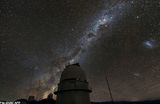 Dark matter is in the news.
Dark matter is in the news.
“Plasma phenomena are scalable. Their electrical and physical properties remain the same, independent of the size of the plasma.”
– Donald Scott, author of The Electric Sky
Plasma in space usually appears as a cloud of partially charged gas and dust. When clouds are in motion they become ionized. Clouds in relative motion induce electric currents within them. The currents generate magnetic fields that confine the plasma into coherent filaments known as Birkeland currents. The charged particles in the currents spiral along the resulting magnetic fields, appearing as electrical vortices. The forces between these spinning Birkeland currents pull them close together and wind them around each other into “plasma ropes”.
Birkeland currents squeeze galactic plasma into thin filaments that remain collimated over great distances. Light-years-long jets and so-called “radio lobes” can extend for many times a galaxy's diameter, for example. A circuit is induced within any one galaxy that causes diffuse electric charge to flow from the galactic poles toward the galaxy's equatorial plane and spiral into its nucleus.
Comment: For some strange reason this article headline prompts me to wax lyrical about those who prefer some genuine education rather than engaging in mind games. I have had a few opportunities in the last 8 years to cooperate with uneducated/lying/cheating/manipulate frauds and I simply can't do it... What I can't understand is: how anyone can think progress is achieved by cooperating with the ignorant and dumbed down? In this regard, I have had numerous people who are oblivious to what research entails sending me YouTube links as if that is the same as actually reading hundreds of articles, books and research papers by real scholars... I seriously wonder if some even know what obtaining a proper honours degree from a real university actually represents. /rant over
Jupiter's radio laser beams hit Earth
Spaceweather.com, 23rd January 2013
 AWASH IN JUPITER RADIO BURSTS:
The planet Jupiter is a powerful source of shortwave radio bursts. They come from natural radio lasers in the giant planet's polar magnetosphere that sometimes sweep past Earth as Jupiter rotates. On Jan. 21st, as Jupiter and the Moon were converging high in the midnight sky, a series of Jupiter's radio laser beams hit Earth. Amateur astronomer Thomas Ashcraft recorded the static-y sounds coming from the loudspeaker of his shortwave radio telescope in New Mexico:
AWASH IN JUPITER RADIO BURSTS:
The planet Jupiter is a powerful source of shortwave radio bursts. They come from natural radio lasers in the giant planet's polar magnetosphere that sometimes sweep past Earth as Jupiter rotates. On Jan. 21st, as Jupiter and the Moon were converging high in the midnight sky, a series of Jupiter's radio laser beams hit Earth. Amateur astronomer Thomas Ashcraft recorded the static-y sounds coming from the loudspeaker of his shortwave radio telescope in New Mexico:
"Sometimes when people are outside Jupiter-gazing they might also be awash in Jovian radio beam sweeps and not know it," says Ashcraft. "On Sunday, a Jovian radio storm produced a few minutes of strong radio waves. As I was outside my observatory looking up at Jupiter I was also hearing the waves on my radio telescope speakers and realized that my own body was, in that moment, being bathed in electromagnetic beams from Jupiter. What a nice feeling!"
Comment: I wonder what the impact is on humans being bathed in EM beams from Jupiter? To be honest, I would have thought this would be known to astrologers if astrology is truly derived from understanding the impact of cosmic/celestial forces on human behaviour. Well, scientists inform us that microwave/laser beams are being created in space and in the atmospheres of planets and stars. I strongly suspect that the production of these beams in Earth's highly electrified magnetosphere and atmosphere is the cause of the strange laser-cut looking boreholes that are now suddenly appearing on Earth, see archives for some good examples.
Betelgeuse Is About to Hit the Wall
Bad Astronomy, 22nd January 2013
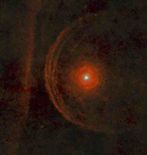 [...] Herschel detects infrared light, far outside what the human eye can detect. In those wavelengths, vast shells of dust surrounding Betelgeuse become visible. All stars emit a wind of subatomic particles–we call the Sun's the solar wind. Red supergiants do as well, but their outer atmospheres are far cooler than our Sun's, so the chemistry is different. More complex molecules can form, including what we call dust. This dust is warmed by the star and glows in the far infrared, where Herschel can spot it.
[...] Herschel detects infrared light, far outside what the human eye can detect. In those wavelengths, vast shells of dust surrounding Betelgeuse become visible. All stars emit a wind of subatomic particles–we call the Sun's the solar wind. Red supergiants do as well, but their outer atmospheres are far cooler than our Sun's, so the chemistry is different. More complex molecules can form, including what we call dust. This dust is warmed by the star and glows in the far infrared, where Herschel can spot it.
You can see the dust forms thin shells around the star. That indicates the wind isn't constant. Most likely Betelgeuse expels dust in periodic episodes, rapid spasms of wind that blow out more dust than usual. Think of it as the star coughing–it's dusty there, after all.
You might expect the dust to form a sphere centered on Betelgeuse, but you can see the star is well off-center to the left. That's because Betelgeuse is a star in motion! It's moving through space at about 30 kilometers per second (18 miles per second, or about 65,000 miles per hour). Space isn't really a vacuum, it's only mostly a vacuum: There is material between the stars, a thin soup of dust and gas. The dust slows as it expands into this interstellar matter, but Betelgeuse just rams right through it, eventually becoming noticeably off-center.
Comment: It is very interesting that most humans only want to believe what they can see with eyes but our model technological world has created eyes that can see far far more. Here, mention of gas is incorrect and to be able to explain these cosmic features properly requires a knowledge of plasma and plasma cosmology. Since most astronomers are not taught plasma physics or plasma cosmology, their explanations often tend to be lacking in scientific credibility from an independents point of view, but progress is being made. Simply, due to the obvious electrical activity in the heavens and astronomers measuring current flows in the cosmos of millions of amperes, more and more astronomers are being forced to reconsider their fundamental beliefs that historically have more closely resembled a religion than proper science. My e-book The Electrotechnics of the Heavens is my introduction to this subject.
Jupiter's radio laser beams hit Earth
Spaceweather.com, 23rd January 2013
 AWASH IN JUPITER RADIO BURSTS:
The planet Jupiter is a powerful source of shortwave radio bursts. They come from natural radio lasers in the giant planet's polar magnetosphere that sometimes sweep past Earth as Jupiter rotates. On Jan. 21st, as Jupiter and the Moon were converging high in the midnight sky, a series of Jupiter's radio laser beams hit Earth. Amateur astronomer Thomas Ashcraft recorded the static-y sounds coming from the loudspeaker of his shortwave radio telescope in New Mexico:
AWASH IN JUPITER RADIO BURSTS:
The planet Jupiter is a powerful source of shortwave radio bursts. They come from natural radio lasers in the giant planet's polar magnetosphere that sometimes sweep past Earth as Jupiter rotates. On Jan. 21st, as Jupiter and the Moon were converging high in the midnight sky, a series of Jupiter's radio laser beams hit Earth. Amateur astronomer Thomas Ashcraft recorded the static-y sounds coming from the loudspeaker of his shortwave radio telescope in New Mexico:
"Sometimes when people are outside Jupiter-gazing they might also be awash in Jovian radio beam sweeps and not know it," says Ashcraft. "On Sunday, a Jovian radio storm produced a few minutes of strong radio waves. As I was outside my observatory looking up at Jupiter I was also hearing the waves on my radio telescope speakers and realized that my own body was, in that moment, being bathed in electromagnetic beams from Jupiter. What a nice feeling!"
Comment: I wonder what the impact is on humans being bathed in EM beams from Jupiter? To be honest, I would have thought this would be known to astrologers if astrology is truly derived from understanding the impact of cosmic/celestial forces on human behaviour. Well, scientists inform us that microwave/laser beams are being created in space and in the atmospheres of planets and stars. I strongly suspect that the production of these beams in Earth's highly electrified magnetosphere and atmosphere is the cause of the strange laser-cut looking boreholes that are now suddenly appearing on Earth, see archives for some good examples.
Gamma-ray burst 'hit Earth in 8th Century'
BBC News, 21st January 2013
 A gamma ray burst, the most powerful explosion known in the Universe, may have hit the Earth in the 8th Century.
In 2012 researchers found evidence that our planet had been struck by a blast of radiation during the Middle Ages, but there was debate over what kind of cosmic event could have caused this.
A gamma ray burst, the most powerful explosion known in the Universe, may have hit the Earth in the 8th Century.
In 2012 researchers found evidence that our planet had been struck by a blast of radiation during the Middle Ages, but there was debate over what kind of cosmic event could have caused this.
Now a study suggests it was the result of two black holes or neutron stars merging in our galaxy. This collision would have hurled out vast amounts of energy. The research is published in the journal Monthly Notices of the Royal Astronomical Society.
Comment: This cosmic event might explain certain issues with the Gregorian calendar and European history that historians and scholars are perplexed about....
Monster Outflows Pouring Out Of Milky Way's Center
Red Orbit, 2nd January 2013
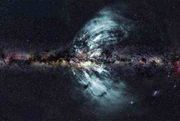 Astronomers using CSIRO's 210-feet Parkes radio telescope in eastern Australia have found monstrous outflows of charged particles coming from the center of our galaxy.
The researchers said that the outflows contain an extraordinary amount of energy, reaching about a million times the energy of an exploding star.
Astronomers using CSIRO's 210-feet Parkes radio telescope in eastern Australia have found monstrous outflows of charged particles coming from the center of our galaxy.
The researchers said that the outflows contain an extraordinary amount of energy, reaching about a million times the energy of an exploding star.
Although the outflows are shooting out at over 600 miles per second, they pose no danger to Earth or the solar system.
“They are not coming in our direction, but go up and down from the galactic plane,” said CSIRO's Dr. Ettore Carretti. “We are 30,000 light-years away from the galactic center, in the plane. They are no danger to us.”
The outflows extend 50,000 light-years from top to bottom out of the galactic plane, which equals half the diameter of the Milky Way.
Comment: There seems to be a lot going on in our galaxy's galactic centre... Last year, we had reports of a huge cosmic bullet, a plasma cloud with the volume of three Earths that was nearing Sagittarius A*, the galactic centre and is expected to ignite it in X-rays and radio waves (at least) in mid June 2013, (see archives for mid December 2011). Astronomers all over the world will be monitoring this unusual event and now this...
Approaching comet may outshine the moon
Reuters News, 14th December 2012
 (Reuters) - A comet blazing toward Earth could outshine the full moon when it passes by at the end of next year - if it survives its close encounter with the sun.
The recently discovered object, known as comet ISON, is due to fly within 1.2 million miles (1.9 million km) from the center of the sun on November 28, 2013 said astronomer Donald Yeomans, head of NASA's Near Earth Object Program at the Jet Propulsion Laboratory in Pasadena, Calif.
As the comet approaches, heat from the sun will vaporize ices in its body, creating what could be a spectacular tail that is visible in Earth's night sky without telescopes or even binoculars from about October 2013 through January 2014. [...]
(Reuters) - A comet blazing toward Earth could outshine the full moon when it passes by at the end of next year - if it survives its close encounter with the sun.
The recently discovered object, known as comet ISON, is due to fly within 1.2 million miles (1.9 million km) from the center of the sun on November 28, 2013 said astronomer Donald Yeomans, head of NASA's Near Earth Object Program at the Jet Propulsion Laboratory in Pasadena, Calif.
As the comet approaches, heat from the sun will vaporize ices in its body, creating what could be a spectacular tail that is visible in Earth's night sky without telescopes or even binoculars from about October 2013 through January 2014. [...]
Comet ISON's path is very similar to a comet that passed by Earth in 1680, one which was so bright its tail reportedly could be seen in daylight.
The projected orbit of comet ISON is so similar to the 1680 comet that some scientists are wondering if they are fragments from a common parent body.
"Comet ISON…could be the brightest comet seen in many generations - brighter even than the full moon," wrote British astronomer David Whitehouse in The Independent.
Comment: Since there is a comparison with Comet Hale-Bopp, I think we are being given a subtle warning...
-
2013 set to be Earth's brightest ever for comets
Euro News, 14th January 2013
Star-gazers will be treated to the brightest comet ever seen from Earth this year.
Comet ISON, discovered by astronomers in September 2012, is forecast to appear in the Northern hemisphere sky on November 28 2013. By day it will be visible with the naked eye, while by night it's expected to outshine a full moon. [...]
Although they will miss out on ISON, people in the Southern hemisphere will be able to enjoy Comet Pan-STARRS, which will be visible from January and reach its brightest in March. Pan-STARRS takes its name from the Hawaii-based telescope that discovered it in 2011.
-
COMET ISON APPROACHES - It Might Activate The Sun
Spaceweather.com, 13th January 2013
COMET ISON APPROACHES: Later this year, Comet ISON could put on an unforgettable display as it plunges toward the sun for a fiery encounter likely to turn the "dirty snowball" into a naked-eye object in broad daylight. At the moment, however, it doesn't look like much. John Chumack sends this picture, taken Jan. 8th, from his private observatory in Yellow Springs, Ohio:
"Comet ISON (C/2012 S1) is currently in the constellation Gemini, moving between the heads of the twins Castor and Pollux," says Chumack. "It is still pretty faint, near 16th magnitude, but don't be fooled by that. This could become one of the best comets in many years."
Comet ISON is a sungrazer. On Nov. 28, 2013, it will fly through the sun's outer atmosphere only 1.2 million km from the stellar surface below. If the comet survives the encounter, it could emerge glowing as brightly as the Moon, visible near the sun in the blue daylight sky. The comet's dusty tail stretching into the night would create a worldwide sensation. Comet ISON looks so puny now because it is so far away, currently near the orbit of Jupiter. As it falls toward the sun in the months ahead it will warm up and reveal more about its true character. By the summer of 2013, researchers should know whether optimistic predictions about Comet ISON are justified. Possibilities range from "Comet of the Century" to disintegrated dud. Stay tuned!
SDSS J1106+1939: Biggest Black Hole Quasar Blast Discovered
Science 2.0 News, 28th November 2012
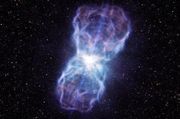 Quasars are the luminous centers of distant galaxies powered by huge black holes. Although black holes are noted for pulling material in, most quasars also accelerate some of the material around them and eject it at high speed.
Quasars are the luminous centers of distant galaxies powered by huge black holes. Although black holes are noted for pulling material in, most quasars also accelerate some of the material around them and eject it at high speed.
Many theoretical simulations suggest that the impact of these outflows on the galaxies around them may resolve several enigmas in modern cosmology, including how the mass of a galaxy is linked to its central black hole mass, and why there are so few large galaxies in the Universe. However, whether or not quasars were capable of producing outflows powerful enough to produce these phenomena has remained unclear until now.
The newly discovered outflow lies about a thousand light-years away from the supermassive black hole at the heart of the quasar SDSS J1106+1939. This outflow is at least five times more powerful than the previous record holder. The team's analysis shows that a mass of approximately 400 times that of the Sun is streaming away from this quasar per year, moving at a speed of 8000 kilometers per second.
Comment: Yet again, another record breaker... For a few years now I have suggested that there is a very good reason why there has been a lot of record breaking blasts being recorded... simply the properties of spacetime have changed and astronomers can more easily detect powerful blasts... but at the moment, there is only murmurings amongst astronomers that something fundamental has changed...
Universe Grows Like a Giant Brain
Live Science, 26th November 2012
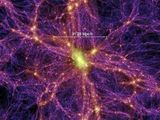
The universe may grow like a giant brain, according to a new computer simulation.
The results, published Nov.16 in the journal Nature's Scientific Reports, suggest that some undiscovered, fundamental laws may govern the growth of systems large and small, from the electrical firing between brain cells and growth of social networks to the expansion of galaxies.
"Natural growth dynamics are the same for different real networks, like the Internet or the brain or social networks," said study co-author Dmitri Krioukov, a physicist at the University of California San Diego.
The new study suggests a single fundamental law of nature may govern these networks, said physicist Kevin Bassler of the University of Houston, who was not involved in the study. [What's That? Your Physics Questions Answered]
"At first blush they seem to be quite different systems, the question is, is there some kind of controlling laws can describe them?" he told LiveScience.
Comment: I have written about this similarity in some of my essays and e-books because it is something that many cosmologists with alternative opinions about how the universe operates have noted. This is a quote from my e-book Workbook - The Electrotechnics of the Heavens,
Plasma Cosmology may provide some advantages to a deeper understanding of the cosmos when we know that the physical structure of the cosmos is directly related to the ability of plasma to scale-up from the microscopic to the intergalactic scale, indicating the existence of some kind of universal law. The Self-Similar Cosmological Model (SSCM), was first proposed by Robert L. Oldershaw in 1978 and formally presented in two review papers (Oldershaw 1989a, b). It recognizes that the cosmos is organized in a highly stratified hierarchical manner, based on the assumption that the universe displays infinite fractal geometry. From what we can detect, the universe is composed of galactic systems, which are comprised of stellar systems, which are comprised of atomic systems, three out of a large, and possibly infinite, number of nested cosmological scales. A defining principle of the SSCM is the general principle of discrete cosmological self-similarity, which asserts that for each type of system or fundamental property on a given cosmological scale, there is a self-similar analogue on all other scales.
The Electrotechnics of the Heavens (2012).
The Milky Way's Black Hole Shoots Out Brightest Flare Ever
Universe Today, 7th November 2012
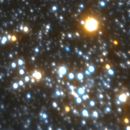 For some unknown reason, the black hole at the center of the Milky Way galaxy shoots out an X-ray flare about once a day. These flares last a few hours with the brightness ranging from a few times to nearly one hundred times that of the black hole's regular output. But back in February 2012, astronomers using the Chandra X-Ray Observatory detected the brightest flare ever observed from the central black hole, also known as Sagittarius A*. The flare, recorded 26,000 light years away, was 150 times brighter than the black hole's normal luminosity.
For some unknown reason, the black hole at the center of the Milky Way galaxy shoots out an X-ray flare about once a day. These flares last a few hours with the brightness ranging from a few times to nearly one hundred times that of the black hole's regular output. But back in February 2012, astronomers using the Chandra X-Ray Observatory detected the brightest flare ever observed from the central black hole, also known as Sagittarius A*. The flare, recorded 26,000 light years away, was 150 times brighter than the black hole's normal luminosity.
Comment: I don't want to comment just yet on this observation even though I have pointed out that astronomers have reported many record breaking cosmic blasts in the last decade or so. However I will point out again that Sagittarius A* is a tiny region within the Galactic Centre, populated by millions of stars and a 4 million solar mass 'Black Hole' accompanied by a very powerful 2.6 million solar mass radio source that has been identified as IRS 7, a red supergiant star that puts out most of its energy in the near infrared. Astronomers deliberately confuse Sagittarius A* with the rather innoculous and "feeble" black hole, but they are NOT the same thing. See archives Best of the Blog - Space & Cosmology for the latest information about why astronomers around the globe are closely watching the galactic center.
NASA: Rare, enormous gas storm detected on Saturn
CNN News, 26th October 2012
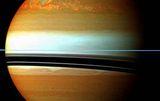 CNN) -- NASA says the Cassini spacecraft recorded the aftermath of a massive storm on Saturn that let out an "unprecedented belch of energy."
CNN) -- NASA says the Cassini spacecraft recorded the aftermath of a massive storm on Saturn that let out an "unprecedented belch of energy."
Not only was the size of the storm unusual, but what the storm was made of left scientists puzzled.
The source of the cosmic burp, which rapidly changed the atmosphere's temperature, was ethylene gas, an odorless, colorless gas that has rarely been observed on Saturn, NASA said.
"This temperature spike is so extreme it's almost unbelievable," said Brigette Hesman, the study's lead author who works at Goddard. "To get a temperature change of the same scale on Earth, you'd be going from the depths of winter in Fairbanks, Alaska, to the height of summer in the Mojave Desert," Hesman said in a statement released by NASA.
Comment: Another extreme atmospheric change taking place in a planet in our solar system caused by a massive injection of energy. We know that there are massive Birkeland currents that link planets to the Sun, so maybe there was an extra download... We need NASA/ESA scientists to provide more information....
NASA: Signs of massive climate shift on Jupiter as giant planet is under bombardment
NASA JPL News, 17th October 2012
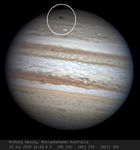 Image Caption: Jupiter has been suffering more impacts over the last four years than ever previously observed, including this meteoroid impact on Sept. 10, 2012.
Image Caption: Jupiter has been suffering more impacts over the last four years than ever previously observed, including this meteoroid impact on Sept. 10, 2012.
"The changes we're seeing in Jupiter are global in scale," Orton said. "We've seen some of these before, but never with modern instrumentation to clue us in on what's going on. Other changes haven't been seen in decades, and some regions have never been in the state they're appearing in now. At the same time, we've never seen so many things striking Jupiter. Right now, we're trying to figure out why this is all happening." [...]
While Jupiter's own atmosphere has been churning through change, a number of objects have hurtled into Jupiter's atmosphere, creating fireballs visible to amateur Jupiter watchers on Earth. Three of these objects - probably less than 45 feet (15 meters) in diameter - have been observed since 2010. The latest of these hit Jupiter on Sept. 10, 2012, although Orton and colleagues' infrared investigations of these events showed this one did not cause lasting changes in the atmosphere, unlike those in 1994 or 2009.
"It does appear that Jupiter is taking an unusual beating over the last few years, but we expect that this apparent increase has more to do with an increasing cadre of skilled amateur astronomers training their telescopes on Jupiter and helping scientists keep a closer eye on our biggest planet," Orton said. "It is precisely this coordination between the amateur-astronomy community that we want to foster."
Comment: NASA scientists are telling us that there have been dramatic increase of cosmic objects (asteroids/comets/meteoroids) hitting Jupiter in the last 4 years at the same time as massive global atmospheric changes have been appearing in the last few decades but they don't explain the connection. These reports have been coming through for quite a few years but Russian scientists were the first to highlight the impact of "Space Weather" and massive changes in ALL the planets in our solar system in their definitive PLANETOPHYSICAL STATE OF THE EARTH AND LIFE [1998]. Today we have an update in the form of a massive 600 page report from the World Forum – International Congress “Natural Cataclysms and Global Problems of the Modern Civilization” - Geocataclysm 2011, 19-21 September 2011, Istanbul, Turkey Source: Link. The opening plenary speech and Resolution of the World Forum are recommended. So, the excuse that more amateur astronomers are keeping a closer eye on our biggest neighbouring planet is rather poor, when we have an international community of astronomers that know full well that massive global changes are taking place in our solar system, as it is being flooded by an interstellar debris field of asteroids, small rocks and cosmic dust. [For the few morons intellectually challenged out there who are using the terminology "debris field", please understand the difference, a suitable analogy is between an ocean and a fish in the ocean....] This is not new news but changes are ongoing. The image icon is from a hit in July 2009, see archives Best of the Blog - Space & Cosmology.
Uranus has Bizarre Weather (For a planet once thought to be rather placid)
Universe Today, 18th October 2012
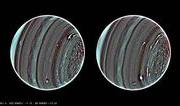 Here's the scene: a thick, tempestuous atmosphere with winds blowing at a clip of 900 km/h (560 mph); massive storms that would engulf continents here on Earth, and temperatures in the -220 C (-360 degree F) range. Sounds like a cold Hell, but this is the picture emerging of the planet Uranus, revealed in new high-resolution infrared images from the Keck Observatory in Hawaii, exposing in incredible detail the bizarre weather of a planet that was once thought to be rather placid.
Here's the scene: a thick, tempestuous atmosphere with winds blowing at a clip of 900 km/h (560 mph); massive storms that would engulf continents here on Earth, and temperatures in the -220 C (-360 degree F) range. Sounds like a cold Hell, but this is the picture emerging of the planet Uranus, revealed in new high-resolution infrared images from the Keck Observatory in Hawaii, exposing in incredible detail the bizarre weather of a planet that was once thought to be rather placid.
Strange star spiral offers clues to sun's fate
Fox News, 10th October 2012
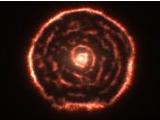 An intriguing spiral structure surrounding a pulsing red giant star may be offering a preview of how the sun will behave at the end of its life.
An intriguing spiral structure surrounding a pulsing red giant star may be offering a preview of how the sun will behave at the end of its life.
Using the Atacama Large Millimeter/Submillimeter Array (ALMA) in northern Chile, an international team of astronomers found the spiral structure, one never seen before, in the envelope of gas and dust around a red giant about 1,000 light-years from Earth and took a detailed three-dimensional reading of its composition.
The spiral is thought to be created from the gases being expelled by the dying red giant called R Sculptoris. The structure provides information about the velocity of the wind blowing off of R Sculptoris, revealing that the star has expelled three times as much mass as previously estimated.
Comment: I have commented on a similar spiral before, see below:
-
Hubble Spies an Amazing Cosmic Spiral
Universe Today, 7th September 2010 Flashback!
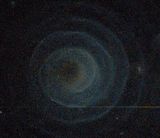 The Hubble Space Telescope's Advanced Camera for Surveys has captured a remarkable image of a spiral in space. No, not a spiral galaxy, (and not another Norway Spiral!) but the formation of an unusual pre-planetary nebula in one of the most perfect geometrical spirals ever seen. The nebula, called IRAS 23166+1655, is forming around the star LL Pegasi (also known as AFGL 3068) in the constellation of Pegasus.
The Hubble Space Telescope's Advanced Camera for Surveys has captured a remarkable image of a spiral in space. No, not a spiral galaxy, (and not another Norway Spiral!) but the formation of an unusual pre-planetary nebula in one of the most perfect geometrical spirals ever seen. The nebula, called IRAS 23166+1655, is forming around the star LL Pegasi (also known as AFGL 3068) in the constellation of Pegasus.
The image shows what appears to be a thin spiral pattern of amazing precision winding around the star, which is itself hidden behind thick dust. Mark Morris from UCLA and an international team of astronomers say that material forming the spiral is moving outwards at a speed of about 50,000 km/hour and by combining this speed with the distance between layers, they calculate that the shells are each separated by about 800 years.
Comment: This is an interesting example of a galactic sized spiral plasma formation. It's not a logrithmic spiral and it's not concentric shells that form in a crystalline plasma but something inbetween and dependent on the electric and magnetic properties of the plasma, but it's described here as a thin spiral pattern. Plasma physicists have proven that plasma will scale up a trillion fold by comparing the behaviour plasma in the laboratory and we can do our own comparisons, as we are now regularly seeing plasma formations in our atmosphere and skies that can be compared to galactic sized formations. For more information see, the Joyfire Tour
The Electric Universe. More: Celestial spiral goes viral
Yes, this article maybe going viral, but how many are explaining the significance in terms of a plasma, which fills 99.999% of the visible universe and the fact that our atmosphere is becoming an increasing charged plasma? People are still looking for answers and meaning, not more illogical explanations.
Sounds of space: NASA records audible "chorus" beyond Earth
CBS News, 25th September 2012
 SPACE.com) A NASA spacecraft has made the clearest record yet of choruses of noise in the Earth's magnetosphere.
SPACE.com) A NASA spacecraft has made the clearest record yet of choruses of noise in the Earth's magnetosphere.
The chirps and whoops were captured by one of NASA's two recently launched Radiation Belt Storm Probes spacecraft, whose mission is to understand more about space weather.
"My wife calls it 'alien birds,'" joked experiment principal investigator Craig Kletzing, an astronomer at the University of Iowa.
The twin RBSP spacecraft are exploring the magnetosphere, an area where solar particles add energy to the Earth's magnetic environment, leading to a release of energy in the Van Allen radiation belt. [
Comment: This is exactly the same as when energy is transfered from the ionosphere to the ground during the process of lightning. NASA states:
"Everyone's terrestrial environment almost literally sings with radio waves at audio frequencies," says Dennis Gallagher, a space physicist at the Marshall Space Flight Center (MSFC). "Our ears can't detect radio waves directly, but we can convert them to sound waves with the aid of a very low frequency (VLF) radio receiver."
[...]
The source of most VLF emissions on Earth is lightning. Lightning strokes emit a broadband pulse of radio waves, just as they unleash a visible flash of light. VLF signals from nearby lightning, heard through the loudspeaker of a radio, sound like bacon frying on a griddle or the crackling of a hot campfire. Space scientists call these sounds "sferics," short for atmospherics.
Earth Songs:
Our planet is a natural source of radio waves at audio frequencies. An online receiver at the Marshall Space Flight Center is playing these songs of Earth so anyone can listen.
NASA Science News, January 19, 2001
Radio waves are communicating information, so I can only presume the planetary brain picks up the information as a data transmission to accompany the physical delivery of energy, but the whole process is still curious...
NASA's Chandra Shows Milky Way is Surrounded by Halo of Hot Gas
NASA Chandra News, 24th September 2012
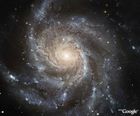 Astronomers have used NASA's Chandra X-ray Observatory to find evidence our Milky Way Galaxy is embedded in an enormous halo of hot gas that extends for hundreds of thousands of light years. The estimated mass of the halo is comparable to the mass of all the stars in the galaxy.
Astronomers have used NASA's Chandra X-ray Observatory to find evidence our Milky Way Galaxy is embedded in an enormous halo of hot gas that extends for hundreds of thousands of light years. The estimated mass of the halo is comparable to the mass of all the stars in the galaxy.
If the size and mass of this gas halo is confirmed, it also could be an explanation for what is known as the "missing baryon" problem for the galaxy.
Baryons are particles, such as protons and neutrons, that make up more than 99.9 percent of the mass of atoms found in the cosmos. Measurements of extremely distant gas halos and galaxies indicate the baryonic matter present when the universe was only a few billion years old represented about one-sixth the mass and density of the existing unobservable, or dark, matter. In the current epoch, about 10 billion years later, a census of the baryons present in stars and gas in our galaxy and nearby galaxies shows at least half the baryons are unaccounted for.
Comment: The "hot gas" is technically plasma, and the evidence suggests that everything in the universe, whether an object is big or small, is surrounded by more rarefied energy.... atoms are surrounded by electrons, humans and living beings have an energy field made up of plasma, galaxies have a dark matter halo.... The question is fast becoming: what exactly is dark matter? It seems that the plasma cosmology viewpoint that dark matter is just hard to detect sub-atomic particles (plasma) is making some headway.
NASA's Solar Fleet Peers Into Coronal Cavities
NASA Science News, 20th September 2012
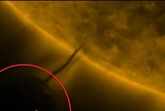 [...] Kucera and her colleagues have published a paper in the Sept. 20, 2012, issue of The Astrophysical Journal on the temperatures of the coronal cavities. This is the third in a series of papers -- the first discussed cavity geometry and the second its density -- collating and analyzing as much data as possible from a cavity that appeared over the upper left horizon of the sun on Aug. 9, 2007 (below). By understanding these three aspects of the cavities, that is the shape, density and temperature, scientists can better understand the space weather that can disrupt technologies near Earth.
[...] Kucera and her colleagues have published a paper in the Sept. 20, 2012, issue of The Astrophysical Journal on the temperatures of the coronal cavities. This is the third in a series of papers -- the first discussed cavity geometry and the second its density -- collating and analyzing as much data as possible from a cavity that appeared over the upper left horizon of the sun on Aug. 9, 2007 (below). By understanding these three aspects of the cavities, that is the shape, density and temperature, scientists can better understand the space weather that can disrupt technologies near Earth.
Comment: Sun watchers in the blogosphere have already been wondering about these black cavities, see the incredible SDO video link below. This discovery just goes to show that there are new and surprising things still being discovered about our sun and the emphasis on space weather is an excuse to do some intensive analysis.
A Ring of Truth
Thunderbolts.info, 17th September 2012
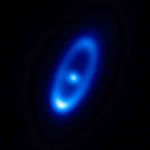 Rings around stars confirm Electric Universe theory.
Rings around stars confirm Electric Universe theory.
A recent press release from the European Space Agency announces that a ring around the star Fomalhaut (Fo-mal-HOUT) demonstrates “the glow from dust in the debris disc – a structure resembling the Kuiper Belt in the primordial Solar System – around the young star Fomalhaut. Detailed studies suggest that the dust in this debris disc consists of “fluffy” aggregates of grains, which are produced by the frequent collisions taking place between comets within the disc.” [...]
Astronomers believe that fluffy dust aggregates in the Solar System arise from collisions between comets, so they assume that the fluffy dust observed in the debris disc of Fomalhaut derives from cometary collisions, too. However, radiation pressure from the star should effectively blow such fluffy particles away: “this blow-out effect must be compensated by a steady production of dust particles via comet collisions,” notes co-author Carsten Dominik from the University of Amsterdam and Radboud Universiteit Nijmegen, which means the dust particles are being replenished by cometary impacts.
Comment: Scientists have adopted a principle called Occam's Razor, where if there are two competing theories that make exactly the same predictions, the simpler one is considered to be better. Invariably, in cosmology and astronomy, Plasma Cosmology or even the more speculative Electric Universe theory is always the most simple, thus fulfilling Occam's Razor.... Here, standard astronomical theory is shown by some basic calculations to be highly speculative...
Image of the Day: The Spectacular Vela Supernova Remnant
Daily Galaxy, 12th September 2012
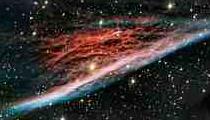 The Pencil Nebula is pictured in a new image from ESO's La Silla Observatory in Chile. This peculiar cloud of glowing gas is part of a huge ring of wreckage left over after a supernova explosion that took place about 11 000 years ago. This detailed view was produced by the Wide Field Imager on the MPG/ESO 2.2-metre telescope. [...]
The Pencil Nebula is pictured in a new image from ESO's La Silla Observatory in Chile. This peculiar cloud of glowing gas is part of a huge ring of wreckage left over after a supernova explosion that took place about 11 000 years ago. This detailed view was produced by the Wide Field Imager on the MPG/ESO 2.2-metre telescope. [...]
This oddly shaped cloud, which is also known as NGC 2736, is a small part of a supernova remnant in the southern constellation of Vela (The Sails). These glowing filaments were created by the violent death of a star that took place about 11 000 years ago. The brightest part resembles a pencil; hence the name, but the whole structure looks rather more like a traditional witch's broom.
Comment: The witch's broom feature is obviously highly filamentary plasma... This is the response at Thunderbolts.info,
Plasma Twisting and Rock Banging
Astronomers measure largest-ever magnetic field around massive star
PhysOrg.com, 11th September 2012
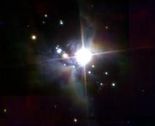 Phys.org)–A group of astronomers led by Gregg Wade of the Royal Military College of Canada have used the Hobby-Eberly Telescope (HET) at The University of Texas at Austin's McDonald Observatory and the Canada-France Hawaii Telescope (CFHT) on Hawaii's Mauna Kea to measure the most magnetic massive star yet. Their work is published in today's issue of the research journal Monthly Notices of the Royal Astronomical Society.
Phys.org)–A group of astronomers led by Gregg Wade of the Royal Military College of Canada have used the Hobby-Eberly Telescope (HET) at The University of Texas at Austin's McDonald Observatory and the Canada-France Hawaii Telescope (CFHT) on Hawaii's Mauna Kea to measure the most magnetic massive star yet. Their work is published in today's issue of the research journal Monthly Notices of the Royal Astronomical Society.
The star's magnetic field is 20,000 times stronger than the Sun's, and almost 10 times stronger than that detected around any other high-mass star. At about 35 times the Sun's mass, the O-type star NGC 1624-2 lies in the open star cluster NGC 1624, about 20,000 light-years away in the constellation Perseus.
This star is an extreme case study to help astronomers better understand all massive stars, which play an important role in the evolution of galaxies.
Comment: Shakes head... It seems that astronomers are still talking in 'baby-talk' plasma physics. We have the example here of "...the star is slowed down because it has to drag its wind around–because the wind is bound to the magnetic field." Baby language... Anyway, it seems astronomers are getting into some holistic principles here, as it is reported: "The star's magnetic field also influences the internal structure... Thus the magnetic field can strongly influence a massive star's life, from birth to supernova death." That makes a direct comparison with morphogenetic fields that control any form of physical life from birth to death. For those interested in philosophical contemplation and have done enough study, it is interesting to consider ancient religious texts that acknowledge the stars as being gods....
The magnetic field of a star in the constellation of Perseus can pull all the iron from human blood
hainanwel.com, 12th September 2012
Pigs (tails) in space: The incredible massive twisting gas cloud spotted 30,000 light years away
Daily Mail, 5th September 2012
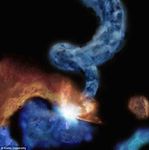
- * Astronomers believe unique twisting shape was created when two clouds collided
- * Pigtail cloud has a huge volume of gas, several hundreds of thousands times greater than the Sun
For thousands of years, people have gazed at the night sky and found things they can relate to their lives on earth.
Where the ancient Greeks saw mythological characters in the stars though, today's scientists have spotted something a little less glamorous.
Astronomers have discovered a molecular cloud, formations in space known as the nursery of an unborn star, which they say looks like a pig's tail.
Comment: The description of pigtails is so childish.... Plasma cosmologists would know that this is a Birkeland current and functions rather like an umbilical cord delivering electrically-conducting plasma and transfering high levels of cosmic energy across the universe. As I wrote in my Tuning the Diamonds book: “Electric currents in plasma form filaments that attract each other at long distances and repel each other at short distances. These filaments tend to braid themselves into “ropes” that act as power transmission lines, with virtually no limit to the distances over which they can operate.” The great Nobel prize winning electrical engineer and plasma cosmologist Hannes Alfvén, was generally shunned for suggesting the universe was intrinsically plasma based and then pointing out what would be the obvious electromagnetic properties and features of the universe. Of course, since he was pointing out the obvious, he has been proven right over and over again. He wrote:
“Space is filled with a network of currents which transfer energy and
momentum over large or very large distances. The currents often pinch to
filamentary or surface currents. The latter are likely to give space, as also
interstellar and intergalactic space, a cellular structure.
One of the notable characteristics of space plasma, revealed by satellites and
space probes, is its tendency to form sharp boundaries between plasmas
with different properties. This tendency towards “cellular structure” can
have profound astrophysical implications such as generating electric fields in
space and providing sources of energy for driving electric currents over very
large distances.” [59]
The large scale 'strings' in space have been called the Cosmic Web, but overall astronomers will accept warm fuzzy magnetic fields in space but have prefered to shun the reality of electric fields and electric currents in space. Well, this is quickly changing because the data being returned from space probes tells us that the local of environment of Earth is being charged up by an influx of cosmic dust and the satellite communications industry has no interest in supporting old outdated ideas. The ferocity of space weather cannot be ignored and the implications of the true nature of the universe are very clear. We live in a visible universe that is known to be 99.99% plasma, but this state of matter is charged and due to space climate change, highly charged plasma is currently flooding our planet as predicted by those interested in the existence of major astronomical cycles. I have wrote my ebook The Electrotechnics of the Heavens because I felt it was important that people understood why NASA scientists were informing the media that our planet could be 'zapped' by the Sun... Yes, great big electrical shocks to the whole planet...
Moon's magnetic umbrellas may shield future spaceships
New Scientist, 3rd September 2012
"Lunar watchers have been crying over spilt milk for decades. But now the mystery of milky splotches on the moon's surface might finally be solved: sections of soil are being protected by weak but effective magnetic bubbles.
The work could help spaceship builders devise magnetic shielding to protect astronauts on future missions fro
A Ring of Truth
Thunderbolts.info, 17th September 2012
 Rings around stars confirm Electric Universe theory.
Rings around stars confirm Electric Universe theory.
A recent press release from the European Space Agency announces that a ring around the star Fomalhaut (Fo-mal-HOUT) demonstrates “the glow from dust in the debris disc – a structure resembling the Kuiper Belt in the primordial Solar System – around the young star Fomalhaut. Detailed studies suggest that the dust in this debris disc consists of “fluffy” aggregates of grains, which are produced by the frequent collisions taking place between comets within the disc.” [...]
Astronomers believe that fluffy dust aggregates in the Solar System arise from collisions between comets, so they assume that the fluffy dust observed in the debris disc of Fomalhaut derives from cometary collisions, too. However, radiation pressure from the star should effectively blow such fluffy particles away: “this blow-out effect must be compensated by a steady production of dust particles via comet collisions,” notes co-author Carsten Dominik from the University of Amsterdam and Radboud Universiteit Nijmegen, which means the dust particles are being replenished by cometary impacts.
Comment: Scientists have adopted a principle called Occam's Razor, where if there are two competing theories that make exactly the same predictions, the simpler one is considered to be better. Invariably, in cosmology and astronomy, Plasma Cosmology or even the more speculative Electric Universe theory is always the most simple, thus fulfilling Occam's Razor.... Here, standard astronomical theory is shown by some basic calculations to be highly speculative...
Image of the Day: The Spectacular Vela Supernova Remnant
Daily Galaxy, 12th September 2012
 The Pencil Nebula is pictured in a new image from ESO's La Silla Observatory in Chile. This peculiar cloud of glowing gas is part of a huge ring of wreckage left over after a supernova explosion that took place about 11 000 years ago. This detailed view was produced by the Wide Field Imager on the MPG/ESO 2.2-metre telescope. [...]
The Pencil Nebula is pictured in a new image from ESO's La Silla Observatory in Chile. This peculiar cloud of glowing gas is part of a huge ring of wreckage left over after a supernova explosion that took place about 11 000 years ago. This detailed view was produced by the Wide Field Imager on the MPG/ESO 2.2-metre telescope. [...]
This oddly shaped cloud, which is also known as NGC 2736, is a small part of a supernova remnant in the southern constellation of Vela (The Sails). These glowing filaments were created by the violent death of a star that took place about 11 000 years ago. The brightest part resembles a pencil; hence the name, but the whole structure looks rather more like a traditional witch's broom.
Comment: The witch's broom feature is obviously highly filamentary plasma... This is the response at Thunderbolts.info,
Plasma Twisting and Rock Banging
Astronomers measure largest-ever magnetic field around massive star
PhysOrg.com, 11th September 2012
 Phys.org)–A group of astronomers led by Gregg Wade of the Royal Military College of Canada have used the Hobby-Eberly Telescope (HET) at The University of Texas at Austin's McDonald Observatory and the Canada-France Hawaii Telescope (CFHT) on Hawaii's Mauna Kea to measure the most magnetic massive star yet. Their work is published in today's issue of the research journal Monthly Notices of the Royal Astronomical Society.
Phys.org)–A group of astronomers led by Gregg Wade of the Royal Military College of Canada have used the Hobby-Eberly Telescope (HET) at The University of Texas at Austin's McDonald Observatory and the Canada-France Hawaii Telescope (CFHT) on Hawaii's Mauna Kea to measure the most magnetic massive star yet. Their work is published in today's issue of the research journal Monthly Notices of the Royal Astronomical Society.
The star's magnetic field is 20,000 times stronger than the Sun's, and almost 10 times stronger than that detected around any other high-mass star. At about 35 times the Sun's mass, the O-type star NGC 1624-2 lies in the open star cluster NGC 1624, about 20,000 light-years away in the constellation Perseus.
This star is an extreme case study to help astronomers better understand all massive stars, which play an important role in the evolution of galaxies.
Comment: Shakes head... It seems that astronomers are still talking in 'baby-talk' plasma physics. We have the example here of "...the star is slowed down because it has to drag its wind around–because the wind is bound to the magnetic field." Baby language... Anyway, it seems astronomers are getting into some holistic principles here, as it is reported: "The star's magnetic field also influences the internal structure... Thus the magnetic field can strongly influence a massive star's life, from birth to supernova death." That makes a direct comparison with morphogenetic fields that control any form of physical life from birth to death. For those interested in philosophical contemplation and have done enough study, it is interesting to consider ancient religious texts that acknowledge the stars as being gods....
The magnetic field of a star in the constellation of Perseus can pull all the iron from human blood
hainanwel.com, 12th September 2012
Pigs (tails) in space: The incredible massive twisting gas cloud spotted 30,000 light years away
Daily Mail, 5th September 2012

- * Astronomers believe unique twisting shape was created when two clouds collided
- * Pigtail cloud has a huge volume of gas, several hundreds of thousands times greater than the Sun
For thousands of years, people have gazed at the night sky and found things they can relate to their lives on earth.
Where the ancient Greeks saw mythological characters in the stars though, today's scientists have spotted something a little less glamorous.
Astronomers have discovered a molecular cloud, formations in space known as the nursery of an unborn star, which they say looks like a pig's tail.
Comment: The description of pigtails is so childish.... Plasma cosmologists would know that this is a Birkeland current and functions rather like an umbilical cord delivering electrically-conducting plasma and transfering high levels of cosmic energy across the universe. As I wrote in my Tuning the Diamonds book: “Electric currents in plasma form filaments that attract each other at long distances and repel each other at short distances. These filaments tend to braid themselves into “ropes” that act as power transmission lines, with virtually no limit to the distances over which they can operate.” The great Nobel prize winning electrical engineer and plasma cosmologist Hannes Alfvén, was generally shunned for suggesting the universe was intrinsically plasma based and then pointing out what would be the obvious electromagnetic properties and features of the universe. Of course, since he was pointing out the obvious, he has been proven right over and over again. He wrote:
“Space is filled with a network of currents which transfer energy and
momentum over large or very large distances. The currents often pinch to
filamentary or surface currents. The latter are likely to give space, as also
interstellar and intergalactic space, a cellular structure.
One of the notable characteristics of space plasma, revealed by satellites and
space probes, is its tendency to form sharp boundaries between plasmas
with different properties. This tendency towards “cellular structure” can
have profound astrophysical implications such as generating electric fields in
space and providing sources of energy for driving electric currents over very
large distances.” [59]
The large scale 'strings' in space have been called the Cosmic Web, but overall astronomers will accept warm fuzzy magnetic fields in space but have prefered to shun the reality of electric fields and electric currents in space. Well, this is quickly changing because the data being returned from space probes tells us that the local of environment of Earth is being charged up by an influx of cosmic dust and the satellite communications industry has no interest in supporting old outdated ideas. The ferocity of space weather cannot be ignored and the implications of the true nature of the universe are very clear. We live in a visible universe that is known to be 99.99% plasma, but this state of matter is charged and due to space climate change, highly charged plasma is currently flooding our planet as predicted by those interested in the existence of major astronomical cycles. I have wrote my ebook The Electrotechnics of the Heavens because I felt it was important that people understood why NASA scientists were informing the media that our planet could be 'zapped' by the Sun... Yes, great big electrical shocks to the whole planet...
Moon's magnetic umbrellas may shield future spaceships
New Scientist, 3rd September 2012
"Lunar watchers have been crying over spilt milk for decades. But now the mystery of milky splotches on the moon's surface might finally be solved: sections of soil are being protected by weak but effective magnetic bubbles.
The work could help spaceship builders devise magnetic shielding to protect astronauts on future missions fro
My Friend Flicker: What causes the rapid changes observed in Orion Nebula “protostars”?
Thunderbolts, 9th August 2012
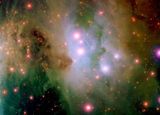 Using a combination of NASA's Spitzer Space Telescope and the ESA Herschel Space Observatory, astronomers found that so-called “young stars” are changing in brightness much faster than they thought possible. Instead of taking several years for material in the gaseous envelopes surrounding the proplyds to heat up and cool down, it is happening in weeks. [...]
Using a combination of NASA's Spitzer Space Telescope and the ESA Herschel Space Observatory, astronomers found that so-called “young stars” are changing in brightness much faster than they thought possible. Instead of taking several years for material in the gaseous envelopes surrounding the proplyds to heat up and cool down, it is happening in weeks. [...]
One possibility, not considered by contemporary astrophysicists, is that electrical oscillations are causing the relatively rapid flicker. The changes observed by the two telescopes are not mechanically generated by gases heating up and cooling down as a recent press release describes: “…lumpy filaments of gas are funnelling from the outer disc towards central regions near the star, temporarily warming the inner disc and leading it to brighten. Another scenario is that cold material is piling up at the inner edge and casting shadows on the outer disc, causing it to darken temporarily.”
Instead, it is the capacitive, resistive, and inductive electrical environment in the Orion Nebula that is causing the material to change in brightness. Plasma's behavior is driven by conditions in cosmic electric circuits. According to Electric Universe theory, fluctuations in those circuits can form double layers in the Nebula with large potential voltages between them. Electromagnetic forces draw matter from the surrounding space into filaments. The electrical power pushes them into “glow mode”.
Comment: Once you study enough plasma cosmology, the fact we live in an electromagnetic universe becomes impossible to dismiss.... Therefore, it is beyond strange that so many astronomers are still in the dark coming up with ridiculous explanations to avoid the inevitable facts of how our universe operates... A good example is stars feeding off other stars to supply electrons..... that's a really bizarre explanation for where the supply of electrons comes from to power up lower mass stars [white dwarfs] causing them to supernovae. By the way, this is another major issue because it is a fact that stars can flicker over a few days and that means the process that powers stars cannot be nuclear fusion... Obviously, this latest embarrassing fact is swept under the celestial rug, but it means standard cosmological theory is becoming more and more untenable as the facts point to electromagnetic forces operating in the universe. We can only presume that astronomers don't want to become too technical and understand some plasma cosmology and the obvious electrical engineering of the cosmos...Understanding the true nature of the cosmos is now very important due to the electromagnetic implications of space weather, so I wrote another e-book, The Electrotechnics of the Heavens.
Disappeared Dust Amazes Astronomers
Sci News, 9th July 2012
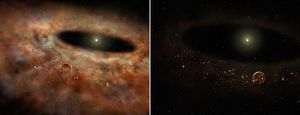 An international team of astronomers has announced a baffling discovery never seen before: an extraordinary amount of dust around a nearby star mysteriously disappeared.
An international team of astronomers has announced a baffling discovery never seen before: an extraordinary amount of dust around a nearby star mysteriously disappeared.
This cosmic vanishing act occurred around a star some 450 light years from Earth, in the direction of the constellation Centaurus.
“It's like the classic magician's trick – now you see it, now you don't,” said Dr Carl Melis, a postdoctoral scholar at the University of California in San Diego and lead author of a paper describing the discovery in the journal Nature. “Only in this case, we're talking about enough dust to fill an inner solar system, and it really is gone!”
“It's as if the rings around Saturn had disappeared,” said co-author Prof Benjamin Zuckerman of the University of California in Los Angeles. “This is even more shocking because the dusty disc of rocky debris was bigger and much more massive than Saturn's rings. The disc around this star, if it were in our Solar system, would have extended from the Sun halfway out to Earth, near the orbit of Mercury.”
Comment: The Electric Universe interpretation of this disappearance is simple, the lights have been switched off.... See the explanation below. We need more examples like this to force astronomers to realise that we live in an electromagnetic universe, where electric currents can literally switch on and off from glow and even arc mode into dark mode. The universe is far more dynamic than astronomers and cosmologists currently want to admit (please excuse the pun.)
-
Seeking What is Hidden
Thunderbolts Info, 6th July 2012
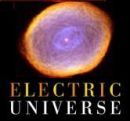 What happened to the ring of dust circling TYC 8241 2652 in the constellation Centaurus? [...]
A recent press release expresses surprise and confusion about the absence of a stellar dust ring that seems to have vanished without a trace. What is most surprising to astronomers is that the ring performed this disappearance in a way contrary to any expectations. If dust clouds are to go missing from observations, they should do so in an orderly fashion.
What happened to the ring of dust circling TYC 8241 2652 in the constellation Centaurus? [...]
A recent press release expresses surprise and confusion about the absence of a stellar dust ring that seems to have vanished without a trace. What is most surprising to astronomers is that the ring performed this disappearance in a way contrary to any expectations. If dust clouds are to go missing from observations, they should do so in an orderly fashion.
"Electric stars aren't begotten in nebular clouds, their progenitor is charge separation. Everything we see in the Universe is ionized to some degree, therefore it is plasma. According to Electric Universe theory, the definition of “plasma” is not the conventional one of “ionized gas.” It is that confused apprehension of plasma that falls back on ideas about gas behavior and thermal effects. Gravity, density, compression, and mechanical phenomena give way to plasma physics.
It is the capacitive, resistive, and inductive electrical environment in and around stars that causes the materials to change in brightness. Therefore, the plasma torus generated by TYC 8241 2652 is most likely no longer energetic enough to be visible to our instruments. It is possible that the falloff of electric power caused the ring to switch off."
Ancient text may solve cosmic mystery
UPI News, 28th June 2012
"SANTA CRUZ, Calif., June 28 (UPI) -- An ancient text about a "red crucifix" seen in British evening skies more than 1,200 years ago could explain a mysterious radiation spike, U.S. scientists say.
The phenomenon in 774 A.D. may have been a previously unrecognized supernova explosion and could explain a mysterious spike in carbon-14 levels in that year's growth rings in Japanese cedar trees, Nature reported Wednesday."
Scientists Twist Light to Send Data
USC Media, 25th June 2012
USC-led team demonstrates that beams of light can be twisted and combined to transmit data at dramatically increased speeds
I think this helps the theory of Multi-dimensional Reality and the role of pulsars and magnetars as data emitters.
Ancient Galaxy Close Encounter Created Giant Gas 'Bridge'
Space.com, 12th June 2012
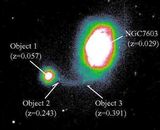 NCHORAGE, Alaska – Two galaxies near our own Milky Way may have had a close encounter billions of years ago that created a vast bridge of gas that links them together to this day, a new study finds.
NCHORAGE, Alaska – Two galaxies near our own Milky Way may have had a close encounter billions of years ago that created a vast bridge of gas that links them together to this day, a new study finds.
Observations from the National Science Foundation's Green Bank Telescope, a massive radio instrument in Green Bank, W.Va., indicate that hydrogen gas may be streaming between the colossal Andromeda Galaxy, or M31, and its neighboring Triangulum Galaxy, or M33.
Comment: Well, the astronomer Halton Arp will have something to say about these "bridges" which are obviously Birkeland currents with "knots" due to the z-pinch effect. Presumably if this bridge is big enough, these clumps will turn into stars... But this is all such old news.... The astronomer Halton Arp in the 1980s pointed out that quasars and other young high redshift objects are often connected to nearby galaxies by a bridge of plasma that acts as an umbilical cord. Thus active galaxies "give birth" to high redshift quasars and companion galaxies. This means that redshift is a measure of the relative ages of nearby quasars and galaxies, not their distance. For his sin of pointing out an explanation that did not support Big Bang theory, Arp's telescope time was denied, papers rejected, and he was forced to leave the US to pursue his work. These days, more astronomers are getting interested in reality rather than providing spurious observations and theory to support science fiction. But I imagine Halton Arp was quite lonely for many years.... More info below:
Trends in Cosmology: Beyond the Big Bang
David Pratt, May 2012
Saturn moon spouts plasma unlike any seen before
New Scientist, 8th June 2012
 A NEW form of matter surrounds Saturn - a plasma put there by Enceladus, the planet's tiny moon.
A NEW form of matter surrounds Saturn - a plasma put there by Enceladus, the planet's tiny moon.
"It's a type of charged particle that has never been observed before," says Tom Hill of Rice University in Houston, Texas.
Shortly after it arrived at the Saturn system in 2004, the Cassini spacecraft discovered that the small icy moon Enceladus was spouting a watery geyser. The plume contained water vapour, as well as micrometre-sized dust grains.
Yet in 2009, Cassini saw something else in the plume: nanometre-sized grains that each carried an electric charge. That meant the plume was a powerful source of plasma, a form of matter in which positively and negatively charged particles move around separately. It seems that Enceladus provides most of the plasma in the magnetic bubble, or magnetosphere, surrounding Saturn.
Comment: So, less than two weeks ago, we were told that our moon was electric and that explains why it is much much brighter these days accept for when it is shrouded by cosmic dust... But now, we are told that Saturn's moon Enceladus, is so electrified that it is actually charging up the atmosphere of the giant gas planet Saturn with plasma.... Worse still, with a new type of particle that has never been seen before.... Hmmm.... major changes have been taking place in all the planets in our solar system. In the last two decades, mainstream astronomers have reported change after change but they don't explain what is driving the changes. However, we know for a fact that highly charged cosmic dust and matter is flooding our solar system.
Saturn's Geyser Moon Enceladus Provides a New Kind of Plasma Laboratory
Science Daily, 1st June 2012
"Ninety-nine percent of the matter in the universe is thought to be in the form of plasma, so scientists have been using Saturn as a site other than Earth to observe the behavior of this cloud of ions and electrons directly."
Hmmm.... All of a sudden, space scientists are happy to talk about how much plasma there is in the universe, especially now that we are seeing a lot more of it in our solar system and around Earth.... This article provides a major clue as to what is going on if you have done the requisite scientific research on what is happening in our solar system.
Enceladus is erupting!
Discover Bad Astronomy Blog, 23rd February 2010
Transit of Venus today may reveal the “Mysterious Arc of Venus”
WUWT, 5th June 2012
When Venus transits the sun on June 5th and 6th, an armada of spacecraft and ground-based telescopes will be on the lookout for something elusive and, until recently, unexpected: The Arc of Venus.
“I was flabbergasted when I first saw it during the 2004 transit,” recalls astronomy professor Jay Pasachoff of Williams College. “A bright, glowing rim appeared around the edge of Venus soon after it began to move into the sun.”
For a brief instant, the planet had turned into a “ring of fire.”
Comment: Now that is interesting.... I wonder if the same thing will happen again....Stay tuned...
Transit of Venus: June 6, 2012 [Europe]
Celestial Events, 5th June 2012
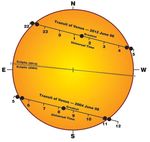 On June 6, 2012 a really important and historic event takes place: The last transit of Venus that anyone living on this planet today can expect to watch. Due its rarity and its importance for science in history this transit will be one of the most important celestial events of the 21. century. In Europe the whole transit can be observed to the north of the Polar circle, for instance in Norway: Venus transits the midnight Sun!
On June 6, 2012 a really important and historic event takes place: The last transit of Venus that anyone living on this planet today can expect to watch. Due its rarity and its importance for science in history this transit will be one of the most important celestial events of the 21. century. In Europe the whole transit can be observed to the north of the Polar circle, for instance in Norway: Venus transits the midnight Sun!
JUNE 5 FROM 11 pm until JUNE 6, 0715 a
HISTORIC TRANSIT OF VENUS ON THE MIDNIGHT SUN
However, due to the midnight Sun the entire transit will be visible from Northern Norway (as well as Sweden, some areas in Finland and Spitsbergen). A number of public events, as well as live streaming and webcasts are planned for this historic occasion. If you want to experience something quite unique it could be a good idea to head for the far north! More information will be available here soon.
Comment: I am sure the Norwegians and Swedes are pleased..... Well, if my metaphysical source on Venus is correct, then this transit will be very important as we are told that Venus (Goddess of Love, representing 'female' energy) transit is likely to switch something back on in the Sun ('male' energy) and then an extra 're-balancing' process will be over..... I don't want to be sarcastic, but I have not noticed any great trend in people's behaviour but the Sun has been very quiet and difficult to predict, see archives ... Whatever, I will be looking for some evidence in the next few weeks and months for a change in the Sun's magnetic index (see archives for further details). This is a NASA page with webcast websites following the transit Live Venus Transit Webcasts
NASA gets two military spy telescopes for astronomy
Washington Post, 4th June 2012
 The secretive government agency that flies spy satellites has made a stunning gift to NASA: two exquisite telescopes as big and powerful as the Hubble Space Telescope. They've never left the ground and are in storage in Rochester, N.Y.
The secretive government agency that flies spy satellites has made a stunning gift to NASA: two exquisite telescopes as big and powerful as the Hubble Space Telescope. They've never left the ground and are in storage in Rochester, N.Y.
It's an unusual technology transfer from the military-intelligence space program to the better-known civilian space agency. It could be a boost for NASA's troubled science program, which is groaning under the budgetary weight of the James Webb Space Telescope, still at least six years from launch.
Or it could be a gift that becomes a burden. NASA isn't sure it can afford to put even one of the two new telescopes into orbit.
Comment: There is an interesting discussion about this over at ATS NASA gets two military spy telescopes for astronomy,.
Electric Moon Jolts the Solar Wind
NASA Science News, 30th May 2012
 [...] Unlike Earth, the moon is not surrounded by a global magnetic field. "It was thought that the solar wind crashes into the lunar surface without any warning or 'push back' on the solar wind," says Dr. Andrew Poppe of the University of California, Berkeley. Recently, however, an international fleet of lunar-orbiting spacecraft has detected signs of the moon's presence "upstream" in the solar wind. "We've seen electron beams and ion fountains over the moon's day side," says Dr. Jasper Halekas, also of the University of California, Berkeley.
[...] Unlike Earth, the moon is not surrounded by a global magnetic field. "It was thought that the solar wind crashes into the lunar surface without any warning or 'push back' on the solar wind," says Dr. Andrew Poppe of the University of California, Berkeley. Recently, however, an international fleet of lunar-orbiting spacecraft has detected signs of the moon's presence "upstream" in the solar wind. "We've seen electron beams and ion fountains over the moon's day side," says Dr. Jasper Halekas, also of the University of California, Berkeley.
These phenomena have been seen as far as 10,000 kilometers (6,214 miles) above the moon and generate a kind of turbulence in the solar wind ahead of the moon, causing subtle changes in the solar wind's direction and density. The electron beams were first seen by NASA's Lunar Prospector mission, while the Japanese Kaguya mission, the Chinese Chang'e mission, and the Indian Chandrayaan mission all saw ion plumes at low altitudes. NASA's ARTEMIS mission has now also seen both the electron beams and the ion plumes, plus newly identified electromagnetic and electrostatic waves in the plasma ahead of the moon, at much greater distances from the moon. "With ARTEMIS, we can see the plasma ring and wiggle a bit, surprisingly far away from the moon," says Halekas. ARTEMIS stands for "Acceleration, Reconnection, Turbulence and Electrodynamics of the Moon's Interaction with the Sun".
Comment: It's interesting how space scientists are changing their tune.... Until recently, Electric Universe theorists were treated like heretics, but due to space weather charging up the planets and moons, as well as causing havoc with our satellites communication infrastructure etc, a paradigm shift is taking place. Yes, we are experiencing Space Climate Change to the point that electrical engineers are terrified of what can happen if Earth experiences a major solar blast (see the space weather archives for info and major reports). So, all of a sudden, space scientists are becoming enlightened and the moon is electric.... This is from wikipedia about the moon's intrinsic magnetic field.
The Moon has an external magnetic field of the order of one to a hundred nanoteslas, less than one-hundredth that of the Earth. It does not currently have a global dipolar magnetic field, as would be generated by a liquid metal core geodynamo, and only has crustal magnetization, probably acquired early in lunar history when a geodynamo was still operating.[73][74] Alternatively, some of the remnant magnetization may be from transient magnetic fields generated during large impact events, through the expansion of an impact-generated plasma cloud in the presence of an ambient magnetic field–this is supported by the apparent location of the largest crustal magnetizations near the antipodes of the giant impact basins.[75]
The Moon - Wikipedia
Like all cosmic objects in our solar system, the moon has it's own plasmasphere within the Sun's plasmasphere. Now we are being told that the moon's plasmasphere extends out to 10,000 kilometers (6,214 miles). The point of separation is called a double layer that forms to differentiate electrical environments. Within double layers, there are strong electric fields that can accelerate particles and this is where the electron beams are being generated combined with currents of electrons and ions. This all implies that the moon is now much more highly charged... I even wonder how powerful these electron beams are.... that would be something else, killer electrons coming from the moon to add to the space weather we are already getting....
Ghostly gamma-ray beams blast from Milky Way's center
PhysOrg.com, 29th May 2012
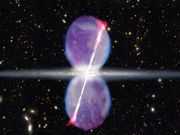 "These faint jets are a ghost or after-image of what existed a million years ago," said Meng Su, an astronomer at the Harvard-Smithsonian Center for Astrophysics (CfA), and lead author of a new paper in the Astrophysical Journal.
"They strengthen the case for an active galactic nucleus in the Milky Way's relatively recent past," he added.
"These faint jets are a ghost or after-image of what existed a million years ago," said Meng Su, an astronomer at the Harvard-Smithsonian Center for Astrophysics (CfA), and lead author of a new paper in the Astrophysical Journal.
"They strengthen the case for an active galactic nucleus in the Milky Way's relatively recent past," he added.
The two beams, or jets, were revealed by NASA's Fermi space telescope. They extend from the galactic center to a distance of 27,000 light-years above and below the galactic plane. They are the first such gamma-ray jets ever found, and the only ones close enough to resolve with Fermi. [...]
The two structures also formed differently. The jets were produced when plasma squirted out from the galactic center, following a corkscrew-like magnetic field that kept it tightly focused. The gamma-ray bubbles likely were created by a "wind" of hot matter blowing outward from the black hole's accretion disk. As a result, they are much broader than the narrow jets.
Comment: Another astronomical surprise... It reminds me of magnetic poles, like Earth's magnetic poles.... it also reminds me of the figure-8 magnetic field that exists close to the Earth.... (I picked up the information from Rawls & Davis who spent decades each researching magnetism...) I also suspect that in a high energy plasma environment on Earth, this pole would form the basis of the 'mythical' Axis Mundi. This is really important to understand if Earth is charging up and approaching the energy level that equates to "Paradise"....
Newfound exoplanet may turn to dust
MIT News, 18th May 2012
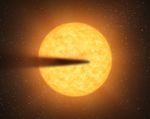 Researchers at MIT, NASA and elsewhere have detected a possible planet, some 1,500 light years away, that appears to be evaporating under the blistering heat of its parent star. The scientists infer that a long tail of debris – much like the tail of a comet – is following the planet, and that this tail may tell the story of the planet's disintegration. According to the team's calculations, the tiny exoplanet, not much larger than Mercury, will completely disintegrate within 100 million years.
Researchers at MIT, NASA and elsewhere have detected a possible planet, some 1,500 light years away, that appears to be evaporating under the blistering heat of its parent star. The scientists infer that a long tail of debris – much like the tail of a comet – is following the planet, and that this tail may tell the story of the planet's disintegration. According to the team's calculations, the tiny exoplanet, not much larger than Mercury, will completely disintegrate within 100 million years.
Comment: What astronomers are saying is that they have found a planet behaving like a comet... Not including the time spent in research for my book Tuning the Diamonds, I spent a further 1 year researching for my e-book The Electrotechnics of the Heavens . Over that time, it appears that astronomers are resigning themselves to the fact that the universe operates on a continuum, the more they know the more that their astronomical definitions keep breaking down. This planetary object is causing two headaches, it is in orbit around a sun but the period is like 15 hours, that is fast.... we can compare that for 1 year for our Earth... what's more, it is discharging like a comet with a huge dusty tail.... This is a tremendously interesting astrophysical enigma.
IBEX Reveals a Missing Boundary At the Edge Of the Solar System (VIDEO)
NASA/IBEX News, 10th May 2012
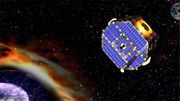 For the last few decades, space scientists have generally accepted that the bubble of gas and magnetic fields generated by the sun – known as the heliosphere – moves through space, creating three distinct boundary layers that culminate in an outermost bow shock. This shock is similar to the sonic boom created ahead of a supersonic jet. Earth itself certainly has one of these bow shocks on the sunward side of its magnetic environment, as do most other planets and many stars. A collection of new data from NASA's Interstellar Boundary Explorer (IBEX), however, now indicate that the sun does not have a bow shock. [...]
For the last few decades, space scientists have generally accepted that the bubble of gas and magnetic fields generated by the sun – known as the heliosphere – moves through space, creating three distinct boundary layers that culminate in an outermost bow shock. This shock is similar to the sonic boom created ahead of a supersonic jet. Earth itself certainly has one of these bow shocks on the sunward side of its magnetic environment, as do most other planets and many stars. A collection of new data from NASA's Interstellar Boundary Explorer (IBEX), however, now indicate that the sun does not have a bow shock. [...]
"We recently analyzed two years worth of IBEX data, and they showed that the speed of the heliosphere – with respect to the local cloud of material – is only 52,000 miles per hour, instead of the previously believed 59,000," says David McComas at the Southwest Research Institute in San Antonio, Texas, who is first author on this paper and also the principal investigator for IBEX. "That might not seem like a huge difference, but it translates to a quarter less pressure exerted on the boundaries of the heliosphere. This means there's a very different interaction, a much weaker interaction, than previously thought."
Comment: This is the official NASA/IBEX press release where again it emphasises that the heliosphere that is created by the sun's solar wind has slowed down 12% in comparison to previous measurements done by the Ulysses space craft in the mid 1990s.
-
A Big Surprise from the Edge of the Solar System
NASA Science News, 9th June 2011 Flashback!
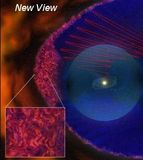 June 9, 2011: NASA's Voyager probes are truly going where no one has gone before. Gliding silently toward the stars, 9 billion miles from Earth, they are beaming back news from the most distant, unexplored reaches of the solar system.
June 9, 2011: NASA's Voyager probes are truly going where no one has gone before. Gliding silently toward the stars, 9 billion miles from Earth, they are beaming back news from the most distant, unexplored reaches of the solar system.
Mission scientists say the probes have just sent back some very big news indeed.
It's bubbly out there.
"The Voyager probes appear to have entered a strange realm of frothy magnetic bubbles," says astronomer Merav Opher of Boston University. "This is very surprising.
Our Sun Is Moving More Slowly Than Thought
Space.com, 10th May 2012
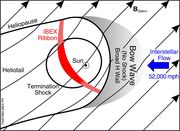
Our slower sun
New observations now show that our sun is traveling slower than before thought. As such, it moves too slowly to generate a bow shock.
"We've now discovered our sun doesn't have a bow shock – it's surprising, and slightly shocking, and much work needs to be redone now," McComas told SPACE.com. "The astronomical community spent the last two or three decades studying something that doesn't exist." [...]
The fact that our solar system lacks a bow shock could actually mean we are slightly more protected from cosmic rays than before thought.
"The slower speed the sun is traveling at with respect to the local interstellar medium means that at the moment, there is less compression of the heliosphere, so there's a larger region to deflect cosmic rays," McComas said. "However, in the distant past, as the sun goes in its orbit around the galaxy, it surely went through dense clouds, so maybe the heliosphere got squeezed then, and we were more affected by galactic radiation. Surely that will happen again in the distant future."
Comment: Click image icon for a bigger version. To be honest, I think McComas sounds confused.... at the moment it is flip-flop about whether we have moved into a denser part of the Local Fluff when all the evidence tells us something has drastically changed... We have to remember that the Russians told us bluntly in the planetophysical report [1998] that there was a "shock wave" infront of the heliosphere that had grown 10 times since the Russians first started to notice some changes starting in the 1960s. Here is the relevant quote:
The Heliosphere [solar system] transition through this structure has led to an increase of the shock wave in front of the Solar System from 3 to 4 AU, to 40 AU, or more. This shock wave thickening has caused the formation of a collusive plasma in a parietal layer, which has led to a plasma overdraft around the Solar System, and then to its breakthrough into interplanetary domains [5,6]. This breakthrough constitutes a kind of matter and energy donation made by interplanetary space to our Solar System.
Planetophysical State of the Earth and Life [1998]
I am now wondering whether it is a coincidence that the Russians used the terminology of a 'wave' or were they simply ahead of the game...
-
Earth's movement around the Sun! Nassim Haramein
YouTube, 4th March 2011 Flashback Reminder!
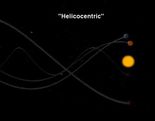 Comment: I have changed the YouTube, headline here because it is flat wrong... As you can see from what Nassim Haramein actually explains, the planets are moving around the sun but that is not the only motion to consider as the sun is moving through space too in it's journey around the galactic centre. Of course, this is not new! The idea that this is a new theory is also absolutely ridiculous, but I decided to highlight the video because I have never seen this vortextual motion of the planets in a video depicting movement through space and this is a great teaching aid, when trying to explain how Earth can be affected by moving through new regions of space.
Comment: I have changed the YouTube, headline here because it is flat wrong... As you can see from what Nassim Haramein actually explains, the planets are moving around the sun but that is not the only motion to consider as the sun is moving through space too in it's journey around the galactic centre. Of course, this is not new! The idea that this is a new theory is also absolutely ridiculous, but I decided to highlight the video because I have never seen this vortextual motion of the planets in a video depicting movement through space and this is a great teaching aid, when trying to explain how Earth can be affected by moving through new regions of space.
Grouping of galaxies puts cosmology "basically in a shambles," scientist says.
Huge "Structure" of Satellites Found Orbiting Milky Way
National Geographic News, 30th April 2012
 A huge "structure" of satellite galaxies and star clusters has been found wheeling around the Milky Way, according to a new study.
The discovery surprised scientists, in part because the structure might spell trouble for theories of dark matter, the mysterious, invisible substance that's thought to make up about 23 percent of the mass in the universe.
A huge "structure" of satellite galaxies and star clusters has been found wheeling around the Milky Way, according to a new study.
The discovery surprised scientists, in part because the structure might spell trouble for theories of dark matter, the mysterious, invisible substance that's thought to make up about 23 percent of the mass in the universe.
The finding is only the latest to question dark matter's existence–last week, for instance, astronomers announced that they'd failed to detect dark matter in the sun's neighborhood, even though the substance should be there, according to accepted theory.[...]
According to this idea, the Milky Way stripped material from the other galaxy, and gravity gathered the debris to form dwarf galaxies and globular clusters, which have remained in a plane around the Milky Way ever since, study leader Pawlowski said.
The team asserts that this model deals a significant blow to dark matter, since it shows that galaxies can form without the theoretical substance.
"It means that we have to completely and utterly rethink cosmology," Kroupa said. "Cosmology is basically in a shambles now."
Comment: Cosmology has been in "Shambles" for a long time according to plasma cosmologists and Electric Universe theorists but there are others who hate all the Big Bang religious stuff and the idea the whole universe appeared from nothing but people are now so skeptical that the standard retort these days is to just say, well what banged? Anyway, I suppose this is good news.... This is such a difficult subject because the belief in the unknown by astronomers is very strong... there is some real love for the metaphysics.... The only thing that puzzles me is that there must be some particles that are invisible to detection and are therefore 'dark' the best example being the neutrino that is no longer 'dark' due to advances in technology.... However, when plasma physicsts create galaxies by computer simulation and even tiny mini-galaxies in the lab by knowing how plasma behaves and the known laws of physics they don't need to take into account any dark matter... So, some believe there is no 'missing' or 'dark' matter but I am not so sure it can be so easily dismissed...
-
Dark Matter Is Missing in Sun's Neighborhood?
National Geographic News, 19th April 2012
Dark matter is mysteriously missing from the sun's neighborhood, according to a new study that could provide ammunition for skeptics who argue that the invisible substance is just an illusion.
-
"There will be people claiming dark matter doesn't exist because of this result," predicted study leader Christian Moni-Bidin, an astronomer at Chile's University of Concepción.
"These observations alone do not prove that dark matter does not exist. Still, it is not where we expected it and where we needed it."
The dark matter crisis: falsification of the current standard model of cosmology
Pavel Kroupa (AIfA, Bonn) (Submitted on 11 Apr 2012)
Cornell University Library, 16th May 2012
Record-breaking radio waves discovered from ultra-cool star
PhysOrg.com, 30th April 2012
My latest book The Electrotechnics of the Heavens explains why astronomers are continously embarrassed by observations of stars that are doing things they are not supposed to do, even though there is postive spin here on this 'failed' star that seems to have a strong magnetic field.... The real question is: where is the power coming from for these dimly lit light bulbs in space to erupt in radio waves?
Enormous LSST Telescope Set for Chile Mountaintop in 2014
Daily Galaxy, 26th April 2012
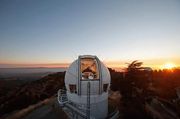 Plans for an enormous telescope, equipped with a 3.2 billion-pixel camera, are ready for detailed designs, its creators announced on April 24. When completed, the Large Synoptic Survey Telescope (LSST) will take photos of every inch of visible night sky every week for 10 years in a kind of time-lapse picture that will provide scientists with unparalleled views of the universe. The telescope is projected for 'first light' in 2014 atop the Cerro Pachón mountain in Chile's Atacama Desert -the world's Southern Hemisphere space-observatory mecca. Researchers have started work on its 8.4-meter (27.6-foot) mirror and on preparing its construction site.
Plans for an enormous telescope, equipped with a 3.2 billion-pixel camera, are ready for detailed designs, its creators announced on April 24. When completed, the Large Synoptic Survey Telescope (LSST) will take photos of every inch of visible night sky every week for 10 years in a kind of time-lapse picture that will provide scientists with unparalleled views of the universe. The telescope is projected for 'first light' in 2014 atop the Cerro Pachón mountain in Chile's Atacama Desert -the world's Southern Hemisphere space-observatory mecca. Researchers have started work on its 8.4-meter (27.6-foot) mirror and on preparing its construction site.
The 8.4-meter telescope will be able to survey the entire visible sky deeply in multiple colors every week with its 3-billion pixel digital camera. The telescope will probe the mysteries of dark matter and dark energy, and it will open a movie-like window on objects that change or move rapidly: exploding supernovae, billions of galaxies, potentially hazardous near-Earth asteroids and distant Kuiper Belt objects, and multiple probes of the mysterious dark matter and dark energy.
Comment: Well, due to Space Weather and Earth being inside an interstellar debris field (cosmic bowling alley that is delivering lots of big and small asteroids), I imagine this new telescope will be very useful. If you have a copy of my latest workbook, The Electrotechnics of the Heavens you will know that this is a very similar version of a space borne system that had been sweeping the skies since 2003, but it's now defunct, probably knocked out by space weather...
Strange Objects Punching Holes Through Saturn's Outer Ring
Wired.com News, 25th April 2012
More strangeness in space....
Astronomers: World may be entering period of global cooling
WUWT, 21st April 2012
"Science by press release is bad style." Actually, I would say that science by press release is 'normal' these days and that is why I prefer to find scientists actually debating the facts before I like to formulate an opinion.
Serious Blow to Dark Matter Theories?
ESO News, 18th April 2012
 The most accurate study so far of the motions of stars in the Milky Way has found no evidence for dark matter in a large volume around the Sun. According to widely accepted theories, the solar neighbourhood was expected to be filled with dark matter, a mysterious invisible substance that can only be detected indirectly by the gravitational force it exerts. But a new study by a team of astronomers in Chile has found that these theories just do not fit the observational facts. This may mean that attempts to directly detect dark matter particles on Earth are unlikely to be successful.
The most accurate study so far of the motions of stars in the Milky Way has found no evidence for dark matter in a large volume around the Sun. According to widely accepted theories, the solar neighbourhood was expected to be filled with dark matter, a mysterious invisible substance that can only be detected indirectly by the gravitational force it exerts. But a new study by a team of astronomers in Chile has found that these theories just do not fit the observational facts. This may mean that attempts to directly detect dark matter particles on Earth are unlikely to be successful.
Comment:
How wrong is wrong? Many people think the "science" is basically good metaphysics, but I have found that most don't understand the metaphysics either... I have a question: what burnt out the Tether in one of NASA's most embarrassing experiments when the joint venture with the Italian space agency, known as the Italian tethered satellite experiment (TSS-1R) on the STS-75 mission that went horribly wrong? Besides frying the computer aboard $442 million Italian satellite that was designed to process the experimental data, the "current" melted the tether and left the one end that was retrieved, looking like "curly french fries".... I would be interested if NASA could enlighten us on where the energy was coming from...
When Planets Gave Birth to Comets
YouTube, 8th April 2012
"Electric Universe proponent David Talbott presents the first of two video segments on the electric comet. Here he discusses NASA's surprising findings on the composition of comets, none supporting the traditional "dirty snowball" hypothesis."
Elenin and the Mystery of Exploding Comets
YouTube, 5th March 2012
"Electric universe proponent David Talbott takes up the Comet Elenin question from a vantage point generally ignored by both the scientific mainstream and the Internet popularizers of Doomsday speculations. What is the relationship of Elenin's catastrophic demise to the larger, unsolved mystery of explosive comet disintegration?"
What still amazes me is all the people who were sucked in by the hoaxers...
NASA Reveals the Photon Belt
Mysterious Objects at the Edge of the Electromagnetic Spectrum
NASA Science News, 16th March 2012
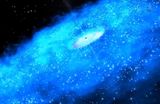 [...] "Fermi is picking up crazy-energetic photons," says Dave Thompson, an astrophysicist at NASA's Goddard Space Flight Center. "And it's detecting so many of them we've been able to produce the first all-sky map of the very high energy universe."
[...] "Fermi is picking up crazy-energetic photons," says Dave Thompson, an astrophysicist at NASA's Goddard Space Flight Center. "And it's detecting so many of them we've been able to produce the first all-sky map of the very high energy universe."
“This is what the sky looks like near the very edge of the electromagnetic spectrum, between 10 billion and 100 billion electron volts.”
The Edge (signup)
The light we see with human eyes consists of photons with energies in the range 2 to 3 electron volts. The gamma-rays Fermi detects are billions of times more energetic, from 20 million to more than 300 billion electron volts.
Comment: If I had not been so depressed, I might have laughed hysterically at the admission by NASA that they might have found the enigmatic Photon Belt.... My immediate thought is how long have they known.... meanwhile the metaphysical community have taken a lot of hits over this Photon Belt and I decided to ignore it in relation to evolutionary change.... At this moment, I am still abiding by one of my respected metaphysical sources that says the affects of this Photon Belt were highly overated by some.
Spectacularly bright object in Andromeda caused by 'normal' black hole
PhysOrg.com, 23rd February 2012
More contradictions by backtracking astronomers...
Cosmic Buckyball Particle 'Factory' Discovered
Discovery News, 22nd February 2012
 For the first time, "buckyballs" have been discovered in the cosmos in a solid form.
For the first time, "buckyballs" have been discovered in the cosmos in a solid form.
Until now, the only evidence in space for the bizarre little hollow balls of carbon atoms have been in interstellar gases, but with the help of NASA's Spitzer Space Telescope, astronomers have discovered buckyballs accumulating and stacking atop one another to form solid particles.
Buckyballs are a nickname for buckminsterfullerines, a geodesic molecular ordering of 60 carbon atoms that resemble the domes designed by American architect and inventor Richard Buckminster Fuller.
Apart from buckyballs that have a curious soccer ball-like shape, the wider family of fullerines are candidates for many industrial applications, from being a superconducting material to hardening body armor. On Earth, buckyballs are found in soot -- the carbon-rich residue that remains after a material has combusted. When they become a solid in the bottom of a test tube, buckminsterfullerines take on a brown "goo-like" form.
Comment: What is interesting to me is that when I was working on someone's energy field, the energy I saw was golden and globular -- large globes like nothing I have ever seen described anywhere -- I was shocked because these were NOT particle sized, I don't even have a scientific reference for what I saw (but maybe giant sized Q-balls) and no metaphysical references either. Hence this article is of great interest....
Coal and petroleum created throughout the universe, study finds
Evolutionary Leaps, 18th February 2012
 New discovery validates my theories.
“Carbon Rain.” That's the title of chapter 12 in Magnetic Reversals and Evolutionary Leaps, wherein I propose that carbon rains from the sky at extinctions. That's why we find dinosaurs buried in coal. And that's why we find oil on Saturn's moon Titan.
New discovery validates my theories.
“Carbon Rain.” That's the title of chapter 12 in Magnetic Reversals and Evolutionary Leaps, wherein I propose that carbon rains from the sky at extinctions. That's why we find dinosaurs buried in coal. And that's why we find oil on Saturn's moon Titan.
Now comes this controversial study published in the journal Nature on 27 Oct 2011.
“An analysis of the spectral emissions from distant stars suggests that compounds of unexpected complexity – some resembling coal and petroleum – exist throughout the universe and are being made by stars,” says writer Kate Melville.
By analyzing the emissions of star dust formed in exploding stars, scientists have found that “stars are making these complex organic compounds in time frames of only weeks.”
Not through some long, drawn-out process taking thousands of years, mind you, but in a mere matter of weeks!
Comment: Ouch! I think it is bad enough that some maverick scientists say that hydrocarbons are manufactured in comet tails but this is far worse.... Scientists saying that “stars are making these complex organic compounds in time frames of only weeks.” I presume that complex molecules are being made in the atmosphere's of certain stars but somehow electromagnetic forces are ejecting this material, in a similar fashion to coronal mass ejections... I imagine that this piece of news will be completely ignored by mainstream astronomers already reeling from the evidence that the universe is not a quiet sedate place ruled by gravity alone, neither does it obey other central cosmological theories too...
Is Venus' Rotation Slowing Down?
Universe Today, 10th February 2012
 New measurements from ESA's Venus Express spacecraft shows that Venus' rotation rate is about 6.5 minutes slower than previous measurements taken 16 years ago by the Magellan spacecraft. Using infrared instruments to peer through the planet's dense atmosphere, Venus Express found surface features weren't where the scientists expected them to be.
New measurements from ESA's Venus Express spacecraft shows that Venus' rotation rate is about 6.5 minutes slower than previous measurements taken 16 years ago by the Magellan spacecraft. Using infrared instruments to peer through the planet's dense atmosphere, Venus Express found surface features weren't where the scientists expected them to be.
“When the two maps did not align, I first thought there was a mistake in my calculations as Magellan measured the value very accurately, but we have checked every possible error we could think of,” said Nils Müller, a planetary scientist at the DLR German Aerospace Centre, lead author of a research paper investigating the rotation.
Comment: Major News! Think of Venus and all the planets as spinning in a thick cosmic 'aetheric' soup and when the consistency of this soup changes, the planet's rotation will be affected. A major change happened on Earth when the Earth's year changed from a beautiful 360 days in a years to an obnoxious astronomical 'pain in the backside' 365 days in a year. Some think this was caused by a large comet getting too close, but regardless of how this happened, we know that all the ancient calendars were forced to change and ancient astronomers were none too thrilled... There is a report in 2007 of the rate of rotation of the planet Saturn speeding up by 15 minutes, but this is a little more controversial due to the methodology used, see below:
Length of Saturn's Day Revised
Space.com, 6th September 2007
"Using data collected by NASA's Cassini, Pioneer and Voyager spacecraft, scientists have revised the ringed planet's rotation period to 10 hours, 32 minutes and 35 seconds-about 15 minutes shorter than an estimate made only last year."
Glowing Nebula Looks Like Giant Human Face in New Photo
Space.com, 1st February 2012
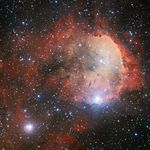 The wispy clouds of a distant nebula bursting with newborn stars take on an eerie face-like shape sculpted by stellar winds in a new photo snapped by a telescope in Chile.
The wispy clouds of a distant nebula bursting with newborn stars take on an eerie face-like shape sculpted by stellar winds in a new photo snapped by a telescope in Chile.
The hotbed of star birth, called NGC 3324, is full of hot young stars, whose ultraviolet radiation is making the gas clouds glow. The stellar wind and radiation from the newborn stars has also punched out a cavity in the surrounding gas and dust. The edge of the wall of gas and dust at the right in the photo resembles the profile of a human face, with a ridge in the center that looks like a nose.
Astronomers often attach nicknames to nebulas based on their shape and their earthly likenesses. NGC 3324 is sometimes called the Gabriela Mistral nebula, after the Nobel Prize-winning poet from Chile, ESO officials said.
Comment: Now this is getting creepy, clouds, auroras and now space nebula...
"Alien" Particles Found Invading Our Solar System–A First
NASA probe detects matter from interstellar space.
National Geographic News, 31st January 2012
 [...] But half of the particles in the interstellar wind are neutral, and these uncharged atoms can make it into our solar system.
[...] But half of the particles in the interstellar wind are neutral, and these uncharged atoms can make it into our solar system.
A few of these neutral hydrogen, oxygen, and neon particles then made it all the way to Earth, where IBEX was able to detect them, McComas said during the conference.
"I like to call it the 15-billion-mile [24-billion-kilometer] hole-in-one," he said.
Comment: OK, there is less gibberish in this article. IBEX is detecting these interstellar particles AROUND EARTH! Well, there are other intergalactic winds that blow on a regular basis into our solar system and affect us on Earth... this is a typical bite-sized press release that certainly does not explain the Big Picture.
IBEX spacecraft measures 'alien' particles from outside solar system
PhysOrg.com, 31st January 2012
 Using data from NASA's Interstellar Boundary Explorer (IBEX) spacecraft, an international team of researchers has measured neutral "alien" particles entering our solar system from interstellar space. A suite of studies published in the Astrophysical Journal provide a first look at the constituents of the interstellar medium, the matter between star systems, and how they interact with our heliosphere. [...]
Using data from NASA's Interstellar Boundary Explorer (IBEX) spacecraft, an international team of researchers has measured neutral "alien" particles entering our solar system from interstellar space. A suite of studies published in the Astrophysical Journal provide a first look at the constituents of the interstellar medium, the matter between star systems, and how they interact with our heliosphere. [...]
Based on the older Ulysses data, researchers had theorized that the heliosphere was leaving the local galactic cloud and transitioning into a new region of space. However, while the boundary is very close, IBEX results show the heliosphere remains fully in the local cloud, at least for the moment.
"Sometime in the next hundred to few thousand years, the blink of an eye on the timescales of the galaxy, our heliosphere should leave the local interstellar cloud and encounter a much different galactic environment," McComas says.
Comment:So the crystalline neutrally charged particles flooding our solar system are now being called 'alien' particles... Hmmm.... [Btw, many of these interstellar particles don't stay neutral....] There are some scientists who think we have already left the Local Cloud and the upset with the Sun in solar cycle 23 was the proof. If you look about, you will find scientific articles and references to papers that state we are now in a transition zone. The terrible video provide here even shows that the Sun seems to have left the Local Cloud and has hit the transition zone that buffers 'G Cloud' or 'Galactic Cloud', so-called because it is moving towards us from the direction of galactic centre. This is a strange and unconvincing statement....
NASA to Discuss Discoveries of Material from Beyond Solar System
Space.com, 31st January 2012
IBEX spacecraft measures 'alien' particles from outside solar system
PhysOrg.com, 31st January 2012
 Using data from NASA's Interstellar Boundary Explorer (IBEX) spacecraft, an international team of researchers has measured neutral "alien" particles entering our solar system from interstellar space. A suite of studies published in the Astrophysical Journal provide a first look at the constituents of the interstellar medium, the matter between star systems, and how they interact with our heliosphere. [...]
Using data from NASA's Interstellar Boundary Explorer (IBEX) spacecraft, an international team of researchers has measured neutral "alien" particles entering our solar system from interstellar space. A suite of studies published in the Astrophysical Journal provide a first look at the constituents of the interstellar medium, the matter between star systems, and how they interact with our heliosphere. [...]
Based on the older Ulysses data, researchers had theorized that the heliosphere was leaving the local galactic cloud and transitioning into a new region of space. However, while the boundary is very close, IBEX results show the heliosphere remains fully in the local cloud, at least for the moment.
"Sometime in the next hundred to few thousand years, the blink of an eye on the timescales of the galaxy, our heliosphere should leave the local interstellar cloud and encounter a much different galactic environment," McComas says.
Comment:So the crystalline neutrally charged particles flooding our solar system are now being called 'alien' particles... Hmmm.... There are some scientists who think we have already left the Local Cloud and the upset with the Sun in solar cycle 23 was the proof. If you look about, you will find scientific articles and references to papers that state we are now in a transition zone. The terrible video provide here even shows that the Sun seems to have left the Local Cloud and has hit the transition zone that buffers 'G Cloud' or 'Galactic Cloud', so-called because it is moving towards us from the direction of galactic centre. This is a strange and unconvincing statement....
NASA to Discuss Discoveries of Material from Beyond Solar System
Space.com, 31st January 2012
A galactic magnetic field in a lab bolsters astrophysical theory
PhysOrg.com, 25th January 2012
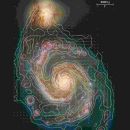 Why is the universe magnetized? It's a question scientists have been asking for decades. Now, an international team of researchers including a University of Michigan professor have demonstrated that it could have happened spontaneously, as the prevailing theory suggests. The findings are published in the Jan. 26 edition of Nature. Oxford University scientists led the research.
Why is the universe magnetized? It's a question scientists have been asking for decades. Now, an international team of researchers including a University of Michigan professor have demonstrated that it could have happened spontaneously, as the prevailing theory suggests. The findings are published in the Jan. 26 edition of Nature. Oxford University scientists led the research.
"According to our previous understanding, any magnetic field that had been made ought to have gone away by now," said Paul Drake, the Henry S. Carhart Collegiate Professor of Atmospheric, Oceanic, and Space Sciences and a professor in physics at U-M. "We didn't understand what mechanism might create a magnetic field, and even if it happened, we didn't understand why the magnetic field is still there.
"It has been a very enduring mystery." [Why?]
Comment: I saw this a few days ago, but I simply did not know what to make of it.... I fail to comprehend why these scientists don't understsand the basic laws of the universe like the conservation of energy.... If there was a Big Bang it was local. It is impossible to know for sure that the universe is finite, it could be infinite and eternal for all we know, but we do know that energy seems to be constantly recycled in the universe. All plasma has to do is move about (and there seems to be plenty of mechanisms that make sure mass-energy does move about) and there are magnetic fields, electric fields and electric currents, is that really hard for astronomers to comprehend?
Russia Launches Robot Cargo Ship to Space Station
space.com, 25th January 2012
"The launch of Progress 46 comes just two days after the departure of an older cargo ship, Progress 45, from the space station. The Progress 45 spacecraft undocked from the orbiting lab on Monday (Jan. 23) and was disposed of in Earth's atmosphere a day later.
Before Progress 45 burned up on Tuesday it deployed a novel miniature satellite called Chibis-M. The 88-pound (40-kg) microsatellite was released in an orbit that is slight higher than that of the International Space Station. It is expected to spend several years studying how plasma waves interact with Earth's ionosphere, NASA officials said."
And yet another space weather probe has been launched.
Space Weather & Cold Plasma Found Above Earth
PhysOrg.com, 24th January 2012
 (PhysOrg.com) -- Cold plasma has been well-hidden. Space physicists have long lacked clues to how much of this electrically charged gas exists tens of thousands of miles above Earth and how the stuff may impact our planet's interaction with the sun. Now, a new method developed by Swedish researchers makes cold plasma measurable and reveals significantly more cold, charged ions in Earth's upper altitudes than previously imagined. [...]
(PhysOrg.com) -- Cold plasma has been well-hidden. Space physicists have long lacked clues to how much of this electrically charged gas exists tens of thousands of miles above Earth and how the stuff may impact our planet's interaction with the sun. Now, a new method developed by Swedish researchers makes cold plasma measurable and reveals significantly more cold, charged ions in Earth's upper altitudes than previously imagined. [...]
For decades, space physicists have struggled to accurately detect low-energy ions and determine how much of the material is leaving our atmosphere. The satellite André works on, one of four European Space Agency CLUSTER spacecraft, is equipped with a detector with thin wire arms that measures the electric field between them as the satellite rotates. But, when the scientists gathered data from their detectors, two mysterious trends appeared. Strong electric fields turned up in unexpected regions of space. And as the spacecraft rotated, measurements of the electric field didn't fluctuate in the smoothly changing manner that André expected.
"To a scientist, it looked pretty ugly," André said. "We tried to figure out what was wrong with the instrument. Then we realized there's nothing wrong with the instrument." Unexpectedly, they found that cold plasma was altering the structure of electrical fields around the satellite. Once they understood that, they could use their field measurements to reveal the presence of the once-hidden ions.
Comment: The once "empty" space is now known to be part of a visible universe that is 99.999% plasma. This means that it is impossible to only believe that gravity rules the universe when the electromagnetic force between two electrons is 39 orders of magnitude stronger than the ultra weak force of gravity. Space Weather scientists do not have any interest in a gravity dominated universe, as gravity cannot 'zap' billion dollars scientists satellites (whoops!), or knock out radio communications around Earth, or destroy national power grids and their transformers on Earth. A few astronomers are already working with plasma cosmologists and this trend is set to accelerate as revelation after revelation means that astronomers can no longer ignore that many of their theories just don't work. As I wrote in my book: why would the universe use gravity when electricity is much more efficient?
160 billion planets in the Milky Way?!
Cosmic Log MSNBC News, 11th January 2012
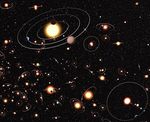 A statistical analysis based on a survey of millions of stars suggests that there's at least one planet for every star in the sky, and probably more. That would add up to 160 billion planets or so in the Milky Way.
A statistical analysis based on a survey of millions of stars suggests that there's at least one planet for every star in the sky, and probably more. That would add up to 160 billion planets or so in the Milky Way.
"We conclude that stars are orbited by planets as a rule, rather than the exception," an international research team reports today in the journal Nature.
The estimate may sound amazing: Just a year ago, the world was wowed by the claim that at least half of the 100 billion or more stars in the Milky Way possessed planets, yielding a figure of 50 billion planets. The latest survey now suggests that there's an average of 1.6 planets per star system, which would work out to 160 billion. But perhaps the most amazing thing about the findings is ... astronomers don't find them amazing at all. [...]
"We used to think that the Earth might be unique in our galaxy," Daniel Kubas, a colleague of Cassan's at the Institut d'Astrophysique de Paris and a co-author of the Nature paper, said in a news release from the European Southern Observatory. "But now it seems that there are literally billions of planets with masses similar to Earth orbiting stars in the Milky Way."
Comment: Yet, humans want to believe that we are the only form of life in the whole universe, when there must be other forms of life right here in our own galaxy... Humans are not that special...

ESO Astronomers are expecting Cosmic Fireworks from our Galactic Center in 2013!
Supermassive black hole will 'eat' gas cloud
BBC News, 14th December 2011
 Researchers have spotted a giant gas cloud spiralling into the supermassive black hole at our galaxy's centre. Though it is known that black holes draw in nearby material, it will be the first chance to see one consume such a cloud.
Researchers have spotted a giant gas cloud spiralling into the supermassive black hole at our galaxy's centre. Though it is known that black holes draw in nearby material, it will be the first chance to see one consume such a cloud.
As it is torn apart, the turbulent area around the black hole will become unusually bright, giving astronomers a chance to learn more about it. An article in Nature suggests the spectacle should be visible in 2013. [...]
Researchers using the European Southern Observatory's Very Large Telescope estimate that despite its size, the cloud has a total mass of only about three times that of Earth.
They have plotted the cloud's squashed, oval-shaped path and estimate it has doubled its speed in the last seven years - to 2,350km per second.
It should spiral in to within about 40 billion kilometres of the black hole in the middle of 2013.
Our local supermassive black hole, dubbed Sagittarius A*, lies about 27,000 light-years away, and has a mass about four million times that of our Sun.
Comment: I am just amazed & stunned... After everything that I have been trying to explain in my book and on my websites [this has alway been about astronomy and a major new astronomical cycle, the 25 year build up of energy to get to 2012 and the start of a major new era], my best friends turn out to be the international astronomical community....
[Please note: Sagittarius A* is considered to be the Galactic centre but it is actually a tiny region within the Galactic Centre, populated by millions of stars and a 4 million solar mass 'Black Hole' accompanied by a very powerful 2.6 million solar mass radio source that has been identified as IRS 7, a red supergiant star that puts out most of its energy in the near infrared. Astronomers deliberately confuse Sagittarius A* with the rather innoculous and "feeble" black hole, but they are NOT the same thing and that is why astronomers are forced to admit that the 'cloud' is hitting within the 40 billion kilometres of the black hole. Regardless, we are interested in the cosmic bullet being fired into this region and what might happen. For reference see
Radio image of the central region of the Milky Way.]
I ignored this headline initially because I am sick of all the overhype concerning black holes, but this is different.... A cloud of energy (plasma) arriving at our galactic centre in 2013? Wow, I have stated that the energetic changes to our solar system are being driven by energy from deep space and now it seems that astronomers have been watching a specific cloud of energy approaching for maybe a decade (at least)... We must remember that astronomers have been telling us about the arrival of an interstellar cloud for years and energy has been building up around our solar system and leaking through for years. I have done more research and I understand why scientists are excited about supermassive black holes but it seems a lot of old ideas are being quietly discarded, but that is another story... At this moment, I am not going to speculate about the impact of this energy on our galactic centre, but no doubt others will... Here is the ESO research paper that has been made public which is quite good of them, see below:
A gas cloud on its way toward the super-massive black hole in the Galactic Centre (.pdf).
European Southern Observatory, December 2011
"As part of our NACO9 and SINFONI10,11 VLT programmes studying the stellar
orbits around the Galactic Centre super-massive black hole, SgrA*, we have discovered
an object moving at ~1700km/s along a trajectory almost straight toward SgrA*."
OK, this is a cosmic bullet aimed straight at the Galactic Centre...
Gas Cloud En Route To Milky Way's Black Hole [VIDEO]
Red Orbit, 15th December 2011
"Scientists say that by 2013, outbursts of X-rays and radio waves will be emitted as the cloud gets hotter and is obliterated by the black hole. The cloud is mostly made up of hydrogen and helium gas.
[ Video 1 ] | [ Video 2 ] | [ Video 3 ] |
How amusing, astronomers are predicting that our Galactic Centre is going to light up with this cosmic energy in 2013, we are actually going to get some cosmic fireworks to celebrate the start of a new cosmic era... Absolutely incredible!
Update: The news from the European Southern Observatory explains the rush to put new telescopes on the ice in Antarctica and other new telescopes all pointing at the Galactic Centre. It is quite obvious that this 'cloud' has been watched for at least a decade but I will state, astronomers probably were not sure where it was headed until it became obvious this spark of cosmic consciousness was on it's way to ignite the Galactic Centre. I am very amused by the continuation of the pattern of releasing major astronomical news in the run up to Christmas as practiced by NASA. I was wondering if the same would happen this year and so, I have not been disappointed. Obviously, some think that everyone is distracted by Christmas shopping, as if shallow consumption dictates the priorities of all those interested in what is taking place on our planet, our solar system and our galaxy. To the cosmic fairy tale people hoping for something to happen on the 21st December 2012, it is unlikely there will be a celestial intercourse between Father Sun and the Cosmic Mother but you could hope for some galactic fireworks. The Galactic Centre could light up in the optical part of the elctromagnetic spectrum, but there is a lot of cosmic dust in the way, so seeing something on Earth is probably unlikely, but every single available telescope on the planet will be scanning that region waiting for the moment of any ignition and there will be a rush by astronomers to make the first announcement, I am quite confident about that. We don't know what is going to happen, but if there is some kind of ignition, it will be for decades and the consequences can only be speculated about. Whatever, if ignition happens in 2013, I will be satisfied that those interested in spiritual truth were warned to expect massive evolutionary change. I personally don't think you can get a scenario any more sensational than the Galactic Centre lighting up, even if it's only in X-rays, to celebrate the start of a New Cosmic Age.
Comet Lovejoy puts on a show
Spaceweather.com, 22nd December 2011
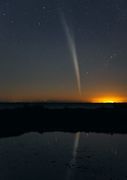 COMET LOVEJOY GETS EVEN BETTER: Sungrazing Comet Lovejoy is so bright that "it can now be seen with the unaided eye for more than an hour before sunrise," reports Colin Legg of Mandurah, Western Australia. This morning, a short exposure with Legg's digital camera was sufficient to reveal the comet's reflection in the waters of the Mandurah Estuary:
"It was an amazing sight," says Legg. Indeed, Lovejoy appears to be the finest comet since Comet McNaught in 2007.
Dawn sightings of Comet Lovejoy are now widespread around the Southern Hemisphere. (The tilt of the comet's orbit does not favor northern sightings.) Many observers are asking about the comet's "double tail." These are the dust and ion tails. The gaseous ion tail is blown almost directly away from the sun by the solar wind, while the heavier, brighter dust tail more closely follows the comet's orbit: diagram. The gap between the two tails can be seen with the naked eye while the sky is still pitch dark ~30 minutes before dawn.
COMET LOVEJOY GETS EVEN BETTER: Sungrazing Comet Lovejoy is so bright that "it can now be seen with the unaided eye for more than an hour before sunrise," reports Colin Legg of Mandurah, Western Australia. This morning, a short exposure with Legg's digital camera was sufficient to reveal the comet's reflection in the waters of the Mandurah Estuary:
"It was an amazing sight," says Legg. Indeed, Lovejoy appears to be the finest comet since Comet McNaught in 2007.
Dawn sightings of Comet Lovejoy are now widespread around the Southern Hemisphere. (The tilt of the comet's orbit does not favor northern sightings.) Many observers are asking about the comet's "double tail." These are the dust and ion tails. The gaseous ion tail is blown almost directly away from the sun by the solar wind, while the heavier, brighter dust tail more closely follows the comet's orbit: diagram. The gap between the two tails can be seen with the naked eye while the sky is still pitch dark ~30 minutes before dawn.
Comment: Comet Lovejoy has turned out to be a wonderful reminder that astronomers have still not acknowledged that comets obey their own electromagnetic rules. Comets are NOT rocky balls of ice and dust floating around in the 'vacuum' of space. The truth is that space is filled with dust and plasma and currently, our solar system is getting dustier and more charged and comet displays can now be quite impressive depending upon the size and the electromagnetic conditions.
Comet Lovejoy From Orbit
Spaceweather.com, 23rd December 2011
COMET LOVEJOY FROM ORBIT: Veteran astronaut Dan Burbank has seen many amazing things. Once, he even flew through the aurora borealis. So when Burbank says "[Comet Lovejoy] is the most amazing thing I have ever seen in space," it really means something. Currently serving onboard the International Space Station, Burbank photographed the sungrazing comet on Dec. 21st, an experience he describes in this NASA video:
Station Commander Captures Unprecedented View of Comet
NASA Media Gallery, 21st December 2011
The Joys of Comet Lovejoy
spaceweather.com, 18th December 2011
SPIRAL COMET TAIL: As Comet Lovejoy recedes intact from its Dec. 16th close encounter with the sun, researchers are pondering a mystery: What made the comet's tail wiggle so wildly in transit through the sun's atmosphere? The effect is clear in this sequence of extreme UV images recorded by NASA's STEREO-B spacecraft:
"Why the wiggles?" wonders Karl Battams of the Naval Research Lab. "We're not sure. There might be some kind of helical motion going on. Perhaps we're seeing material in the tail magnetically 'clinging' to coronal loops and moving with them. [Coronal loops are huge loops of magnetism that emerge from the sun's surface and thread the sun's atmosphere.] There are other possibilities too, and we will certainly investigate those!"
Battams notes that these images can be combined with similar images from STEREO-A on the other side of the sun to produce a three dimensional picture. "When we pair these together, and throw in the SDO images too, we should be able to get an incredibly unique 3-D picture of how this comet is reacting the the intense coronal heat and magnetic loops. We are going to learn a lot."
AMATEUR ASTRONOMERS TRACK LOVEJOY: Amateur astronomers are finding themselves able to photograph Comet Lovejoy as it emerges from the glare of the sun. A team led by Czech astronomer Jan Ebr captured this image at dawn on Dec. 17th:
"We used a remotely-controlled 12-inch telescope in Malargue, Argentina," says
Ebr. "The sun was below horizon at the time we took the picture, but just barely. There was only a 30 minute window between the rise of the comet and that of the sun "
Comment: Comet Lovejoy turned out to produce quite a nice conundrum for astronomers trying to pretend that comets are just rocky balls of ice. Even I am impressed with what happened to the comet tail as it scraped past the Sun intact. It's not "wiggles", the more accepted phrase is a "corkscrew effect" as the electrical charge in the tail is strengthened and then z-pinched by a very strong magnetic force, a trait of a classic Birkeland Current. Astronomers are getting quite educated these days in the ways of an Electromagnetic Universe, so the muttering immediately started about mysterious "magnetic forces", as most don't want to counternance the concept of electricity in space, but I am pleased to see more reports of cooperation between astronomers and plasma physicists.
Update
COMET LOVEJOY IN THE MORNING: Noted astronomer John Bortle urges observers (especially in the southern hemisphere) to "begin searching for Comet Lovejoy's bright tail projecting up out of the morning twilight beginning at dawn. The tails of some of the major sungrazing comets have been extraordinarily bright. Comet Lovejoy's apparition has been so bizarre up to this point that it is difficult to anticipate just what might happen next ... [including] the exact sort of tail it might unfurl in the morning sky."
This just in! The ghostly tail of Comet Lovejoy was sighted this morning shining through the twilight glow of dawn over Australia. Peter Sayers sends this picture from Devonport, Tasmania: "I was surprised to be able to see Comet Lovejoy in our Tasmanian summer early morning twilight with the waning Moon," says Sayers. "The comet's tail was just barely naked eye and perhaps a degree long."
Spaceweather.com 20th December 2011
Comet Lovejoy Plunges into the Sun and Survives
NASA Science News, 16th December 2011
Amazing comet Lovejoy
The Watchers, 19th December 2011
Scientists find answer to supernova riddle
News.com.au, 15th December 2011
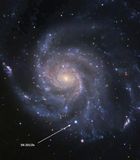 * Supernova created 20.9m light years from Earth
* Supernova created 20.9m light years from Earth
* Scientists got a "close-up look" at its birth
* "We found things nobody had dreamed of."
THE discovery of a supernova only hours after its explosion has probably solved a long-standing mystery on the origin of the brightest known phenomena in the Universe.
On August 24, scientists witnessed the spectacular eruption of light and energy thrown off by the birth of SN 2011fe, the brightest and - at a mere 20.9 million light years away - closest-to-Earth supernova in over 25 years.
"We caught the supernova just 11 hours after it exploded, so soon that we were later able to calculate the actual moment of the explosion within 20 minutes," said Peter Nugent of the US Lawrence Berkeley National Laboratory.
"With this close-up look, we found things nobody had dreamed of."
Comment: Astronomers will be thrilled about catching a supernova so soon after the explosion, but Electric Universe proponents are going to be even more delighted with the conclusion that astronomers could not find a stellar power source. The notion that this white dwarf canibalised a star the size of our sun but they can't find anything does not cut it for me, this part of the theory for the cause of supernova explosions has been falsified. More details at PhysOrg.com
Closest Type Ia supernova in decades solves a cosmic mystery
PhysOrg.com, 14th December 2011
Voyager 1 hits new region at solar system edge
PhysOrg.com, 5th December 2011
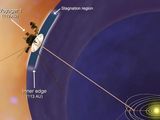 (PhysOrg.com) -- NASA's Voyager 1 spacecraft has entered a new region between our solar system and interstellar space. Data obtained from Voyager over the last year reveal this new region to be a kind of cosmic purgatory. In it, the wind of charged particles streaming out from our sun has calmed, our solar system's magnetic field has piled up, and higher-energy particles from inside our solar system appear to be leaking out into interstellar space.
(PhysOrg.com) -- NASA's Voyager 1 spacecraft has entered a new region between our solar system and interstellar space. Data obtained from Voyager over the last year reveal this new region to be a kind of cosmic purgatory. In it, the wind of charged particles streaming out from our sun has calmed, our solar system's magnetic field has piled up, and higher-energy particles from inside our solar system appear to be leaking out into interstellar space.
Comment: Cosmic purgatory.... well I suppose it's memorable. NASA are certainly getting their money's worth as the Voyager space craft, both launched in 1977 were only built to last five years and explore two planets. Instead, they surveyed all the giant outer planets of our solar system, 48 of their moons, and the unique systems of rings and magnetic fields those planets possess. Then as they were still working, they were sent off into the unknown to explore the solar system's boundary and interstellar space. To date, astrophysicists have been provided with some incredible new information. Space engineers can be really proud! What is interesting is that we get told all this amazing astronomical data about celestial objects being x light-years away, but we can't even work out where the boundary of our own solar system is... what's more we have recently decided that the Milky Way galaxy is really twice as big as we thought... Call me cynical, I don't care, but I think it's fair to say that astronomy is most often over educated guesswork... Hence, the benefit of real observational data that forces scientists to sometimes reconsider some of their completely wrong ideas...
The Brightest Lights in the Universe --Black-Hole Powered Quasars (Today's Most Popular)
Daily Galaxy, 2nd November 2011
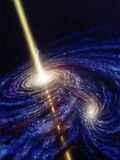 Movement of black holes power the persistent lights in the universe. Black holes not only spin, they can also move laterally across their host galaxy. And according to astrophysicists at Brigham Young University, both types of movement power massive jets of energy known as quasars. One black hole in the galaxy Centauras A propels radiation in a jet measuring 1 million light-years long.
Movement of black holes power the persistent lights in the universe. Black holes not only spin, they can also move laterally across their host galaxy. And according to astrophysicists at Brigham Young University, both types of movement power massive jets of energy known as quasars. One black hole in the galaxy Centauras A propels radiation in a jet measuring 1 million light-years long.
These spectacular jets stream out of galaxies that contain discs of debris and gas, the remnants of stars ripped apart by the force from black holes.
"The black hole is like a generator spinning around in these magnetic fields," said BYU professor David Neilsen, lead author of the study. "The way the field lines get twisted around and pulled by the spinning black hole creates electromagnetic tension that gets turned into radiation and energy that goes out."
The spin of black holes has been believed to play a role since the idea was put forward in 1977. The new study confirms this theory while also introducing a totally new component: that a black hole's lateral movement also powers these jets.
Comment: The top astronomers in the world do not believe in Black Holes because theory does not match up with observations and so we find that some astronomers prefer to believe that the objects that can be seen in space emitting powerful jets of energy are actually dense magnetic balls of plasma, called Eternally Collapsing Objects (ECOs) or Magnetically Eternally Collapsing Objects (MECOs). Some mathematicians have been complaining bitterly for years that Black Hole theory allowed for some big assumptions that have NEVER been proven, but it seems just like Big Bang theory, 'average' scientists are allowed to throw away their initial assumptioms and adopt new ones which is basically NOT science. So today, Black Holes have now become any object in the universe emitting powerful jets of energy which seems to be in direct contradiction to the old belief that Black Holes are so gravitationally powerful that anything within a certain range gets swallowed up that's why they were called Black Holes.... Also, original Black Holes were not allowed to be magnetic, but all of a sudden theory has changed and they can be magnetic. Well, elite astronomers have realised that dense concentrations of plasma produce jets as a result of plasma instability and magnetism is expected for a 'hot' ball of plasma, so when initial erroneous ideas are discarded, observations make a lot more sense. [The BBC article Supermassive Black Holes from 2000, is a good example of a major shift in black hole theory explaining the light from black holes and the relationship between black holes and galaxy formation. Another intriguing theory based on the properties of superfluids is the Gravastar. This is nicely explained in 2006 New Scientist article, Is Space-Time Actually A Superfluid? which seems to echo MECO theory in that objects called black Holes never reach a true singularity. We have some real experimental observations for a reality check, so it's not all mathematical conjecture.] What is really interesting is this seems to be some proof of how the scientific community is layered with "elite" scientists that have very different views from the rest of the scientific herd and they simply don't have to worry about perpetuating popular myths (rather like a religious hierarchy), they are actually doing 'real', science but there does not seem to be that many of them and sometimes their work is shrouded in secrecy.
The Myth of the Black Hole
The Myth of the Black Hole by Miles Mathis is an amusing read but even he admits that:
"I leave open the possibility that black holes do exist in some form, and that a part of the astronomical data has been read correctly. But the greater part of current speculation could be called wild, and a significant part is demonstrably illogical."
Mathis talks about "story-telling with a physical flavor"... yes, we are back to the fairy tales for adults again...
Unraveling the 'Fabric of the Cosmos': Q&A with Brian Greene
Space.com, 1st November 2011
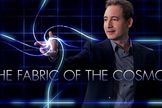 The series, which is based on Greene's book of the same title, premieres Wednesday (Nov. 2) on PBS at 9 p.m. ET/PT, and the three subsequent episodes will air on consecutive Wednesday nights through Nov. 23. [Gallery: The History & Structure of the Universe (Infographics)]
The series, which is based on Greene's book of the same title, premieres Wednesday (Nov. 2) on PBS at 9 p.m. ET/PT, and the three subsequent episodes will air on consecutive Wednesday nights through Nov. 23. [Gallery: The History & Structure of the Universe (Infographics)]
SPACE.com caught up with Greene to discuss his new TV series, whether we're close to figuring out what dark matter is, and whether there are copies of us somewhere out there in another universe:
SPACE.com: This TV series is based on your book, "The Fabric of the Cosmos," which tackles some of the most compelling questions and ideas in modern physics. Taking all that material and condensing it into four one-hour episodes must have been challenging.
Comment: I don't call what Brian Greene provides as education, I call this perpetuating mystery. Using geometry to explain spacetime is just a diversionary tactic almost as bad as using the concepts of dimensions because none of it makes any sense until we start talking about energy which is what the fabric of the universe is really made from. These types of authors seem to make a great living from explaining the failures of modern physics, but I get really creeped out by the discussion of mathematics being used to provide hints on reality... See the long Rupert Sheldrake quote below... well, the planet is being invaded by another lifeform and all this person can suggest is more speculation over the religious doctrine called Big Bang theory.... it's so pathetic...
NASA's Swift Finds a Gamma-Ray Burst With a Dual Personality
NASA Science News, 30th November 2011
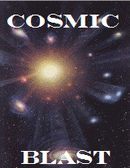 WASHINGTON -- A peculiar cosmic explosion first detected by NASA's Swift observatory on Christmas Day 2010 was caused either by a novel type of supernova located billions of light-years away or an unusual collision much closer to home, within our own galaxy. Papers describing both interpretations appear in the Dec. 1 issue of the journal Nature. [...]
WASHINGTON -- A peculiar cosmic explosion first detected by NASA's Swift observatory on Christmas Day 2010 was caused either by a novel type of supernova located billions of light-years away or an unusual collision much closer to home, within our own galaxy. Papers describing both interpretations appear in the Dec. 1 issue of the journal Nature. [...]
The Christmas burst, also known as GRB 101225A, was discovered in the constellation Andromeda by Swift's Burst Alert Telescope at 1:38 p.m. EST on Dec. 25, 2010. The gamma-ray emission lasted at least 28 minutes, which is unusually long. Follow-up observations of the burst's afterglow by the Hubble Space Telescope and ground-based observatories were unable to determine the object's distance.
Comment: Another strange cosmic event described here with "exotic scenarios"... What I can't understand is astronomers with such wildly different interpretations, one group thinks this burst was a relatively close 10,000 light years away and another thinks it's 5.5 billion light-years away... The explanations are incredible... or is that just not credible?
Christmas burst reveals neutron star collision
Los Alamos National Laboratory News, 1st December 2011
Here we are told: "the neutron star transformed into a black hole and the jet of gamma rays blasted outward, it struck the shell of the old star's gas envelope..." Well, all I can say is that I think this is some serious guesswork...
Collision course: the space rocks that threaten our lives
A 20 million ton asteroid is currently hurtling through space at 23,000 miles per hour, on a collision course with Earth. But fear not – Nasa has 25 years to stop it
The Telegraph, 30th October 2011
 When Paul Chodas and Steve Chesley arrived at Nasa's Jet Propulsion Laboratory, in a valley beneath the slopes of California's San Gabriel Mountains, on October 6 2008, they assumed it would be a normal day. But it would prove to be anything but.
The scientists worked for the space administration's Near Earth Object (NEO) programme, a team tasked with identifying comets, asteroids and meteors that potentially pose a threat to Earth. A normal day meant scanning their screens for small white dots in our solar system – the vast majority of which were either too far away to ever be a problem or so small they would burn up in our atmosphere long before they could ever do any serious damage. On that Monday morning, however, Chodas noticed an asteroid about the size of a truck beyond the moon's orbit. It was on a collision course with Earth.
When Paul Chodas and Steve Chesley arrived at Nasa's Jet Propulsion Laboratory, in a valley beneath the slopes of California's San Gabriel Mountains, on October 6 2008, they assumed it would be a normal day. But it would prove to be anything but.
The scientists worked for the space administration's Near Earth Object (NEO) programme, a team tasked with identifying comets, asteroids and meteors that potentially pose a threat to Earth. A normal day meant scanning their screens for small white dots in our solar system – the vast majority of which were either too far away to ever be a problem or so small they would burn up in our atmosphere long before they could ever do any serious damage. On that Monday morning, however, Chodas noticed an asteroid about the size of a truck beyond the moon's orbit. It was on a collision course with Earth.
Comment: Since we are now in an interstellar debris cloud and rocks are flying pass on a regular basis, some of them will hit Earth. Hence, it is interesting to know what capabilities astronomers have to know what exactly is coming at us and this article provides some interesting details. This article is quite a revelation by informing us that astronomers don't necessarily understand the space environment hence the incredible revelation of "keyholes" that I have never come across before... It seems to imply that the only way they can tell where an asteroid is going is to keep tracking them, but that if they hit a keyhole all bets are off and that is just plain strange...
Toward a Real Cosmology in the 21st Century
Thunderbolts.Info, 27th October 2011
 Editors Note: The Bentham Open Astronomy Journal has now published a “Special Edition” with a focus on Plasma Cosmology. A peer-reviewed journal, its goal is to publish quality papers rapidly and to make them freely available to researchers worldwide. The following article by Wallace Thornhill, chief science advisor of the Thunderbolts Project, offers a comprehensive overview of the Electric Universe paradigm and its challenge to conventional astronomy and cosmology.
Editors Note: The Bentham Open Astronomy Journal has now published a “Special Edition” with a focus on Plasma Cosmology. A peer-reviewed journal, its goal is to publish quality papers rapidly and to make them freely available to researchers worldwide. The following article by Wallace Thornhill, chief science advisor of the Thunderbolts Project, offers a comprehensive overview of the Electric Universe paradigm and its challenge to conventional astronomy and cosmology.
Abstract: A real cosmology must be a broad and coherent natural philosophy. It may always be incomplete, based on our limitations, but to be valid there can be no exceptions in our experience. In particular, cosmology must address issues of life and the human condition. Therefore it must be a truly interdisciplinary pursuit. Modern specialized science is a hostile environment for such a quest. For example, the world's largest professional body, the Institute for Electrical and Electronic Engineers (IEEE), recognizes plasma cosmology while it remains unheard of by students of astronomy.
Plasma cosmology receives no publicity although it deals empirically with the electromagnetic behavior of plasma, which constitutes almost the entire visible universe. Unlike theoretical big bang cosmology, plasma cosmology can claim successful predictions without recourse to hypothetical matter, energies and forces. However, despite its many successes, plasma cosmology cannot claim to be the final answer because it does not deal with unsolved problems in basic and stellar physics.
Comment: Thornhill say he is a philosopher and so am I, so I totally understand his approach to wanting to truly understand how the Universe really works and refusing to accept outdated ideas that ignore the new observational evidence that paints a new and much more glorious picture of our reality. I am very grateful to Thornhill and the rest of the Electric/Plasma Universe proponents because there is absolutely no way that I could integrate science and metaphysics without some basic priniciples of cosmology being right. What's more, space weather has forced space scientists to focus on plasma physics and completely abandon any interest in talk of gravity, because gravity is not "zapping" billion dollar satellites. Here is a Rupert Sheldrake quote that can be found in Thornhill's paper that I find useful, and Thornhills' immediate response that I believe is extremely characteristic of a philosopher.
“It is interesting that the roots of the 17th-century
mechanistic world view can be found in ancient mystical
religion. Indeed, the mechanistic view was a synthesis of two
traditions of thought, both of which were based on the mystical
insight that reality is timeless and changeless. One of
these traditions stems from Pythagoras and Plato, who were
both fascinated by the eternal truths of mathematics. In the
17th century, this evolved into a view that nature was governed
by timeless ideas, proportions, principles, or laws that
existed within the mind of God. This world view became
dominant and, through philosophers and scientists such as
Copernicus, Kepler, Descartes, Galileo and Newton, it was
incorporated into the foundations of modern physics.
Basically, they expressed the idea that numbers, proportions,
equations, and mathematical principles are more real
than the physical world we experience. Even today, many
mathematicians incline toward this kind of Pythagorean or
Platonic mysticism. They think of the physical world as a
reification of mathematical principles, as a reflection of
eternal numerical mathematical laws. This view is alien to
the thinking of most of us, who view the physical world as
the “real” world and consider mathematical equations a
man-made, and possibly inaccurate, description of that
“real” world. Nevertheless, this mystical view has evolved
into the currently predominant scientific viewpoint that nature
is governed by eternal, changeless, immutable, omnipresent
laws. The laws of nature are everywhere and always”
[5].
The dominant belief in immutable, universal mathematical
laws keeps us in the dark, as witness the reification of
hypothetical mathematical constructs like 'dark matter,'
'dark energy' and 'black holes.' In the words attributed to
Artemus Ward: “The researches of many eminent scientific
men have thrown so much darkness upon the subject, that if
they continue their researches we shall soon know nothing.”
Toward a Real Cosmology in the 21st Century, Wallace W. Thornhill, The Bentham Open Astronomy Journal, 2011, 4, (Suppl 2-M5) 191-210
link
Due to the onset of space weather, Earth is now in transition to a high energy plasma environment and our modern technological world is now vulnerable. Therefore a more realistic understanding of cosmology is now imperative and the foundations have already been laid by pioneers like the great Norwegian scientist Kristian Olaf Bernhard Birkeland, (1867-1917 and, the great Nobel prize winning physicist and astrophysicist Hannes Alfvén (1908 - 1995). Many others have contributed to our understanding of plasma cosmology in the last 100 years and so people like Thornhill have basically choosen to carry the light of truth to help us out of some real intellectual darkness.
A Comet Corpse and Celestial Refuse
Spaceweather.com, 24th October 2011
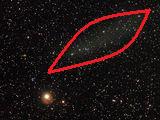 COMET CORPSE: "Doomsday Comet" Elenin was briefly famous for inaccurate predictions that it might hit Earth. Instead it disintegrated as it approached the sun last month. (Doomsday canceled.) Over the weekend, Italian astronomer Rolando Ligustri spotted the comet's remains. It's the elongated cloud in this Oct. 22nd photo of the star field where Elenin would have appeared if it were still intact:
COMET CORPSE: "Doomsday Comet" Elenin was briefly famous for inaccurate predictions that it might hit Earth. Instead it disintegrated as it approached the sun last month. (Doomsday canceled.) Over the weekend, Italian astronomer Rolando Ligustri spotted the comet's remains. It's the elongated cloud in this Oct. 22nd photo of the star field where Elenin would have appeared if it were still intact:
Another team of astronomers--Ernesto Guido, Giovanni Sostero and Nick Howes--spotted the cloud on the same night. At first they were skeptical. "The cloud was extremely faint and diffuse," says Guido. "We wondered if it might be scattered moonlight or some other transient artifact." But when the team looked again on Oct. 23, the cloud was still there. A two-night blink animation shows that the cloud is moving just as the original comet would have.
More information about this discovery and continued tracking of the "comet corpse" may be found at the Remanzacco Observatory Astronomy Blog.
Comment: What is really interesting is what keeps these 'cloud' comets together so that they just keep swirling around in space? The Taurid Stream is described as "...a procession of vast cosmic rubble and dust that snakes around the Sun. ... Within the stream are probably thousands of bodies including asteroids, mountain-and island-sized boulders, smaller meteoroids, Encke's Comet and assorted fragments of celestial refuse." So.... are there biological entities living on the mountain sized and island sized rocks? Do plasma entities live within these cosmic streams, that astronomers refer to as "celestial refuse"? Massive amoeba-type entities are regularly seen around Earth, but they are called "debris" too... When you start thinking about this, who is to say that these are not worlds that we know nothing about?
Earth's movement around the Sun!
YouTube, 4th March 2011
 Comment: I have changed the YouTube, headline here because it is flat wrong... As you can see from what Nassim Haramein actually explains, the planets are moving around the sun but that is not the only motion to consider as the sun is moving through space too in it's journey around the galactic centre. Of course, this is not new! The idea that this is a new theory is also absolutely ridiculous, but I decided to highlight the video because I have never seen this vortextual motion of the planets in a video depicting movement through space and this is a great teaching aid, when trying to explain how Earth can be affected by moving through new regions of space. Nassim Haramein is very popular and I have not come across anything truly wrong in what he has to say, but I simply have not had much time to study his teachings. Quite frankly, from what I have come across of his teachings, the man uses logic and with all the nonsense that is being taught by the ignoranti, the few people who are teaching the physics of the universe from a more holistic viewpoint whilst being rational and logical get my vote. The Dual torus U4 bubble spacetime manifold animation that I have seen elsewhere is also wonderful....
Comment: I have changed the YouTube, headline here because it is flat wrong... As you can see from what Nassim Haramein actually explains, the planets are moving around the sun but that is not the only motion to consider as the sun is moving through space too in it's journey around the galactic centre. Of course, this is not new! The idea that this is a new theory is also absolutely ridiculous, but I decided to highlight the video because I have never seen this vortextual motion of the planets in a video depicting movement through space and this is a great teaching aid, when trying to explain how Earth can be affected by moving through new regions of space. Nassim Haramein is very popular and I have not come across anything truly wrong in what he has to say, but I simply have not had much time to study his teachings. Quite frankly, from what I have come across of his teachings, the man uses logic and with all the nonsense that is being taught by the ignoranti, the few people who are teaching the physics of the universe from a more holistic viewpoint whilst being rational and logical get my vote. The Dual torus U4 bubble spacetime manifold animation that I have seen elsewhere is also wonderful....
Dark Matter Mystery Deepens
Harvard-Smithsonian Center for Astrophysics, 17th October 2011
 Cambridge, MA - Like all galaxies, our Milky Way is home to a strange substance called dark matter. Dark matter is invisible, betraying its presence only through its gravitational pull. Without dark matter holding them together, our galaxy's speedy stars would fly off in all directions. The nature of dark matter is a mystery -- a mystery that a new study has only deepened.
Cambridge, MA - Like all galaxies, our Milky Way is home to a strange substance called dark matter. Dark matter is invisible, betraying its presence only through its gravitational pull. Without dark matter holding them together, our galaxy's speedy stars would fly off in all directions. The nature of dark matter is a mystery -- a mystery that a new study has only deepened.
"After completing this study, we know less about dark matter than we did before," said lead author Matt Walker, a Hubble Fellow at the Harvard-Smithsonian Center for Astrophysics.
The standard cosmological model describes a universe dominated by dark energy and dark matter. Most astronomers assume that dark matter consists of "cold" (i.e. slow-moving) exotic particles that clump together gravitationally. Over time these dark matter clumps grow and attract normal matter, forming the galaxies we see today.
Cosmologists use powerful computers to simulate this process. Their simulations show that dark matter should be densely packed in the centers of galaxies. Instead, new measurements of two dwarf galaxies show that they contain a smooth distribution of dark matter. This suggests that the standard cosmological model may be wrong.
Comment: Presumably this is another major failure as observations do not match theory and can be linked to this Science Daily article, March 2010, Supermassive Black Holes: Hinting at the Nature of Dark Matter? where a few scientists have realised that the black hole/dark matter theories are just not consistent and the articles states: "Hernandez and Lee conclude that it is probably necessary to change some of the assumptions that underpin these models -- dark matter may not behave in the way scientists thought it did."
Actually, I received a link about this news from Dr Abhas Mitra, who first proposed the existence of MECOs in 1998. He is famed for being the only scientist to successfully challenge Dr Stephen Hawking on black holes, (see link below) hence, this is someone who refused to accept the current thinking and the evidence is now piling up in his favour, so he gets my full admiration... Hence, everytime I get an email, I am thrilled (and I don't get many thrills), by being in contact with someone of such sheer class. I think one day he might even get a Nobel Prize.... Anyway, the reason why I was thrilled to discover MECO theory is because it's a logical hypothesis in a universe that is 99.999% plasma. So, despite the constant tweaking of basic theory, on real observations, the most accepted cosmological theories just keep failing. The following is a repeat of what I have written before.
It is worth taking the opportunity to point out that some critics have been vociferous in their stance against these hypothetical black holes. One such person is the notorious mathematician Stephen J. Crothers and his website provides details of his personal crusade The Black Hole, the Big Bang, and Modern Physics. It must also be noted that some astronomers from highly respected institutions have left the herd a long time ago and quietly state that Black Holes in space are impossible and have come up with a completely different plasma universe interpretation. So we read:
And the researchers say this raises doubts as to whether other so-called black holes are really that, either. [...]
Instead, the researchers are picturing a body with a definite size, and a surprising property: it gradually crams itself into a smaller space forever, but never achieves a black hole's infinitely small size. [...] Schild's group studied a quasar designated Q0957+561, about 9 billion light-years away in the direction of the constellation Ursa Major. A light-year is the distance light travels in a year.
The quasar holds a central compact object weighing the equivalent of 3 to 4 billion Suns. Most scientists would call it a black hole, but Schild said his findings suggest otherwise: surprisingly, it's magnetic, unlike a black hole. [...] The problem vanishes, Schild and colleagues argue, with the new type of compact object that they propose, called a Magnetospheric Eternally Collapsing Object, or MECO.
This body, a variant of an object whose existence was first proposed by the Indian physicist Abhas Mitra in the late 1990s, is one that not unlike a black hole, continually shrinks into an ever-smaller space. But it never becomes a black hole. Instead, its shrinkage slows down until it becomes imperceptible, but goes on steadily–so slowly, it could go on for many times the lifetime of the universe. Unlike a black hole, a MECO also has definite size. Moreover, objects sucked in can theoretically go back out, albeit with extreme difficulty.
A MECO, essentially a dense ball of plasma, continually generates magnetic fields through surface currents, explaining the magnetism, Schild said. His team's research appeared in the July issue of The Astronomical Journal.
It won't be easy for the MECO theory to gain wide acceptance among scientists, astronomers say, given that black holes have been the accepted scenario since Einstein. But Mitra and a few other theorists claim black holes don't exist at all–only Eternally Collapsing Objects.
No black holes after all?
Harvard-Smithsonian Center for Astrophysics & World Science, August 11th 2006
This is a similar article at New Scientist, July 2006, Mysterious quasar casts doubt on black holes . This is a presentation by Jeff Hodgson, 2008, MECO theory. This is a current Journal of Cosmology, Vol 6, 2010 paper by R.E. Schild and D.J. Leiter
BLACK HOLE OR MECO? DECIDED BY A THIN LUMINOUS RING STRUCTURE DEEP WITHIN QUASAR Q0957+5r1
Meet the Indian who took on Stephen Hawking
Rediff.com, August 03, 2004
"An Indian theoretical physicist who questioned the existence of black holes and thereby challenged Stephen Hawking of Britain at last feels vindicated. But he is sad. Abhas Mitra, at the Bhabha Atomic Research Centre (BARC) in Mumbai, was perhaps the first and the only scientist who had the guts to openly challenge Hawking of Cambridge University who is regarded by many as the modern-day Einstein. [...] In a subsequent work Mitra showed that the "Eternally Collapsing Objects" that he proposed are actually the massive compact objects now referred to as Black Hole Candidates (BHCs). Motivated by Mitra's work, American physicists Stanley Robertson and Darryl Leiter have confirmed in 2002 that BHCs have intense magnetic fields as predicted by Mitra and therefore are not real black holes which cannot have magnetic field."
Article:
Debris of 'Doomsday' Comet Elenin to Pass by Earth Sunday
Space.com, 14th October 2011
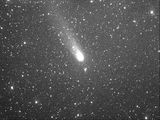 The moment long feared by conspiracy theorists is nearly upon us: The "doomsday comet" Elenin will make its closest approach to Earth Sunday (Oct. 16). Or what's left of it will, anyway.
The moment long feared by conspiracy theorists is nearly upon us: The "doomsday comet" Elenin will make its closest approach to Earth Sunday (Oct. 16). Or what's left of it will, anyway.
Comet Elenin started breaking up in August after being blasted by a huge solar storm, and a close pass by the sun on Sept. 10 apparently finished it off, astronomers say. So what will cruise within 22 million miles (35.4 million kilometers) of our planet Sunday is likely to be a stream of debris rather than a completely intact comet.
And the leftovers of Elenin won't return for 12,000 years, astronomers say.
Comment: It's been amazing how desperate some people have been for doom and disasters to fulfill their misguided predictions... Meanwhile, for those interested in what is really happening on our planet, the serious implications of Space Weather for our modern technological world is starting to become really obvious for those who can understand basics like cause and effect.
Crab Pulsar gamma rays baffle scientists
TG Daily, 7th October 2011
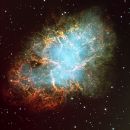 October 6, 2011 – Scientists say the Crab Pulsar is blasting out gamma rays at a higher rate than can be explained by current scientific models. It's emitting the highest-energy gamma rays ever observed from a pulsar – a highly magnetized and rapidly spinning neutron star – at more than 100 billion electron volts. That's more than 50 billion times more energy than the visible light from the Sun.
October 6, 2011 – Scientists say the Crab Pulsar is blasting out gamma rays at a higher rate than can be explained by current scientific models. It's emitting the highest-energy gamma rays ever observed from a pulsar – a highly magnetized and rapidly spinning neutron star – at more than 100 billion electron volts. That's more than 50 billion times more energy than the visible light from the Sun.
“This is the highest energy pulsar system ever detected,” said Rene Ong, a UCLA professor of physics and astronomy and spokesperson for the VERITAS collaboration at the Harvard–Smithsonian Center for Astrophysics. “It is a completely new and surprising phenomenon for pulsars.”
All previous observations of pulsars have indicated that the radiation cuts off at the high energies the team observed. “It means the radiation we detect must be a new component that was completely unexpected,” says Ong.
Comment: The evidence mounts. I believe that scientists are only detecting MORE of the energy associated with these pulsars due to the evolution of spacetime around Earth caused by the arrival of new types of energy. Think of this as the difference it would make in seeing the local scenery on a thick smoggy day to it all clearing and bright sunshine appearing, whether it's raining or snowing or hailing it's all much easier to see, and feel and benefit from...This is the reason why ancient astronomers watched the skies so carefully and recognised the significance of precession for celestial timekeeping... This is alongside the other strange so-called 'black hole' collision 'outburst' in the Draco constellation, that is also firing directly at Earth. So, it looks like scientists are worried that this usual 30 second outburst is just going on and on and there is concern about the impact on Earth's environment. Well, this is exactly what the metaphysical community were warned about, but few understood the evolutionary implications....
Astrophysics and Extinctions: News About Planet-Threatening Events
Science Daily, 7th October 2011
Comet Elenin–the Debate that Never Happened
Thunderbolts.info, 6th October 2011
 The comet Elenin, a subject of intense Internet discussion for several months, seems to have disappointed everyone. I speak here not just of the doomsayers, who were awaiting a frightful specter in recent weeks. You might think these folks would be happy that the celebrated intruder faded fast just when it was supposed to be reaching maximum activity. But in these strange times, Doomsday seems a lot more fun than a minor distraction in our cosmic neighborhood.
The comet Elenin, a subject of intense Internet discussion for several months, seems to have disappointed everyone. I speak here not just of the doomsayers, who were awaiting a frightful specter in recent weeks. You might think these folks would be happy that the celebrated intruder faded fast just when it was supposed to be reaching maximum activity. But in these strange times, Doomsday seems a lot more fun than a minor distraction in our cosmic neighborhood.
Also disappointed are the many scientists who expected a more impressive display from Elenin. That expectation seemed well founded based on the growing coma of Elenin in the months following its discovery in December, 2010. And prior space probes sent to comets helped to feed an illusion about the comet's size. The estimates appear to have missed the mark completely.
Seeing the obvious: A “3 or 4 km-wide” chunk of ice and dirt could not just disappear at Elenin's distances from the Sun, even with disintegration. Elenin is not a “sun grazer.” Its perihelion (closest approach to the Sun) was outside the orbit of Mercury. But what if Elenin was, in truth, a tiny comet, but a strongly charged body for its size? As noted above, since Elenin arrived from a very remote region, electrically-provoked brightening would be expected as it entered a more positively charged region of the heliosphere. For the same reasons, under the impact of a CME, disintegration by electrical breakdown is the obvious interpretation of what occurred.
Comment: I will say I saw an online presentation about Comet Elenin and I was surprised that there was so little hard scientific evidence to generate all the speculation and hype. Interestingly, my intuition never kicked in once over this comet, which makes me wonder about why so people many got suckered into the hype... This is a nice not overly zealous piece from David Talbott providing us with the Electric Universe perspective. Recently, I had started to give up with this group because it seems that some of the followers were starting to get extremely cultish in their behaviour and we can do without all that... Btw, the Search does not seem to be working and will crash your browser.
Satellite detects new black hole in our galaxy
Earth Sky News, 6th October 2012
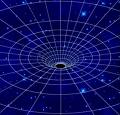 On September 16, 2012, NASA's Swift satellite caught an x-ray outburst, believed to have come a flood of gas plunging toward a previously unknown black hole. This new black hole in our Milky Way galaxy has been designated as Swift J1745-26 by astronomers.
On September 16, 2012, NASA's Swift satellite caught an x-ray outburst, believed to have come a flood of gas plunging toward a previously unknown black hole. This new black hole in our Milky Way galaxy has been designated as Swift J1745-26 by astronomers.
Black holes such as this one are thought to be common in our galaxy, but we don't see very many of them. This is the first one discovered by the Swift satellite. The video above – from NASA's Goddard Space Flight Center – shows how Swift made the discovery. This black hole has a sun-like companion star. Gas flowing from the companion collects into a disk around the black hole. Normally, this gas would steadily spiral inward. But in this system, the gas collects for decades before suddenly surging inward, causing the x-ray outburst detected by Swift.
Comment: The concept of black holes badly needs to evolve... officially.... A combination of MECO theory with standard plasma cosmology needs to be considered more seriously because at the moment, black hole theory has been allowed to creep and looks very unlike the original concepts.
'Ocean-like' ice in space scan shows that Earth's life-giving oceans might have ridden in on a comet's tail
Daily Mail, 5th October 2011
 Today, most of Earth's surface is covered in water - but scientists believe Earth's oceans didn't form until around eight million years after the planet itself.
Today, most of Earth's surface is covered in water - but scientists believe Earth's oceans didn't form until around eight million years after the planet itself.
The discovery of 'ocean-like' water on a comet by the HiFi instrument on the Herschel Space Observatory hints that Earth's oceans might have arrived in the form of comet ice.
If so, the impacts (we'd have needed quite a few) would have formed an important stage in the evolution of life on Earth.
'Life would not exist on Earth without liquid water, and so the questions of how and when the oceans got here is a fundamental one,' said University of Massachussetts astronomy professor Ted Bergin, 'It's a big puzzle and these new findings are an important piece.'
Previous scans of comets led astronomers to believe that the icy bodies could not have brought water to Earth - or at least were only responsible for a very small fraction of it.
Comment: Is this another scientific paradigm shift? You need to read the book called The Big Splash by Dr Louis Frank to see how scientists fought against the concept of water coming from space... Here is a quote from one of my essays:
The New York Yimes Book Review described 'The Big Splash' as, "A savage tale of how science works" and you have to read the book to believe it. In 1981, Dr Louis Franks made this discovery in ultra-violet imaging from NASA's Dynamics Explorer satellite as part of his scientific research on the aurora. His images were being constantly marred by black spots that he first put down to technical factors, but after years of trying he could not irradicate them. In his images, these spots were actually 30 miles across and so he reasoned that the dark spots revealed the presence of water from an extraterrestrial origin.
Dr Louis Franks gives us great personal insight into how his ideas met harsh opposition and how he acquired heretic status after previously being considered a well respected scientist. Infact, Dr. Frank comes with impeccable credentials. He was a full professor at 32 and at the time of writing the book was reputed to have "more instruments on more spacecraft than anyone else on the planet." Yet, as Frank found and he reported in the New Scientist, “if you propose that something from out there is affecting us here and now, rather than millions of years in the past or millions of years in the future, beware the wrath of orthodox science. Science guards our isolation well.” Therefore, even good colleagues, refused to reconsider their existing beliefs and the antics that he endured are quite an eye-opener.
Truth, Lies, Fiction & Peer Review , 4th March 2009
This is the problem with the herd mentality. A paradigm shift only occurs when the evidence is so overwhelming that it becomes embarrassing to ignore the facts any longer. The other way for paradigm shift to occur in science is when scientists in control die off and once they have gone, everybody else sighs with relief and then change happens. Max Planck is quoted as saying that “science advances one funeral at a time”. Read about the history of science, this is how it is...
CRESST uncovers hint of dark matter
Physics World, 8th September 2011
 Dark matter is thought to make up more than 80% of the universe's matter. However, it is invisible and has so far only been inferred by the gravitational pull that it exerts on normal matter. Physicists think that it probably takes the form of weakly interacting massive particles, or WIMPs.
Dark matter is thought to make up more than 80% of the universe's matter. However, it is invisible and has so far only been inferred by the gravitational pull that it exerts on normal matter. Physicists think that it probably takes the form of weakly interacting massive particles, or WIMPs.
To spot these WIMPs directly, researchers have built detectors in underground labs where the low background noise ought to allow any signals to stand out. The biggest underground lab is at Gran Sasso, a mountain in central Italy, home to various dark-matter experiments such as DAMA, XENON and CRESST. For just over a decade, the team behind the DAMA experiment has claimed to see a WIMP signal – an annual modulation that would fit in with the Earth orbiting with and against the prevailing “wind” of dark matter in our galaxy. Last year, the CoGeNT collaboration, based in the Soudan mine in Minnesota, US, reported hundreds of blips in their detectors that could also be WIMPs.
Comment: This is interesting, so now scientists are talking 'the about prevailing “wind” of dark matter in our galaxy'. Well, that confirms the other research I have read where physicists believe that this 'wind' of dark matter increases every 10,000 years or so and changes Earth's orbit ever so slightly...
The Diamond Fields of the Mind
Thunderbolts.info, 7th September 2011
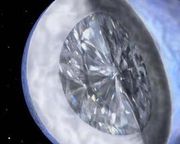 A recent press release announced the "discovery" of a planet in orbit around a pulsar that is thought to have once been a star, but is now a planetary body composed of something similar to compressed carbon, or diamond.
A recent press release announced the "discovery" of a planet in orbit around a pulsar that is thought to have once been a star, but is now a planetary body composed of something similar to compressed carbon, or diamond.
The reason for the supposed density and composition assumptions is that the "planet" was seen in an orbit around the pulsar that is deemed impossible to consensus astrophysicists. As announced by the Max Planck Institute for Radio Astronomy in Bonn, Germany, pulsar J1719-1438 rotates more than 10,000 times per minute, has a mass of about 1.4 times that of our Sun, but is only 20 kilometers in radius. What is it about the planet's orbit that causes the assumption it is crystalline and extremely dense?
Comment: OK, I just like the title.... but we have some technical details that explain that the high levels of speculation involved in the sensation headlines of diamond planets.
Gravity Probe B and Related Matters
Holoscience.com, 5th September 2011
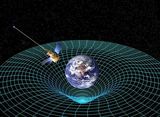 As is explained on the official NASA web page, 'this experiment, launched in 2004, used four ultra-precise gyroscopes to measure the hypothesized geodetic effect, the warping of space and time around a gravitational body, and frame-dragging, the amount a spinning object pulls space and time with it as it rotates. Gravity Probe B determined both effects with unprecedented precision by pointing at a single star, IM Pegasi, while in a polar orbit around Earth. If gravity did not affect space and time, Gravity Probe B's gyroscopes would point in the same direction forever while in orbit. But in confirmation of Einstein's theories, the gyroscopes experienced measurable, minute changes in the direction of their spin, while Earth's gravity pulled at them'.[...]
As is explained on the official NASA web page, 'this experiment, launched in 2004, used four ultra-precise gyroscopes to measure the hypothesized geodetic effect, the warping of space and time around a gravitational body, and frame-dragging, the amount a spinning object pulls space and time with it as it rotates. Gravity Probe B determined both effects with unprecedented precision by pointing at a single star, IM Pegasi, while in a polar orbit around Earth. If gravity did not affect space and time, Gravity Probe B's gyroscopes would point in the same direction forever while in orbit. But in confirmation of Einstein's theories, the gyroscopes experienced measurable, minute changes in the direction of their spin, while Earth's gravity pulled at them'.[...]
Francis Everitt, said, “Imagine the Earth as if it were immersed in honey. As the planet rotates, the honey around it would swirl, and it's the same with space and time”.
On the other hand, has a slight chink appeared in the armour?
A recent BBC posting refers to the Sun emitting vast amounts of magnetically charged plasma, a great deal of which enters the Earth's atmosphere. The short introduction actually informs the reader that, aside from the three commonly known states of matter – solid, liquid and gas – there is another state, called plasma. It seems amazing that such a statement is felt necessary in 2011 and is possibly another indication of the present state of science and popular scientific knowledge.
The article then goes on to say that 'a team of scientists at UCL's Mullard Space Science Laboratory in Surrey is working to find out more about how the Sun's plasma behaves and affects our planet. Dr. Lucie Green from the team - who is revealing her research at this year's Cheltenham Science Festival - explains the properties of plasma.' I would strongly suspect, Dr. Green might save herself a lot of time and effort as well as saving someone else a lot of money if, before proceeding with her investigations, she contacted several notable names associated with long term research into plasma cosmology and (dare I say it?) electric universe ideas.
Comment: It's interesting, that the uninitiated are having difficulties understanding why scientists are going to extraordinary efforts to measure the impact of space-time, when it is obvious that space weather has delivered a massive shift in the fabric of space-time. We are seeing example after example of how the shift is being perceived on Earth, but many still don't get it. Never forget, when scientists talk about space-time, they are refering to the "invisible" matter that metaphysical sources have always called the aether. The following is a quote in my book, provided by Dr Harold Aspden who created the Aether Lattice Theory. The quote comes from a conversation that occurred in 1954 when discussing Aspden's ideas of the aether. Both eminent scientists graduated with Ph.D.s from Cambridge University.
"We all believe in the aether, but we call it space-time"
Dr. Dennis Sciama
Btw, I would say that the arrival of space weather is not just a chink in the armour, due to the impact, it is much more like a sledgehammer to many cherished scientific beliefs...
Dark Matter Is an Illusion, New Antigravity Theory Says
Boiling sea of particles in space may create repulsive gravity
National Geographysic, 31st August 2011
 The mysterious substance known as dark matter may actually be an illusion created by gravitational interactions between short-lived particles of matter and antimatter, a new study says. [...]
The mysterious substance known as dark matter may actually be an illusion created by gravitational interactions between short-lived particles of matter and antimatter, a new study says. [...]
Dark matter is thought to be an invisible substance that makes up almost a quarter of the mass in the universe. The concept was first proposed in 1933 to explain why the outer galaxies in galaxy clusters orbit faster than they should, based on the galaxies' visible mass. [...]
Empty Space Filled With "Virtual" Particles
The quantum vacuum is the name physicists give to what we see as empty space.
According to quantum physics, empty space is not actually barren but is a boiling sea of so-called virtual particles and antiparticles constantly popping in and out of existence.
Comment: Unfortunately, we have a legacy of wrong ideas about space because astronomers only realised that space was not empty when they developed radio astronomy telescopes that could see radio waves, but now they have infra-red telescopes too. This means that scientists have discovered that space is certainly not a vacuum, but the use of the term "virtual" in the following statement, "a boiling sea of so-called virtual particles and antiparticles" is again misleading. It's either real matter or not matter at all, virtual is just plain misleading. By the way, the old fashion term for matter that is invisible to the eye and mostly invisible to our instrumentation but still exists as sub-atomic püarticles at very high frequencies is called aether or the more modern term quantum foam (plus a lot of other terms that scientists use). Regardless of what we call this matter, due to Space Weather, we are getting lots of it bombarding our planet and that is becoming a major issue.
Higgs boson may be a mirage, scientists hint
Yahoo News, 22nd August 2011
"GENEVA (Reuters) - Scientists chasing a particle they believe may have played a vital role in creation of the universe indicated on Monday they were coming to accept it might not exist after all. But they stressed that if the so-called Higgs boson turns out to have been a mirage, the way would be open for advances into territory dubbed "new physics" to try to answer one of the great mysteries of the cosmos."
Well, not being able to find the Higgs 'God' particle is only a problem for those who believe the current scientific theories are completely correct, when the evidence suggests the theories are mostly certainly flawed.
Comet Elenin Breaks Up
spaceweather.com, 30th August 2011
 SO MUCH FOR DOOMSDAY: Comet Elenin (C/2010 X1), widely known for inaccurate reports of its threat to Earth, appears to be breaking apart. Observations by amateur astronomer Michael Mattiazzo of Castlemaine, Australia show a rapid dimming and elongation of the comet's nucleus akin to that of Comet LINEAR (C/1999 S4), which also disintegrated when it approached the sun in 2000. Comets are fragile objects, so this development while unexpected comes as no surprise. Readers with pertinent images of Elenin are invited to submit them here.
SO MUCH FOR DOOMSDAY: Comet Elenin (C/2010 X1), widely known for inaccurate reports of its threat to Earth, appears to be breaking apart. Observations by amateur astronomer Michael Mattiazzo of Castlemaine, Australia show a rapid dimming and elongation of the comet's nucleus akin to that of Comet LINEAR (C/1999 S4), which also disintegrated when it approached the sun in 2000. Comets are fragile objects, so this development while unexpected comes as no surprise. Readers with pertinent images of Elenin are invited to submit them here.
Comment: Really, the hype over this little comet has been ridiculous... it did not even light up in a spectacular way, whilst approaching the sun... However, Comet Garradd has appeared (image icon above) so we can expect some doomers to state they made a mistake and that Garradd is the new harbinger of doom...
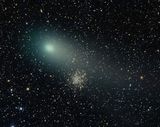 COMET GARRADD MEETS M71: This weekend, amateur astronomers around the world are watching the green tail of Comet Garradd (C/2009 P1) sweep across golden star cluster M71. Nick Howes sends this picture of the encounter from Cherhill in Wiltshire UK:
COMET GARRADD MEETS M71: This weekend, amateur astronomers around the world are watching the green tail of Comet Garradd (C/2009 P1) sweep across golden star cluster M71. Nick Howes sends this picture of the encounter from Cherhill in Wiltshire UK:
Discovered two years ago by Gordon Garradd in Australia, the 8th-magnitude comet is currently visible through small telescopes in the constellation Sagitta inside the evening Summer Triangle (finder charts). The comet is approaching the sun and brightening; recent projections place it at peak magnitude 6 in February 2012, just at the limit of naked eye visibility. Because Comet Garradd is a first-time visitor to the inner solar system, however, it could behave in unexpected ways. Stay tuned for surprises.
Spaceweather.com, 28th August 2011
Comet Elenin Breaks Up
spaceweather.com, 30th August 2011
 SO MUCH FOR DOOMSDAY: Comet Elenin (C/2010 X1), widely known for inaccurate reports of its threat to Earth, appears to be breaking apart. Observations by amateur astronomer Michael Mattiazzo of Castlemaine, Australia show a rapid dimming and elongation of the comet's nucleus akin to that of Comet LINEAR (C/1999 S4), which also disintegrated when it approached the sun in 2000. Comets are fragile objects, so this development while unexpected comes as no surprise. Readers with pertinent images of Elenin are invited to submit them here.
SO MUCH FOR DOOMSDAY: Comet Elenin (C/2010 X1), widely known for inaccurate reports of its threat to Earth, appears to be breaking apart. Observations by amateur astronomer Michael Mattiazzo of Castlemaine, Australia show a rapid dimming and elongation of the comet's nucleus akin to that of Comet LINEAR (C/1999 S4), which also disintegrated when it approached the sun in 2000. Comets are fragile objects, so this development while unexpected comes as no surprise. Readers with pertinent images of Elenin are invited to submit them here.
Comment: Really, the hype over this little comet has been ridiculous... it did not even light up in a spectacular way, whilst approaching the sun... However, Comet Garradd has appeared (image icon above) so we can expect some doomers to state they made a mistake and that Garradd is the new harbinger of doom...
Spaceweather.com, 28th August 2011
 COMET GARRADD MEETS M71: This weekend, amateur astronomers around the world are watching the green tail of Comet Garradd (C/2009 P1) sweep across golden star cluster M71. Nick Howes sends this picture of the encounter from Cherhill in Wiltshire UK:
COMET GARRADD MEETS M71: This weekend, amateur astronomers around the world are watching the green tail of Comet Garradd (C/2009 P1) sweep across golden star cluster M71. Nick Howes sends this picture of the encounter from Cherhill in Wiltshire UK:
Discovered two years ago by Gordon Garradd in Australia, the 8th-magnitude comet is currently visible through small telescopes in the constellation Sagitta inside the evening Summer Triangle (finder charts). The comet is approaching the sun and brightening; recent projections place it at peak magnitude 6 in February 2012, just at the limit of naked eye visibility. Because Comet Garradd is a first-time visitor to the inner solar system, however, it could behave in unexpected ways. Stay tuned for surprises.
Comet Elenin Could Be Disintegrating
Universe Today, 29th August 2011
 Astronomers monitoring Comet Elenin have noticed the comet has decreased in brightness the past week, and the coma is now elongating and diffusing. Some astronomers predict the comet will disintegrate and not survive perihelion, its closest approach to the Sun.
Astronomers monitoring Comet Elenin have noticed the comet has decreased in brightness the past week, and the coma is now elongating and diffusing. Some astronomers predict the comet will disintegrate and not survive perihelion, its closest approach to the Sun.
On August 19, a massive solar flare and coronal mass ejection hit the comet, which may have been the beginning of the end for the much ballyhooed lump of ice and dirt.
“We've been following it in the STEREO spacecraft images and a number of amateurs have been following it in their telescopes,” said Australian amateur astronomer Ian Musgrave, author of the Astroblog website. “Shortly after the coronal mass ejection the comet flared up and you could see some beautiful details in the tail, with the tail was twisting about in the solar wind. But shortly after that Earth- bound amateurs reported a huge decrease in the intensity of the comet. We think it may presage a falling apart of the comet.”
One journalist joked that maybe Comet Elenin just couldn't take all the doomsday talk and publicity. [...]
Unfortunately, the likely demise of Comet Elenin hasn't put a lid on the doomsdayers who have predicted earthquakes or three days of darkness or a collision with Earth.
Comment: This is an excellent write-up on what has been happening with Comet Elenin.
Comet Elenin Could Be Disintegrating
Universe Today, 29th August 2011
 Astronomers monitoring Comet Elenin have noticed the comet has decreased in brightness the past week, and the coma is now elongating and diffusing. Some astronomers predict the comet will disintegrate and not survive perihelion, its closest approach to the Sun.
Astronomers monitoring Comet Elenin have noticed the comet has decreased in brightness the past week, and the coma is now elongating and diffusing. Some astronomers predict the comet will disintegrate and not survive perihelion, its closest approach to the Sun.
On August 19, a massive solar flare and coronal mass ejection hit the comet, which may have been the beginning of the end for the much ballyhooed lump of ice and dirt.
“We've been following it in the STEREO spacecraft images and a number of amateurs have been following it in their telescopes,” said Australian amateur astronomer Ian Musgrave, author of the Astroblog website. “Shortly after the coronal mass ejection the comet flared up and you could see some beautiful details in the tail, with the tail was twisting about in the solar wind. But shortly after that Earth- bound amateurs reported a huge decrease in the intensity of the comet. We think it may presage a falling apart of the comet.”
One journalist joked that maybe Comet Elenin just couldn't take all the doomsday talk and publicity. [...]
Unfortunately, the likely demise of Comet Elenin hasn't put a lid on the doomsdayers who have predicted earthquakes or three days of darkness or a collision with Earth.
Comment: This is an excellent write-up on what has been happening with Comet Elenin.
Surprise! Alien Planet Made of Diamond Discovered
Yahoo News, 25th August 2011
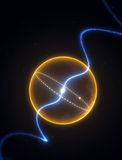 A newly discovered alien planet that formed from a dead star is a real diamond in the rough.
A newly discovered alien planet that formed from a dead star is a real diamond in the rough.
The super-high pressure of the planet, which orbits a rapidly pulsing neutron star, has likely caused the carbon within it to crystallize into an actual diamond, a new study suggests.
The composition of the planet, which is about five times the size of Earth, is not its only outstanding feature. [Illustration of the diamond alien planet]
The planet's parent star is a special kind of flashing star known as a millisecond pulsar, a rapidly rotating neutron star formed from a supernova. The entire system, which is only the second of its kind ever discovered, is located about 4,000 light-years from Earth in the constellation of Serpens (The Snake).
Comment: The explanation here sounds like gibberish... Scientists are coming up with new ideas about crystalline pulsars too, but they are having the usual struggle to get people to re-think their previous analysis. What we are told is this is a planet that is the remains of a 'dead' star, but I prefer to think that this planet regardless of it's origins, has been transformed by it's internal energy being transmuted by energy from the pulsar into a crystalline core to act as a beacon of light and frequency. Anyway, scientists are now regularly finding planets with crystalline cores and I believe there is great significance in terms of these planets acting as great receivers and transmitters of the highest frequency energy in the universe. Pure quality.
Swift satellite alerts astronomers to cosmic accident in constellation Draco
Smithsonian Science, 24th August 2011
 Two studies appearing in the Aug. 25 issue of the journal Nature provide new insights into a cosmic accident that has been streaming X-rays toward Earth since late March. NASA's Swift satellite first alerted astronomers to intense and unusual high-energy flares from the new source in the constellation Draco.
Two studies appearing in the Aug. 25 issue of the journal Nature provide new insights into a cosmic accident that has been streaming X-rays toward Earth since late March. NASA's Swift satellite first alerted astronomers to intense and unusual high-energy flares from the new source in the constellation Draco.
“Incredibly, this source is still producing X-rays and may remain bright enough for Swift to observe into next year,” said David Burrows, professor of astronomy at Penn State University and lead scientist for the mission's X-Ray Telescope instrument. “It behaves unlike anything we've seen before.” [...]
The innermost gas in the disk spirals toward the black hole, where rapid motion and magnetism create dual, oppositely directed “funnels” through which some particles may escape. Jets driving matter at velocities greater than 90 percent the speed of light form along the black hole's spin axis. In the case of Swift J1644+57, one of these jets happened to point straight at Earth.
Comment: There are a lot of versions of this astronomical story and some are more informative than others, but a beam of X-rays has been detected by the Swift satellite that is in orbit around Earth coming from this so-called 'black hole' collision. Briefly, planet Earth has been bathed in x-rays from this cosmic event since March 28th when major flares were detected but please note, the 'norm' before this event was 30 seconds! See April 2011, 'News of the Imbalance' archive Cosmic Explosion So Strange Scientists Say It's “Unprecedented”. The question we have to ask is whether there is any impact on the energies around Earth (e.g. whistler waves that our scientists don't have a clue why they exist) and whether Earth is being re-tuned.
NASA's Swift Satellite Spots Black Hole, J164444+57, Devouring A Star, Watch An Animated Recreation
Daily Kos, 26th August 2011
Scientific paper in Nature using
the Monitor of All-sky X-ray Image (MAXI) on Kibo and the Swift satellite (USA) observations
- First observation of a massive black hole swallowing a star -
Jaxa News, 25th August 2011
"The Monitor of All-sky X-ray Image (MAXI) on Kibo, in coordination with the gamma-ray burst satellite Swift (USA), observed the instant that a massive black hole swallowed a star for the first time in the world, located in the center of a galaxy 3.9 billion light years away. This result was published in Nature online, issued on August 25 Japan time. The title of the paper is "Relativistic Jet Activity from the Tidal Disruption of a Star by a Massive Black Hole".
The mystery of Comet Elenin
RT News, 19th August 2011
 Astronomers and other outer space experts are speaking out on a comet expected to make a close call with colliding into Earth later this year. The consequences could be dire, so why are so many people unaware of it?
Astronomers and other outer space experts are speaking out on a comet expected to make a close call with colliding into Earth later this year. The consequences could be dire, so why are so many people unaware of it?
“I think it's worth a raised eyebrow” says author Brooks Agnew. He's done a lot of research on Elenin and tells RT that there are some rather strange coincidences regarding the comet that people should take into consideration.
“A lot of people are concerned about it,” says Agnew. “We've done a lot of research on Comet Elenin and what we've found is there's a lot of missing data on this comet”
Agnew says that NASA calls the comet just “a harmless little fuzzball of ice” that won't come within more than 20 million miles from Earth. Others, he says, are claiming that this comet should raise concern since it doesn't look like a comet, doesn't act like a comet and is coming from outside of the area where most comets are accustomed to originate out of.
“There are a lot of things about this comet that don't make sense,” Agnew says.
Comment: The author Brooks Agnew being interviewed ( see video) has a strange smirk on his face.... this is something I have noticed with conspiracy theorists, but I don't know if they are enjoying the attention or really enjoy frightening people or both... At the moment, I think Comet Elenin is a diversion from the huge asteroid YU55 that is coming quite close to Earth. It is a huge space rock, 1,300ft wide [400 meters] and weighs 55million tons - the largest object ever to approach our planet so close. Yet, there are so many asteroids and comets brushing past Earth, that the analogy of Earth being in a cosmic bowling alley is now quite appropriate.
NASA Answers Your Questions About Comet Elenin
NASA.gov, August 2011
NASA Calls Comet Elenin "Wimpy"
International Business Times, 17th August 2011
IBTIMES TV: NASA Calls Comet Elenin "Wimpy"
YouTube, 17th August 2011
""Often, comets are portrayed as harbingers of gloom and doom in movies and on television, but most pose no threat to Earth," NASA officials said. "Comet Elenin, the latest comet to visit our inner solar system, is no exception."
Astronomy Without A Telescope – Impact Mitigation
Universe Today, 13th August 2011
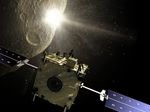 The save-the-Earth rehearsal mission Don Quijote, commissioned by the European Space Agency, is planned to test the potential of a real life-or-death mission to deflect a mass-extinction-inducing asteroid from a collision course with Earth.
The save-the-Earth rehearsal mission Don Quijote, commissioned by the European Space Agency, is planned to test the potential of a real life-or-death mission to deflect a mass-extinction-inducing asteroid from a collision course with Earth.
Currently at 'concept' stage, the Don Quijote Near Earth Asteroid Impact Mitigation Mission – has been modelled on a proposed flight to either 2002 AT4 or 1989 ML, both being near-Earth asteroids, though neither represent an obvious collision risk. However, subsequent studies have proposed that Amor 2003 SM84 or even 99942 Apophis may be more suitable targets. After all, 99942 Apophis does carry a marginal (1 in 250,000) risk of an Earth impact in 2036.
Whatever the target, a dual launch of two spacecraft is proposed – an Impactor called Hidalgo (a title Cervantes gave to the original Don Quixote) and an Orbiter called Sancho (who was the Don's faithful companion).
Comment: Historically comets are more of a problem than asteroids and according to an astronomer that has not been gagged, there is a cometary debris train on it's way to arrive in 2016 and again in 2023, (see archives). Since the report stated that if the comet "hit" Earth it could be "potentially hazardous" but since they have not spotted the comet, just a train of debris, it seems to me this should really be called a plasmoid train. So, if it's big enough, it might produce our three days of darkness. If this happens then that will be the full initiation for the start of Earth's Space Weather era in terms of Mayan thinking. Yes, I know, lot's of ifs.
Antimatter belt around Earth discovered by Pamela craft
BBC News, 7th August 2011
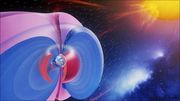 A thin band of antimatter particles called antiprotons enveloping the Earth has been spotted for the first time.
The find, described in Astrophysical Journal Letters, confirms theoretical work that predicted the Earth's magnetic field could trap antimatter.
The team says a small number of antiprotons lie between the Van Allen belts of trapped "normal" matter.
A thin band of antimatter particles called antiprotons enveloping the Earth has been spotted for the first time.
The find, described in Astrophysical Journal Letters, confirms theoretical work that predicted the Earth's magnetic field could trap antimatter.
The team says a small number of antiprotons lie between the Van Allen belts of trapped "normal" matter.
Comment: Well, we have Terrestrial Gamma-ray Bursts (TGFs) in our atmosphere that are supposed to be creating anti-matter too, so this article is quite vague as we don't know whether this is a new development or if they have detected something for the first time that has always been there. The article at dailygalaxy.com tells us that the anti-matter is coming from Earth's atmosphere due to cosmic ray collisions and I can only assume the anti-matter is being generated by a chain reaction of cosmic interacting with the atmosphere and producing gamma rays and the gamma rays producing anti-matter. Whatever, cosmic rays creating TGFs is new news and confirms what I have been thinking for quite some time, as I speculated about the cause of TGFs in my book that was published in September 2006.
-
"Cosmic Ray" Belt Around Earth Verified
Daily Galaxy, 8th August 2011
 Italian researchers, led by Piergiorgio Picozza from the University of Rome, using data from the satellite PAMELA have proven that theories showing there ought to be a ring of antiprotons, called the Van Allen radiation belt, encircling the Earth due to cosmic rays colliding with nuclei in the upper atmosphere are correct.
Italian researchers, led by Piergiorgio Picozza from the University of Rome, using data from the satellite PAMELA have proven that theories showing there ought to be a ring of antiprotons, called the Van Allen radiation belt, encircling the Earth due to cosmic rays colliding with nuclei in the upper atmosphere are correct.
Physicists have theorized that the constant stream of cosmic rays generated by the sun and other little understand sources must produce a shower of sorts of smaller particles when they collide with other nuclei in the Earth's upper atmosphere and break apart. Some of those smaller particles have been assumed to be antiprotons, many of which would be annihilated when colliding with particles of ordinary matter.
Trail of crumbs discovered from potentially hazardous comet
The February Eta Draconids appear to originate from a long-period comet that passes close to Earth's orbit.
Astronomy News, 29th July 2011
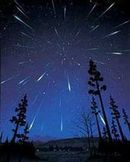 The Central Bureau issued a telegram July 10 for Astronomical Telegrams of the International Astronomical Union (IAU) announcing that a stream of dust from a potentially dangerous comet impacted Earth for a few hours last February 4.
The Central Bureau issued a telegram July 10 for Astronomical Telegrams of the International Astronomical Union (IAU) announcing that a stream of dust from a potentially dangerous comet impacted Earth for a few hours last February 4.
“This particular shower happens only once or twice every 60 years,” said Peter Jenniskens from the Search for Extraterrestrial Intelligence (SETI) Institute, Mountain View, California. “The stream of dust is always there, but quite invisible just outside of Earth's orbit. Only when the planets steer the dust in Earth's path do we get to know it is there.” [...]
Now that the February Eta Draconid shower has been discovered, Jenniskens is confident that a next return can be predicted. He teamed up with Finnish astronomer Esko Lyytinen to investigate. Lyytinen calculated a possible return in 2016 or 2023, after that not again until 2076.
Future observations of this shower may bring other information about the comet that caused this stream of meteoroids, which is a potential danger to Earth. “If the meteoroids can hit us, so can the comet,” said Jenniskens, “We don't know whether the comet has already passed us by or is still on approach.” To get some advance warning, one could look along the measured orbit to those spots where the comet could arrive at Earth's orbit on a future February 4 date.
“Even then, chances are very small that the comet will actually hit us, as such impacts are rare in Earth's history,” Jenniskens added.
Comment: This is another version of the cometary debris story. The point that must be made clear is that the comet does not have to hit us to cause havoc on Earth. In describing the Taurid Stream, which is similar type of cometary object, we read it is:
"...a procession of vast cosmic rubble and dust that snakes around the Sun and out towards Jupiter, will swing through Earth's orbit for the first of its bi-annual crossings.
Within the stream are probably thousands of bodies including asteroids, mountain-and island-sized boulders, smaller meteoroids, Encke's Comet and assorted fragments of celestial refuse."
A cosmic trail with destruction in its wake
The Times, May 24, 1990, Thursday
I would recommend reading the whole article from The Times. Well,we are not talking about bread crumbs here... Victor Clube, who is known as a ''catastrophist'', says the worse case scenario is a ''Multiple Tunguska Bombardment''. So when astronomers who are not ''catastrophists'', warn that there is a potentially hazardous bombardment on it's way that could collide with Earth, they understand the seriousness of making that call. Even if we don't get a direct hit, I think the concern would be dust loading up the Earth's atmosphere and even blotting out the Sun.... Could we get the promised Mayan three days of darkness? I simply don't know, but as more and more changes in the cosmic environment are being reported and things progress, I have gone from a skeptic to thinking this could actually happen. Now, I am wondering about the latest fabulous crop circle depicting a cosmic snake, maybe something else is out there that our astronomers have not spotted, see West Woodhay Down, Nr Inkpen, Wiltshire. Reported 29th July..
Unseen comet's orbit indicates possible crash
San Francisco Chronicle, 28th July 2011
 A stream of dusty fragments from a comet born in the outermost reaches of the solar system has hit the Earth on a path that leads astronomers to conclude the comet itself could be "potentially hazardous" if it crashes into the planet.
A stream of dusty fragments from a comet born in the outermost reaches of the solar system has hit the Earth on a path that leads astronomers to conclude the comet itself could be "potentially hazardous" if it crashes into the planet.
The comet's location is unknown, making it difficult to say when it will approach Earth, but "the orbits of the dust trail tells us that the
comet is on a path that could eventually hit us," said Peter Jenniskens, an astronomer at the SETI Institute and the NASA Ames Research Center in Mountain View.
"It's very unlikely," he conceded Wednesday. "Such impacts are extremely rare in Earth's history." [Really?...]
"I couldn't believe my eyes at first," he said. But once he had had determined the identical orbits of the fragments he teamed with Finnish astronomer Esko Lyytinen to predict that the dust trail will return in 2016, again in 2023, and once again in 2076. [...]
Jenniskens' scientific report will be published by the Journal of the International Meteor Organizations. Its title is: "Discovery of the February Eta Draconids: the dust trail of a potentially hazardous long-period comet."
Comment: Major News Well, well, well, it looks like the issue of the comet vs asteroid threat is now rearing up.... I wrote about this in my White House report that every 5-10 generations, Earth gets hit by cometary debris, an event that is much more frequent than being hit by a large asteroid. According to British astronomer Victor Clube, the consequences are always evolutionary, but this occurrence is a total embarrassment to the powers that be who prefer to hush-up and hide the evidence, as it's a regular occurence that they cannot control.... Oh how interesting.... I wonder if NASA will bother to issue a press release...
-
NASA Prepares for Potentially Damaging 2011 Meteor Shower
Space.com, 16th June 2010 -- flashback--
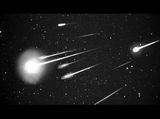 NASA is assessing the risk to spacecraft posed by the upcoming 2011 Draconid meteor shower, a seven-hour storm of tiny space rocks that has the potential to ding major Earth-orbiting spacecraft like the crewed International Space Station and Hubble Space Telescope.
NASA is assessing the risk to spacecraft posed by the upcoming 2011 Draconid meteor shower, a seven-hour storm of tiny space rocks that has the potential to ding major Earth-orbiting spacecraft like the crewed International Space Station and Hubble Space Telescope.
The meteor shower risk assessment is actually more art than science, and there has been some variation in the projected intensity levels of the 2011 Draconids by meteoroid forecasters. But spacecraft operators are already being notified to weigh defensive steps.
Current meteor forecast models project a strong Draconid outburst, possibly<>Ba full-blown storm, on Oct. 8, 2011, according to William Cooke of the Meteoroid Environment Office at NASA's Marshall Space Flight Center in Huntsville, Ala. [...]
Cooke said that a significant fraction of spacecraft anomalies produced by shower meteoroids are caused by electrostatic discharges when meteoroid meets satellite.
And while no spacecraft electrical problems were reported during the strong Draconid outbursts of 1985 and 1998, he said that the lack of past anomalies should not be taken as carte blanche for satellite operators to ignore in 2011. [...]
"Because we can now forecast them, we have a way of putting it. If you are hit by a sporadic [meteor], it's an act of God. If you are hit by a shower meteoroid, it's an act of negligence," Cooke said.
Comment: OK, I have come across this old article and I am wondering: why the concern? Well, we are given a hint here that the conditions in space have changed. From this article, I wonder if these pre-existing meteor 'streams' can actually grow because they are hinting at how hard it is to estimate "intensity levels", and a variation in the order of magnitude is significant. If you want an analogy, think in terms of a spoon stiring soup. The soup of space has recently got thicker so there is more of a disturbance and more being carried on the spoon. But, as the article states, the world's communication satellite infrastructure is under threat, so I presume there are major players who will be holding their breath until it's all over and damage can be assessed. It is likely that Earth will be a graced with delicate sprinkling of aetheric energies too, alongside the meteor shower!
A glowing bubbly bauble in space
Discover Bad Astronomy, 25th July 2011
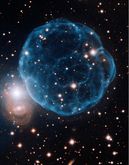 Look, I've been around the block a few times. I've spent my whole life as an astronomer, so I've seen pretty much every big, bright object there is in the sky.
Look, I've been around the block a few times. I've spent my whole life as an astronomer, so I've seen pretty much every big, bright object there is in the sky.
However, "pretty much" != "all". It's still possible to surprise me, and folks, let me tell you: the Gemini telescope's observation of the nebula Kronberger 61 did just that!
Wow! It looks like a buckeyball or a soccerball; my wife pointed out it looks like the shape you get when you use a bubble maker to make a bunch of bubbles all stuck together. Kn 61, as it's called, is actually a planetary nebula, the gas flung off by a star like the Sun as it dies. You can get the details (along with many pretty pix) of how this works in a recent post of mine. In a nutshell, when a star runs out of useable hydrogen fuel in its core, it expands into a red giant and expels a huge wind of gas. This strips away the outer layers of the star, revealing the hot, dense core. Ultraviolet light from that star then lights up the surrounding gas, making these gorgeous nebulae.
The exact mechanisms for this process, however, are still not clear. [Well that is not a surprise...]
Comment: This image is for anyone who still doubts that we live in a Plasma universe. Even the author here, the well astronomy skeptic Phil Plait was surprised... yep that is an amazing sight and it makes you wonder what is going on in the bubble world... Instead of providing my usual comments about the properties of plasma, I have decided to highlight one of the comments
 Josie Says:
Josie Says:
July 25th, 2011 at 3:07 pm
Neato! Yet another astronomical comparison to what I get to see at work everyday. That bubble looks amazingly like a very cystic teratoma caused by undifferentiated stem cells (I advise not googling images for that if you are at all squeamish…not all teratomas are umm…that clean).
The other thing I see every day is 'galaxy in a petri dish' . Growing cells in rotational culture makes little clusters of cells. if you alter the rotation the clusters develop little spiral arms.
I really enjoy seeing similar forms under my microscope and then through a telescope. It gives me a comforting sense of perspective and continuity
I have added an image icon of stems cells, that clearly demonstrates the metaphysical concept of 'As Above, So below' that is extremely easy to appreciate when it comes to plasma. Scientists can prove in the laboratory that plasma can scale up to many orders of magntitude but then we can look up into the heavens to see the truly huge scale of plasma formations in space.
Ribbon in the dust: The strange twisted ring of gas at the centre of the Milky Way
Daily Mail, 20th July 2011
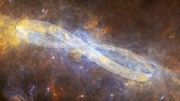 A bizarre, twisted ring of dense gas at the centre of our Milky Way galaxy has been observed by the Herschel Space Observatory.
Only a few portions of the ring, which stretches across more than 600 light-years, were known before. But Herschel's view reveals the entire ring for the first time - and a strange kink that resembles a ribbon has astronomers scratching their heads. [...]
A bizarre, twisted ring of dense gas at the centre of our Milky Way galaxy has been observed by the Herschel Space Observatory.
Only a few portions of the ring, which stretches across more than 600 light-years, were known before. But Herschel's view reveals the entire ring for the first time - and a strange kink that resembles a ribbon has astronomers scratching their heads. [...]
The twist in the ring is not the only mystery to come out of the new Herschel observations. Astronomers say that the centre of the torqued portion of the ring is not where the centre of the galaxy is thought to be, but slightly offset. The centre of our galaxy is considered to be around Sagittarius A, where a massive black hole lies. According to Dr Noriega-Crespo, it's not clear why the centre of the ring doesn't match up with the assumed centre of our galaxy.
Comment: I picked the Daily Mail version because there were two images and the 2nd image was added with the mobius strip figure 8 outlined for clarity. Here is the version at spacedaily.com, Twisted Tale of our Galaxy's Ring. In my research, I have come to the conclusion that many people have been mislead by all the hype about the Galactic Center and the evidence suggests that we should be interested in the center of the galaxy, but as we are being told here, they are not the same thing. Well, this is very interesting, a mobius strip figure 8 in space. This is probably a massive challenge for cosmologists with their outdated theories of the force of gravity directing cosmological evolution. From a metaphysical point of view, a torus and figure 8 loop must indicate some specific energy center. Fascinating...
Cape doctor says he's not leading survivalist group and has been harassed by believers in 'Planet X'
SE Missourian, 10th July 2011
 Dr. Byron Glenn of Cape Girardeau says he wants nothing to do with the people he sees as online crackpots trumpeting a "conspiracy wrapped in an enigma."
Dr. Byron Glenn of Cape Girardeau says he wants nothing to do with the people he sees as online crackpots trumpeting a "conspiracy wrapped in an enigma."
He's not alone. The folks at NASA have fruitlessly tried to debunk what they say are wild conspiracies involving Comet Elenin -- a "wimpy" projectile expected to remain more than 20 million miles from Earth.
Glenn said he's been harassed and threatened by doomsday believers of "Planet X," an idea spreading in the blogosphere and in online chat rooms about a brown dwarf star, a low-mass object rapidly approaching the solar system and bent on destroying much of the Earth.
Comment: How can anyone believe it's possible to see a Brown dwarf 10 - 30 light years away from your backyard with an ordinary telescope? In 2009, at a discovery rate running at over 3,000 per month, there were of 535,000 registered minor planets in our solar system, hence I think it's amazing that our astronomers can spot anything coming our way. Anyway, this is a totally strange, I can't really understand why people are so frightened by the mediocre Comet Elenin, but I think it must be associated with a general climate of fear related to Earth changes and citizens of the United States who have been force fed on a high diet of fear all their lives to make them controllable. Well, I suppose the truly ignorant will assume that the growing number of voices, a whole list of scientific establishments like NASA and the European Space Agency, corporations like Insurance giant Lloyd's of London and various governments and even the US military, who have been openly providing information to the world via the interent about the issue of Space Weather for the last 20+ years, are all just scaremongering. Having intensely researched Space Weather for 6 years and having the ability to think and come to realistic conclusions, this has to be the case or else I could not have written my book in my efforts to integrate the science and the metaphysical implications and been proven right, the real issue is how so few people realised the full implications. The reality is that conditions in our solar system have changed and Earth's magnetic shielding has weakened to the extent that our world is threatened by the occurence of a celestial deluge that could seriously damage the infrastructure of modern technological world. Therefore, I think the difference between those voices who have chosen to warn the world and the ignoranti, is those who are paying attention to reality and understand it and those who are incapable.
Infrared Telescopes Find Ultra-Cool Brown Dwarf
Discovery News, 18th November 2010
Nasa fights to save the James Webb space telescope from the axe
Astronomers shocked by House of Representatives' move to scrap deep-space observatory after costs soar to $6.5bn
The Guardian, 9th July 2011
 Nasa is fighting to save its next-generation space observatory, the James Webb Space Telescope. Politicians want to end the project – one of the most complex ever conceived by space engineers – even though billions of dollars have already been spent on its construction.
Nasa is fighting to save its next-generation space observatory, the James Webb Space Telescope. Politicians want to end the project – one of the most complex ever conceived by space engineers – even though billions of dollars have already been spent on its construction.
Scheduled for launch in 2016, the James Webb, intended to replace the ageing Hubble Space Telescope, would orbit in deep space, a million miles from Earth, and peer into the dawn of the universe. Its observations would answer major questions about the structure of the cosmos, say astronomers.
The cost of the observatory has soared from an initial estimate of $1.6bn (£996m) to more than $6.5bn (£4bn).
Comment: Oh dear! Besides the cost overrun being typical for these kind of projects, NASA are hardly likely to tell the House of Representatives that the James Webb Space Telescope would be most likely used to monitor any major threats from outer space, rather than the innocuous cover story of learning about the dawn of the universe. Just basic research into Earth's history and especially catastrophism will reveal that Earth is regularly affected by cosmic events. Hence, NASA would be one of the major agencies keeping a watchout. This is especially true as the rush to build telescopes and place them in the southern hemisphere implies there is evidence that something is of great interest and when it is clear the cosmic evironment of our solar system is no longer as quiet as it used to be.
Believers In Mysterious Planet Nibiru Await Earth's End
Space.com, 7th July 2011
 [...] The waxing obsession with Nibiru, which conspiracy theorists say is a planet swinging in from the outskirts of our solar system that is going to crash into Earth and wipe out humanity in 2012 – or, in some opinions, 2011 – shows that an astonishing number of people "are watching YouTube videos and visiting slick websites with nothing in their skeptical toolkit," in the words of David Morrison, a planetary astronomer at NASA Ames Research Center and senior scientist at the NASA Astrobiology Institute.
[...] The waxing obsession with Nibiru, which conspiracy theorists say is a planet swinging in from the outskirts of our solar system that is going to crash into Earth and wipe out humanity in 2012 – or, in some opinions, 2011 – shows that an astonishing number of people "are watching YouTube videos and visiting slick websites with nothing in their skeptical toolkit," in the words of David Morrison, a planetary astronomer at NASA Ames Research Center and senior scientist at the NASA Astrobiology Institute.
Morrison estimates that there are 2 million websites discussing the impending Nibiru-Earth collision. He receives, on average, five email inquiries about Nibiru every day.
Comment: No, I am not a believer and I have generally stayed well away from the Nibiru topic. However I was surprised to read here that Comet Elenin is coming in so close and I do believe that comets can generate electromagnetic effects and associated planetary alignments do matter. However, I am apalled that Dr David Morrison is still getting emails from young terrified children and I am fed up as usual that people are peddling doom but don't provide the context that we can expect chaos at a time of evolutionary change or it is impossible to have change. Yes, what is going on in the heavens is important but the speculation and constant changing of what is relevant suggests that information is being used to keep people in a state of agitation where they are much more likely to 'jump' and 'buy' on command. Meanwhile, Space Weather is now changing our world FACT and very few are paying attention despite the efforts of credible agencies and you have to wonder why so few are actually interested in a real IMPACT on our world. I don't know about you, but I seriously think that humanity has to carefully consider how we are going to survive on this planet as we are currently not making much progress adapting to the new evolutionary impetus.
Comet Elenin will not destroy the Earth
Astro Bob, 4th April 2011
"I did a search for Comet Elenin the other day and was surprised at how much gloom-and-doom blather has been written about this modest comet. The misinformation covers the full range of nonsense – everything from the name 'Elenin' being a coded message for 'Extinction Level Event Notable Impact Nemesis' to the comet being a secret brown dwarf star called Nibiru (which doesn't exist). Some are even spreading the rumor that Leonid Elenin the person doesn't actually exist."
Nice background information and diagrams. The comparison with Venus is especially useful.
A Big Surprise from the Edge of the Solar System
NASA Science News, 9th June 2011
 June 9, 2011: NASA's Voyager probes are truly going where no one has gone before. Gliding silently toward the stars, 9 billion miles from Earth, they are beaming back news from the most distant, unexplored reaches of the solar system.
June 9, 2011: NASA's Voyager probes are truly going where no one has gone before. Gliding silently toward the stars, 9 billion miles from Earth, they are beaming back news from the most distant, unexplored reaches of the solar system.
Mission scientists say the probes have just sent back some very big news indeed.
It's bubbly out there.
"The Voyager probes appear to have entered a strange realm of frothy magnetic bubbles," says astronomer Merav Opher of Boston University. "This is very surprising.
Comment: The NASA video that accompanies this media release is quite succinct. The description of the new 'Foam Zone', makes me wonder how long it takes these scientists to come up with a phrase that sells an idea. Again, it's interesting that these scientists stated this discovery was a total surprise, but I would be prepared to bet that someone came up with idea before, but was was just completely ignored by those with less imagination and creative thinking ability.
Magnetic Effervescence
Thunderbolts.info, 13th June 2011
Predictable response form the EU theorists
Edge of Solar System Filled with Bubbles, NASA Says
Space.com, 6th June 2011
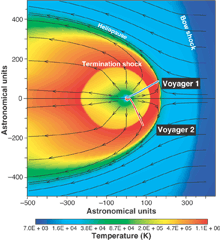 The edge of our solar system is filled with a turbulent sea of magnetic bubbles, according to new NASA research.
Scientists made the discovery by using a new computer model, which is based on data from NASA's twin Voyager probes. The unmanned Voyager 1 and Voyager 2, which launched in 1977, are plying the outer reaches of our solar system, a region known as the heliosheath.
The edge of our solar system is filled with a turbulent sea of magnetic bubbles, according to new NASA research.
Scientists made the discovery by using a new computer model, which is based on data from NASA's twin Voyager probes. The unmanned Voyager 1 and Voyager 2, which launched in 1977, are plying the outer reaches of our solar system, a region known as the heliosheath.
The new discovery suggests that researchers will need to revise their views about the solar system's edge, NASA officials said. A more detailed picture of this region is key to our understanding of how fast-moving particles known as cosmic rays are spawned, and how they reach near-Earth space.
Comment: Again, NASA are making another announcement about what is going on at the edge of our solar system. Yes, this is historic stuff, our whole solar system is experiencing massive evolutionary change being driven by an energy influx from outside our solar system but due to a ripple effect, changes on Earth have now become noticeable.
Solar System Explained From the Inside Out
Space.coms, 2nd June 2011
Nice infographic
Free-Floating Planets May Be More Common Than Stars
NASA News, 18th May 2011
 Astronomers have discovered a new class of Jupiter-sized planets floating alone in the dark of space, away from the light of a star. The team believes these lone worlds are probably outcasts from developing planetary systems and, moreover, they could be twice as numerous as the stars themselves.
Astronomers have discovered a new class of Jupiter-sized planets floating alone in the dark of space, away from the light of a star. The team believes these lone worlds are probably outcasts from developing planetary systems and, moreover, they could be twice as numerous as the stars themselves.
"Although free-floating planets have been predicted, they finally have been detected," said Mario Perez, exoplanet program scientist at NASA Headquarters in Washington. "[This has] major implications for models of planetary formation and evolution."
The discovery is based on a joint Japan-New Zealand survey that scanned the center of the Milky Way galaxy during 2006 and 2007, revealing evidence for up to 10 free-floating planets roughly the mass of Jupiter. The isolated orbs, also known as orphan planets, are difficult to spot, and had gone undetected until now. The planets are located at an average approximate distance of 10,000 to 20,000 light years from Earth.
Comment: Of course, people are linking this to the belief in the existence of Sitchin's Nibiru recorded in antiquity, but apparently that is not due until 2900. What's more, there are other astronomical factors not widely know that needs to be considered when it comes to stars invading our region of space. Whatever, the fact is that astronomers think these stray planets may exist based on mathematical computations and research has been ongoing for many years. Therefore, it is quite interesting to consider that this is another reminder that most people have no idea what is really happening in our local region of space that might be effecting us on Earth.
Scientists report finding floating planets (Video)
NHK World, 19th May 2011
Comet Elenin: Preview of a Coming Attraction
NASA News, 4th May 2011
 You may have heard the news: Comet Elenin is coming to the inner-solar system this fall. Comet Elenin (also known by its astronomical name C/2010 X1), was first detected on Dec. 10, 2010 by Leonid Elenin, an observer in Lyubertsy, Russia, who made the discovery "remotely" using the ISON-NM observatory near Mayhill, New Mexico.
You may have heard the news: Comet Elenin is coming to the inner-solar system this fall. Comet Elenin (also known by its astronomical name C/2010 X1), was first detected on Dec. 10, 2010 by Leonid Elenin, an observer in Lyubertsy, Russia, who made the discovery "remotely" using the ISON-NM observatory near Mayhill, New Mexico.
At the time of the discovery, the comet was about 647 million kilometers (401 million miles) from Earth. Over the past four-and-a-half months, the comet has – as comets do – closed the distance to Earth's vicinity as it makes its way closer to perihelion (its closest point to the sun). As of May 4, Elenin's distance is about 274 million kilometers (170 million miles).
"That is what happens with these long-period comets that come in from way outside our planetary system," said Don Yeomans of NASA's Near-Earth Object Program Office at NASA's Jet Propulsion Laboratory in Pasadena, Calif. "They make these long, majestic, speedy arcs through our solar system, and sometimes they put on a great show. But not Elenin. Right now that comet looks kind of wimpy." [...]
At its closest point, it will be 35 million kilometers (22 million miles) from us. Can this icy interloper influence us from where it is, or where it will be in the future?
Comment: There seems to be a lot of smoke and mirrors going on at the moment. So while the nibiru/nemesis/tyche/brown dwarf/comet elenin folk are getting excited over the existence of various cosmic objects that may or may not exist, the real issue is the constant stream of asteroids and comets that are coming into our solar system and close by us on Earth, some are virtually invisible until they are nearly on top of us and sometimes they have whizzed close by us and some have only been seen when they have actually passed... I would suggest this is the REAL threat that is worrying world controllers... So, why are people getting excited about a comet that will come to within 35 million kilometers (22 million miles) from us when there are now objects routinely passing within the orbit of our moon and even within geostationary orbit? An ordinary comet is NOT going to have the influence that can explain the orbital changes related to the Earth and moon, nor the huge number of atmospheric and geophysical events taking place on Earth. I simply think that many people are swayed by whatever popular idea is being promoted, that's all.
Cosmic Explosion So Strange Scientists Say It's “Unprecedented”
Earthfiles, 29th April 2011

“SWIFT had never seen another object outside of our galaxy
appear to act this way. It is quite unlike anything we've known
before, except maybe blazars.”
- Andrew Fruchter, Ph.D., Astronomer, Space Telescope Science Institute
...on March 28, 2011, Swift picked up an unusually long, powerful gamma burst coming from the center of a galaxy 3.8 billion light-years from Earth. But instead of fading away, the object oscillated intense energy three times over more than a day and is still continuing to emit at a lower, but pretty constant level. For example, since April 3rd, the variable object has brightened by more than five times.
Astronomer Andrew Fruchter, Ph.D., at the Space Telescope Science Institute in Baltimore, Maryland, was involved in getting the Hubble Telescope's image of the mysterious blast combined with the Chandra X-Ray Observatory's image to confirm that the intense energy persists from the distant galaxy's center. [...]
It is a gamma ray burst, but in the sense that we now think gamma ray bursts are generally a specific phenomena.
AND THEY ONLY LAST ABOUT 30 SECONDS.
Yes, exactly! There are some that have lasted longer, but they don't come back and be just as powerful. They slowly die down and occasionally a little bit comes up again. But this (new object) has been quite extraordinary.
WE'RE TALKING ON APRIL 21, 2011, WHICH MEANS THIS OBJECT HAS BEEN PRESENT TO YOU AND YOU'VE BEEN COLLECTING DATA FOR AT LEAST 25 DAYS.
Comment: So this cosmic explosion is still ongoing and freaking out astronomers? Linda Moulton Howe interviews Astronomer Andrew Fruchter and he provides us with the opinion of a dazed astronomer... However, these days, this is just the latest record breaking star and as I have explained previously, I suspect that we will have to get use to extreme astronomical events as the new norm.
Voyager Set to Enter Interstellar Space
NASA Science News, 28th April 2011
 More than 30 years after they left Earth, NASA's twin Voyager probes are now at the edge of the solar system. Not only that, they're still working. And with each passing day they are beaming back a message that, to scientists, is both unsettling and thrilling.
More than 30 years after they left Earth, NASA's twin Voyager probes are now at the edge of the solar system. Not only that, they're still working. And with each passing day they are beaming back a message that, to scientists, is both unsettling and thrilling.
The message is, "Expect the unexpected."
"It's uncanny," says Ed Stone of Caltech, Voyager Project Scientist since 1972. "Voyager 1 and 2 have a knack for making discoveries."
Today, April 28, 2011, NASA held a live briefing to reflect on what the Voyager mission has accomplished--and to preview what lies ahead as the probes prepare to enter the realm of the Milky Way itself.
Comment: The video is a hoot but it's not really that informative.... It's done in an extremely old fashioned style that seems to be a throw back to the 1950s, a little weird really. Anyway, there is discussion of the Voyager 1 & 2 spacecraft being in the region known as the heliosheath an extra barrier around the heliosphere that is created by the pressure of the solar wind creating a bubble in space. In terms of plasma physics, the heliosheath is really a double layer that acts to make an electrical charge separater between different plasma regions. Well, there does not seem to be any info on what's been discovered in this region, but it's no doubt shocking if you get my drift... I want to know stuff like: what they hell is going on with the interstellar breeze that has turned into a gale and is now blowing some serious amounts of dusty plasma through this region into our solar system with some unknown effects?
A Galactic Rose Highlights Hubble's 21st Anniversary
PhysOrg.com, 21st April 2011
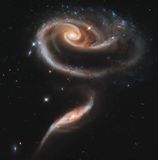 In celebration of the 21st anniversary of the Hubble Space Telescope's deployment into space, astronomers pointed Hubble at an especially photogenic group of interacting galaxies called Arp 273.
In celebration of the 21st anniversary of the Hubble Space Telescope's deployment into space, astronomers pointed Hubble at an especially photogenic group of interacting galaxies called Arp 273.
This image, taken by the NASA/ESA Hubble Space Telescope, shows a group of interacting galaxies called Arp 273. The larger of the spiral galaxies, known as UGC 1810, has a disc that is tidally distorted into a rose-like shape by the gravitational pull of the companion galaxy below it, known as UGC 1813. The swathe of blue jewels across the top is the combined light from clusters of intensely bright and hot young blue stars. These massive stars glow fiercely in ultraviolet light.
Comment: Halton Arp was known as "the most feared astronomer on Earth" (Kaufmann, 1981), because his observations contradicted established theory. He was branded as a heretic and exiled from academia in the USA, but he was offered a position at the Max Planck Institute for Physics and Astrophysics in West Germany. He is famed for his 1960s Atlas of Peculiar Galaxies and they highlight the fact that astronomers did not understand the physical processes that distort spiral or elliptical galaxies. According to Wikipedia, The Atlas of Peculiar Galaxies, it states that astronomers now do understand these processes, but it's still talk of astrophysical fluid dynamics and the fact that the universe is 99.999% is mainly ignored, when by understanding plasma physics and the electromagnetic nature of the universe, there are far more appropriate explanations that can be applied and tested in the laboratory.
Pluto's Expanding Atmosphere Confounds Researchers
Science, 19th April 2011
 Recent observations of Pluto reveal that the icy orb's atmosphere has expanded dramatically since 2000, and for the first time researchers have detected carbon monoxide. The findings may be evidence of seasonal changes in climate linked to Pluto's most recent close approach to the sun, but scientists still aren't sure about how those variations unfold over the course of each 248-year orbit.
Recent observations of Pluto reveal that the icy orb's atmosphere has expanded dramatically since 2000, and for the first time researchers have detected carbon monoxide. The findings may be evidence of seasonal changes in climate linked to Pluto's most recent close approach to the sun, but scientists still aren't sure about how those variations unfold over the course of each 248-year orbit.
Pluto is the only object orbiting in the frigid realm beyond Neptune that is known to have an atmosphere. That tenuous sheath of gas was discovered in 1988 when the “dwarf planet” passed between Earth and a distant star, blocking some of the star's light. Although telescopic observations at various wavelengths since the early 1990s have since identified several substances in Pluto's surface ices–including nitrogen, methane, and carbon monoxide–only methane had been detected previously in its atmosphere. [...]
The new observations also reveal that Pluto's atmosphere is growing. Data collected around the turn of the century suggested that Pluto's cold, diffuse atmosphere extended no more than 135 kilometers above the planet's surface, Greaves says. But she sees hints of an atmospheric expansion in data that she and her colleagues gathered using telescopes atop Hawaii's Mauna Kea on 11 nights scattered between August 2009 and May 2010. She says that the atmosphere now reaches heights of more than 3000 kilometers–a distance almost one-quarter of the way to Charon, Pluto's largest moon. “This is not what we expected,” Greaves says. “The atmosphere has changed so dramatically.”
Comment: As various researchers have pointed out, in the last twenty years there have been dramatic changes to ALL the planets in our solar system as the cosmic environment has dramatically changed. This is a good assessment by Richard Hoagland & David Wilcock from 2004, but many recent changes and observations are not included: Interplanetary “Day After Tomorrow?” Part 1.
Bizarre cosmic explosion observed
TG Daily, 8th April 2011
 Astronomers are poring over data from what they say is one of the most puzzling cosmic blasts ever observed.
They say they've never seen such a bright, variable, high-energy, long-lasting burst before. Usually, gamma-ray bursts mark the destruction of a massive star, and flaring emission from these events never lasts more than a few hours.
Astronomers are poring over data from what they say is one of the most puzzling cosmic blasts ever observed.
They say they've never seen such a bright, variable, high-energy, long-lasting burst before. Usually, gamma-ray bursts mark the destruction of a massive star, and flaring emission from these events never lasts more than a few hours.
On Monday, March 28, the Swift satellite's Burst Alert Telescope discovered the source in the constellation Draco when it erupted with the first in a series of powerful blasts.
Swift pinpointed a location for the explosion, now cataloged as gamma-ray burst (GRB) 110328A. And images taken by Hubble and the Chandra X-ray Observatory on Monday, April 4, showed it was at the center of a small galaxy 3.8 billion light-years away from Earth.
Astronomers previously have detected stars disrupted by supermassive black holes, but none has shown the X-ray brightness and variability of GRB 110328A.
Comment: Another celestial record breaker to note... My theory is that we have entred a region of space with different properties, so we are seeing things that are new to us, but not new to the cosmos.
Scientists isolate mysterious 'ribbon' of energy and particles that wraps around heliosphere
PhysOrg.com, 31st March 2011
 In a paper to be published in the April 10, 2011, issue of The Astrophysical Journal, scientists on NASA's Interstellar Boundary Explorer (IBEX) mission, including lead author Nathan Schwadron and others from the University of New Hampshire, isolate and resolve the mysterious "ribbon" of energy and particles the spacecraft discovered in the heliosphere – the huge bubble that surrounds our solar system and protects us from galactic cosmic rays.
In a paper to be published in the April 10, 2011, issue of The Astrophysical Journal, scientists on NASA's Interstellar Boundary Explorer (IBEX) mission, including lead author Nathan Schwadron and others from the University of New Hampshire, isolate and resolve the mysterious "ribbon" of energy and particles the spacecraft discovered in the heliosphere – the huge bubble that surrounds our solar system and protects us from galactic cosmic rays.
The finding, which overturns 40 years of theory, provides insight into the fundamental structure of the heliosphere, which in turn helps scientists understand similar structures or "astrospheres" that surround other star systems throughout the cosmos.
The ribbon of energy was captured using ultra-high sensitive cameras that image energetic neutral atoms (instead of photons of light) to create maps of the boundary region between our solar system and the rest of our galaxy.
Comment: Well, from a metaphysical point of view, all I can say is Fulcanelli nailed this. We have the 'snake', (IBEX ribbon) aligning with the 'cross' (the Galactic Alignment) which give us the approximate timeframe of the end of an age and the start of a brand new era. Many different traditions have preserved various details concerning ancient astronomical cycles and the impact on humanity and the Earth. The information indicated that we could a time of turmoil due to evolutionary change caused by a massive influx of cosmic energy. This is now scientifically verifiable in the arrival of Space Weather and for those who have been watching and understand the change as it is taking place, we are living in incredible times.
Is space like a chessboard?
Escience News, 18th March 2011
 Physicists at UCLA set out to design a better transistor and ended up discovering a new way to think about the structure of space. Space is usually considered infinitely divisible – given any two positions, there is always a position halfway between. But in a recent study aimed at developing ultra-fast transistors using graphene, researchers from the UCLA Department of Physics and Astronomy and the California NanoSystems Institute show that dividing space into discrete locations, like a chessboard, may explain how point-like electrons, which have no finite radius, manage to carry their intrinsic angular momentum, or "spin."
Physicists at UCLA set out to design a better transistor and ended up discovering a new way to think about the structure of space. Space is usually considered infinitely divisible – given any two positions, there is always a position halfway between. But in a recent study aimed at developing ultra-fast transistors using graphene, researchers from the UCLA Department of Physics and Astronomy and the California NanoSystems Institute show that dividing space into discrete locations, like a chessboard, may explain how point-like electrons, which have no finite radius, manage to carry their intrinsic angular momentum, or "spin."
While studying graphene's electronic properties, professor Chris Regan and graduate student Matthew Mecklenburg found that a particle can acquire spin by living in a space with two types of positions – dark tiles and light tiles. The particle seems to spin if the tiles are so close together that their separation cannot be detected.
"An electron's spin might arise because space at very small distances is not smooth, but rather segmented, like a chessboard," Regan said.
Comment: But of course.... this is basic esoteric knowledge... same as the polarity structure revealed by the holographic projection of human DNA... as above so below....
Russian Meteor Generates 100 Million Video View Record
Space.com, 22nd February 2013
According to a report from Visible Measures, video of last week's unprecedented meteor crash in a Russian city has generated over 100 million views across over 400 uploads in just three days' time.
That sets a new record for the fastest video clip to reach such a high viewer number, even outperforming the Red Bull: Stratos space jump that took place late last year.
Comment: This is exactly the opposite of what world leaders have tried for so long to avoid, the masses waking up to some cosmic reality...
The most breathtaking pictures yet of Russian meteorite: Photographer captured exploding space rock on camera... despite thinking it was nuclear bomb that would kill him
Daily Mail, 22nd February 2013
How many planets in Milky Way? At least 50 billion scientists say
The Star, 19th February 2011
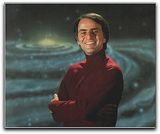 WASHINGTON–Scientists have estimated the first cosmic census of planets in our galaxy and the numbers are astronomical: at least 50 billion planets in the Milky Way.
At least 500 million of those planets are in the not-too-hot, not-too-cold zone where life could exist. The numbers were extrapolated from the early results of NASA's planet-hunting Kepler telescope.
WASHINGTON–Scientists have estimated the first cosmic census of planets in our galaxy and the numbers are astronomical: at least 50 billion planets in the Milky Way.
At least 500 million of those planets are in the not-too-hot, not-too-cold zone where life could exist. The numbers were extrapolated from the early results of NASA's planet-hunting Kepler telescope.
Kepler science chief William Borucki says scientists took the number of planets they found in the first year of searching a small part of the night sky and then made an estimate on how likely stars are to have planets. Kepler spots planets as they pass between Earth and the star it orbits.
So far Kepler has found 1,235 candidate planets, with 54 in the zone where life could possibly exist. Kepler's main mission is not to examine individual worlds, but give astronomers a sense of how many planets, especially potentially habitable ones, there are likely to be in our galaxy. They would use the one-four-hundredth of the night sky that Kepler is looking at and extrapolate from there. [...]
For many years scientists figured there were 100 billion stars in the Milky Way, but last year a Yale scientist figured the number was closer to 300 billion stars.
Either way it shows that Carl Sagan was right when he talked of billions and billions of worlds, said retired NASA astronomer Steve Maran, who praised the research but wasn't part of it.
And that's just our galaxy. Scientists figure there are 100 billion galaxies.
Comment: It really makes you wonder how people can believe that humans are alone in the cosmos, especially now that scientists have provided us with observational data, the probabilities are such that this belief is just totally unrealistic.
Can WISE Find the Hypothetical 'Tyche'?
JPL NASA, 18th February 2011
 In November 2010, the scientific journal Icarus published a paper by astrophysicists John Matese and Daniel Whitmire, who proposed the existence of a binary companion to our sun, larger than Jupiter, in the long-hypothesized "Oort cloud" -- a faraway repository of small icy bodies at the edge of our solar system. The researchers use the name "Tyche" for the hypothetical planet. Their paper argues that evidence for the planet would have been recorded by the Wide-field Infrared Survey Explorer (WISE).
In November 2010, the scientific journal Icarus published a paper by astrophysicists John Matese and Daniel Whitmire, who proposed the existence of a binary companion to our sun, larger than Jupiter, in the long-hypothesized "Oort cloud" -- a faraway repository of small icy bodies at the edge of our solar system. The researchers use the name "Tyche" for the hypothetical planet. Their paper argues that evidence for the planet would have been recorded by the Wide-field Infrared Survey Explorer (WISE).
WISE is a NASA mission, launched in December 2009, which scanned the entire celestial sky at four infrared wavelengths about 1.5 times. It captured more than 2.7 million images of objects in space, ranging from faraway galaxies to asteroids and comets relatively close to Earth. Recently, WISE completed an extended mission, allowing it to finish a complete scan of the asteroid belt, and two complete scans of the more distant universe, in two infrared bands. So far, the mission's discoveries of previously unknown objects include an ultra-cold star or brown dwarf, 20 comets, 134 near-Earth objects (NEOs), and more than 33,000 asteroids in the main belt between Mars and Jupiter.
Following its successful survey, WISE was put into hibernation in February 2011. [...]
Q: If Tyche does exist, why would it have taken so long to find another planet in our solar system?
A: Tyche would be too cold and faint for a visible light telescope to identify. Sensitive infrared telescopes could pick up the glow from such an object, if they looked in the right direction. WISE is a sensitive infrared telescope that looks in all directions.
Q: Why is the hypothesized object dubbed "Tyche," and why choose a Greek name when the names of other planets derive from Roman mythology?
A: In the 1980s, a different companion to the sun was hypothesized. That object, named for the Greek goddess "Nemesis," was proposed to explain periodic mass extinctions on the Earth. Nemesis would have followed a highly elliptical orbit, perturbing comets in the Oort Cloud roughly every 26 million years and sending a shower of comets toward the inner solar system. Some of these comets would have slammed into Earth, causing catastrophic results to life. Recent scientific analysis no longer supports the idea that extinctions on Earth happen at regular, repeating intervals. Thus, the Nemesis hypothesis is no longer needed. However, it is still possible that the sun could have a distant, unseen companion in a more circular orbit with a period of a few million years -- one that would not cause devastating effects to terrestrial life. To distinguish this object from the malevolent "Nemesis," astronomers chose the name of Nemesis's benevolent sister in Greek mythology, "Tyche."
Comment: OK, if you have read articles on mass extinctions that seem to appear fairly regularly in the online media, the comment here, "Recent scientific analysis no longer supports the idea that extinctions on Earth happen at regular, repeating intervals." is just completely false. For more background info on this subject, see Best of the Blog - Space & Cosmology &
Evolution & Evolutionary Change. At least this article explains the origins for the ideas of Nemesis and Tyche, but we have a discrepancy since recent articles have highlighted a 27 million-year orbit for Tyche but NASA claim here it would only be a "a few million years". Whatever, this article is dated the 18th but space.com revealed that the WISE telescope was shut down by NASA on the 17th and this seems to have spooked some people, but this reaction is quite strange when we are being told that some images will be released soon and that the reason the telescope is being shut down is because, "In late September 2010, WISE ran out of the coolant needed to chill its infrared detectors." See below:
-
NASA Shuts Down Prolific Sky-Mapping Space Telescope
Space.com, 17th February 2011
"A prolific sky-mapping telescope that has spent more than a year scanning the heavens for asteroids, comets and other cosmic objects received its last command today (Feb. 17).
NASA shut down its WISE spacecraft – short for Wide-field Infrared Survey Explorer – at 3:00 p.m. EST (2000 UTC) today. The mission's principal investigator, Ned Wright of the University of California in Los Angeles, sent the final command to the now-hibernating spacecraft, according to an update from the WISE mission's official Twitter account.
"The WISE spacecraft will remain in hibernation without ground contacts awaiting possible future use," NASA officials said via Twitter. [...] In late September 2010, WISE ran out of the coolant needed to chill its infrared detectors.
The observatory then began an extended mission, dubbed the NEOWISE Post-Cryogenic Mission. Without coolant to prevent its instruments from warming up, WISE operated on two of its four detectors, training its eyes on objects within our solar system.
Comment: Believers in Nibiru or "Planet X", see this shutdown as "evidence" that for whatever reason NASA do not want folk to be able to see what is going on but since the images being produced are not available online anyway, I can't see there is anything of any merit in this accusation. See below for more background info:
New Space Telescope to Map Infrared Sky Better Than Ever
space.com, 28 January 2010
"New" Planet 'Tyche'? Or DISCLOSURE on Nibiru?
CNN I-report, 16th February 2011
NASA Shuts Down Space Telescope!
YouTube, 18th February 2011
A Galactic Fairy Ring
Thunderbolts Info, 16th February 2011
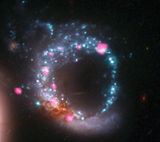 Today's image is billed as a ring of black holes. As such, it presents a fairy ring of gravitational fantasies.
Today's image is billed as a ring of black holes. As such, it presents a fairy ring of gravitational fantasies.
The first fairy dances a fantasy of Redshift-is-Proportional-to-Distance, overlooking half a century of contrary evidence. That puts the ring far away. For the ring to appear as bright as it does, a second fairy must dance a pas de deux of Super Luminosity. To get that much energy from the feeble force of gravity, a third fairy must support the others with the Dance of Great Mass.
Since the ring is constrained by the Assumption of Equivalence of Mass and Matter, a fourth fairy must squeeze in–and be squeezed to a supernatural density. She (or he, we can't tell at these densities) can't dance but can only quiver and quake. When the other fairies bump into her, she does emit X-rays. The ring is the result of the crowded stage and the bumping.
Fairy rings and fantasy dances are entertaining, but when a theory requires this much supernaturalism, it would be wise to question assumptions.
Comment: Yes, I saw the report calling this a ring of black holes and I was not particularly impressed. In a universe that is 99.99% plasma, where the same effects can be reproduced in the laboratory and can be proven to scale up to many orders of magntitude, the black hole myth-making needs to stop.
Astronomers Question Existence of Solar System's Mystery Planet Tyche
Fox News, 16th February 2011
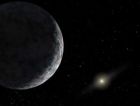 A duo of planetary astronomers grabbed media attention by claiming a planet four times the size of Jupiter may be lurking in the outer solar system. They call the planet Tyche.
Many astronomers, however, say it probably isn't there.
A duo of planetary astronomers grabbed media attention by claiming a planet four times the size of Jupiter may be lurking in the outer solar system. They call the planet Tyche.
Many astronomers, however, say it probably isn't there.
The claim by John Matese and Daniel Whitmire of the University of Lousiana-Lafayette is not new: They have been making a case for Tyche since 1999, suggesting that the giant planet's presence in a far-flung region of solar system called the Oort cloud would explain the unusual orbital paths of some comets that originate there.
"There's evidence that some Oort cloud comets display orbital peculiarities," Matese said. "We're saying that perhaps the pattern is indicative that there's a planet there."
Although their argument is similar to the one they originally made, "what's new is that this pattern has persisted," Matese told Life's Little Mysteries. "It's possible that it's a statistical fluke, but that likelihood has lessened as more data has accumulated in the past 10 years."
Comment: Interesting, it seems that these astronomers have decided to ignore the massive increase of fireballs, meteors and sonic boom data being recorded by scientists, the military and amateurs. Maybe, even the 25 comets hitting the Sun in 10 days in December 2010, officially reported by NASA scientists on the NASA website is not proof enough of a massive increase in fireballs and comets? Maybe these astronomers are not even aware that things are so bad that the US military have now banned US scientists from receiving fireball data, but can't stop them recording other related phenomena in our skies? The conclusion that we have to come to is that these astronomers are either not aware of what is going on, or this is an attempt to put the public back to sleep. Anyway, the question is: what exactly is causing a firestorm of asteroids, meteors, comets, small space rocks, meteoroids, and dust that we already know is coming from the direction of the Galactic centre? I have suggested (see the Delft University evening presentation), that our solar system, that is surrounded by the hypothesised Oort cloud of cometary debris, is being disturbed as it moves into the completely different region of space region, that scientists generally refer to as 'G Cloud'. This molecular cloud has very different properties and seems to host extremely carbon rich dust that has already been leaking into our solar system, for some time and was "officially" discovered in 1993. Whether a mystery planet exists or not does not matter, but our planet is now in a cosmic firestorm, and this is an issue for those who think humans have the ability to fight evolutionary change.
Largest planet in the solar system could be about to be discovered - and it's up to four times the size of Jupiter
Daily Mail, 14th February 2011
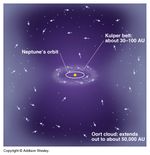 Scientists believe they may have found a new planet in the far reaches of the solar system, up to four times the mass of Jupiter.
Its orbit would be thousands of times further from the Sun than the Earth's - which could explain why it has so far remained undiscovered.
Scientists believe they may have found a new planet in the far reaches of the solar system, up to four times the mass of Jupiter.
Its orbit would be thousands of times further from the Sun than the Earth's - which could explain why it has so far remained undiscovered.
Data which could prove the existence of Tyche, a gas giant in the outer Oort Cloud, is set to be released later this year - although some believe proof has already been
garnered by Nasa with its pace telescope, Wise, and is waiting to be pored over.
Prof Daniel Whitmire from the University of Louisiana at Lafayette believes the data may prove Tyche's existence within two years.
He told the Independent: 'If it does, [fellow astrophysicist Prof John Matese] and I will be doing cartwheels. And that's not easy at our age.'
Comment: Well it looks like a lot of conspiracy theorists may have been right all along and there is something lurking at the edge of our solar system that we can't see
but is being blamed for disturbing the debris in the Oort Cloud, see archive for previous reports. Again, there is confusion here because this object has been given so
many different names from various scientific groups and those names dervied from ancient text. Whatever, I still think there is a disturbance in the Oort Cloud
because our solar system is transitioning into G Cloud, but the mainstream media are not being informed about that just yet. Simply, this is a massive cosmic puzzle
and revealing a few pieces of the puzzle is not going to provide a decent overall perspective of what is taking place, but many are still trying. Click image icon for
larger image.
Up telescope! Search
begins for giant new planet
Tyche may be bigger than Jupiter and orbit at the outer edge of the solar system
The Independent, 13th February 2011
"If you grew up thinking there were nine planets and were shocked when Pluto was demoted five years ago, get ready for another surprise. There may be nine after
all, and Jupiter may not be the largest. The hunt is on for a gas giant up to four times the mass of Jupiter thought to be lurking in the outer Oort Cloud, the most
remote region of the solar system. The orbit of Tyche (pronounced ty-kee), would be 15,000 times farther from the Sun than the Earth's, and 375 times farther
than Pluto's, which is why it hasn't been seen so far."
It's a long way away, but many think it has a gravitational effect and is the cause of Earth's precession.
Dark Jupiter May Haunt Edge of Solar
System
Wired Science News, 29th November 2010
"A century of comet data suggests a dark, Jupiter-sized object is lurking at the solar system's outer edge and hurling chunks of ice and dust toward Earth.
“We've accumulated 10 years' more data, double the comets we viewed to test this hypothesis,” said planetary scientist John Matese of the University of Louisiana at
Lafayette. “Only now should we be able to falsify or verify that you could have a Jupiter-mass object out there.”
In 1999, Matese and colleague Daniel Whitmire suggested the sun has a hidden companion that boots icy bodies from the Oort Cloud, a spherical haze of comets at
the solar system's fringes, into the inner solar system where we can see them."
Binary Companion Theory
Binary Research Institute
"Researchers at BRI have noticed a number of problems related to the current theory of precession. While VLBI, laser ranging and other related technologies do a
good job at determining the earth's orientation, the sun's movement through space has not been coordinated with these findings resulting in unintentional bias of
precession inputs. In examining the phenomenon of the precession of the equinox (which was the original impetus for the development of lunisolar precession theory)
we have found that a moving solar system model is a simpler way to reproduce the same observable without any of the problems associated with current precession
theory. Indeed, elliptical orbit equations have been found to be a better predictor of precession rates than Newcomb's formula, showing far greater accuracy over the
last hundred years. Moreover, a moving solar system model appears to solve a number of solar system formation theory problems including the sun's lack of angular
momentum. For these reasons, BRI has concluded our sun is most likely part of a long cycle binary system."
Many others have been querying the current accepted ideas for Earth's precession as being outdated too...
Two-timing [Stardust-NExT] spacecraft
has date with another comet (w/ Video)
PhysOrg.com, 13th February 2011
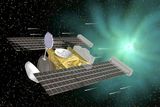 - NASA's Stardust spacecraft, equipped with the University of Chicago's Dust Flux Monitor Instrument (DFMI), is hurtling at more than 24,000 miles an hour toward
a Valentine's Day encounter with comet Tempel 1.
- NASA's Stardust spacecraft, equipped with the University of Chicago's Dust Flux Monitor Instrument (DFMI), is hurtling at more than 24,000 miles an hour toward
a Valentine's Day encounter with comet Tempel 1.
Stardust will approach to within 124 miles of Tempel 1 at 10:56 p.m. CST Monday, Feb. 14. The spacecraft flew within 150 miles of comet Wild 2 in 2004, when it
collected thousands of tiny dust particles streaming from the comet's nucleus for laboratory analysis.
The spacecraft dropped off the samples in a canister that parachuted onto the desert salt flats of Utah in January 2006 following a journey of nearly approximately 3.5
billion miles. But Stardust, still healthy and with fuel to spare, soon went back onto the interplanetary market, looking for a second mission.
Comment: Well, this is going to be exciting for some...
Comet Tempel 1: Stardust photos reveal crater that 'partly healed itself'
Photos from the Stardust-NExT rendezvous with comet Tempel 1 are streaming in. Some show a crater that was created by a different NASA mission but
never sucessfully photographed.
C S Monitor, 15th February 2011
A Possible Naked-eye Comet in March
NASA Science News, 6th February 2013
 Feb. 6, 2013: Far beyond the orbits of Neptune and Pluto, where the sun is a pinprick of light not much brighter than other stars, a vast swarm of icy bodies circles the solar system. Astronomers call it the "Oort Cloud," and it is the source of some of history's finest comets. One of them could be heading our way now.
Feb. 6, 2013: Far beyond the orbits of Neptune and Pluto, where the sun is a pinprick of light not much brighter than other stars, a vast swarm of icy bodies circles the solar system. Astronomers call it the "Oort Cloud," and it is the source of some of history's finest comets. One of them could be heading our way now.
Comet Pan-STARRS was discovered by the Panoramic Survey Telescope & Rapid Response System atop the Haleakala volcano in Hawaii. Astronomers use the massive 1.8 meter telescope to scan the heavens for Earth-approaching objects, both asteroids and comets, that might pose a danger to our planet. In June 2011 a comet appeared, and it was named "Pan-STARRS" after the acronym for the telescope.
In early March, the comet will pass about 100 million miles from Earth as it briefly dips inside the orbit of Mercury. Most experts expect it to become a naked-eye object about as bright as the stars of the Big Dipper.
"But" says Karl Battams of the Naval Research Lab, "prepare to be surprised. A new comet from the Oort Cloud is always an unknown quantity equally capable of spectacular displays or dismal failures." [...]
Because this is Comet Pan-STARRS first visit, it has never been tested by the fierce heat and gravitational pull of the sun. "Almost anything could happen," says Battams. On one hand, the comet could fall apart--a fizzling disappointment. On the other hand, fresh veins of frozen material could open up to spew garish jets of gas and dust into the night sky.
"Because of its small distance from the sun, Pan-STARRS should be very active, producing a lot of dust and therefore a nice dust tail," predicts Matthew Knight of the Lowell Observatory.
Comment: The point here is that this is a unknown comet coming very close to the Sun but it is not a sungrazer like Comet ISON that some are thinking might ignite the sun in November 2013... Btw, comets are electric... warmed ice cannot explain why comets can give off x-rays....
-
Comet Lemmon will be seen in March 2013
spaceweather.com, 7th February 2013
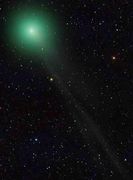 GREEN COMET LEMMON: 2013 could be the Year of the Comet. Comet Pan-STARRS is set to become a naked eye object in March, followed by possibly-Great Comet ISON in November. Now we must add to that list green Comet Lemmon (C/2012 F6). "Comet Lemmon is putting on a great show for us down in the southern hemisphere," reports John Drummond, who sends this picture from Gisborne, New Zealand: [...]
GREEN COMET LEMMON: 2013 could be the Year of the Comet. Comet Pan-STARRS is set to become a naked eye object in March, followed by possibly-Great Comet ISON in November. Now we must add to that list green Comet Lemmon (C/2012 F6). "Comet Lemmon is putting on a great show for us down in the southern hemisphere," reports John Drummond, who sends this picture from Gisborne, New Zealand: [...]
Discovered on March 23rd 2012 by the Mount Lemmon survey in Arizona, Comet Lemmon is on an elliptical orbit with a period of almost 11,000 years. This is its first visit to the inner solar system in a very long time. The comet is brightening as it approaches the sun; light curves suggest that it will reach 2nd or 3rd magnitude, similar to the stars in the Big Dipper, in late March when it approaches the sun at about the same distance as Venus (0.7 AU). Northern hemisphere observers will get their first good look at the comet in early April; until then it is a target exclusively for astronomers in the southern hemisphere.
-
Excerpts From The Electric Universe:
Part 1 - Electric Comets
Thunderbolts.info, 16th January 2010
The following is the first of a series of excerpts from The Electric Universe, copyright © 2002, 2007 Wallace Thornhill and David Talbott and published by Mikamar Publishing. Reproduced with the kind permission of the authors and publisher.
Solar Sail Stunner
NASA Science News, 24th January 2011
 In an unexpected reversal of fortune, NASA's NanoSail-D spacecraft has unfurled a gleaming sheet of space-age fabric 650 km above Earth, becoming the first-ever solar sail to circle our planet.
In an unexpected reversal of fortune, NASA's NanoSail-D spacecraft has unfurled a gleaming sheet of space-age fabric 650 km above Earth, becoming the first-ever solar sail to circle our planet.
"We're solar sailing!" says NanoSail-D principal investigator Dean Alhorn of the Marshall Space Flight Center in Huntsville, AL. "This is a momentous achievement."
Comment: Heart warming stuff! I'm happy that something has worked for these NASA scientists. A nice reminder: Never give up, never surrender... LOL!
Wikileaks: 'Galileo boss' Smutny removed over cable row
BBC news, 17th January 2011
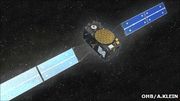 The chief executive of one of Germany's leading space companies has lost his job because of the Wikileaks saga. OHB-System's Berry Smutny was reported in a cable to have told US diplomats that Europe's Galileo satellite-navigation project was a "stupid idea".
The chief executive of one of Germany's leading space companies has lost his job because of the Wikileaks saga. OHB-System's Berry Smutny was reported in a cable to have told US diplomats that Europe's Galileo satellite-navigation project was a "stupid idea".
Bremen-based OHB-System is part of the consortium that will build Galileo's first 14 operational spacecraft. Although Mr Smutny has denied the cable's contents, OHB's board has decided to remove him from his post. [...]
Berry Smutny was alleged to have told diplomats at a meeting in Berlin in October 2009 that Galileo, a flagship space programme of the EU, was a waste of taxpayers' money.
The cable, which was published by the Norwegian daily Aftenposten last Thursday, quoted the OHB-System chief as saying, "I think Galileo is a stupid idea that primarily serves French interests", and, in particular, French military interests.
Berry Smutny (Esa) Berry Smutny denied making the comments attributed to him in the US cable
Mr Smutny was further reported to say that Galileo was "doomed for failure" or would "have to undergo drastic scalebacks for survival".
Comment: There does not seem to be a lot of news about Europe's Galileo satellite-navigation project, so this is very interesting. Recently, I listed reports of the ESA boasting in August 2010 that the Galileo system would be able to cope with Space Weather, but this was after it was reported in October 2008, that their test satellite was knocked offline for 15 days due to a surge of radiation during the long drawn out solar minimum. At the time, I thought this was not a particularly good sign, but we have not heard any more. The fact that Galileo is described as "a stupid idea" does make you wonder, if this is only related to cost-benefit.
January 6, 2011 - Fermi's Large Area Telescope Sees Surprising Flares in Crab Nebula
SLAC National Accelerator Laboratory, 6th January 2011
 Menlo Park, Calif.–The Crab Nebula, one of our best-known and most stable neighbors in the winter sky, is shocking scientists with its propensity for fireworks–gamma-ray flares set off by the most energetic particles ever traced to a specific astronomical object. The discovery, reported today by scientists working with two orbiting telescopes, is leading researchers to rethink their ideas of how cosmic particles are accelerated.
Menlo Park, Calif.–The Crab Nebula, one of our best-known and most stable neighbors in the winter sky, is shocking scientists with its propensity for fireworks–gamma-ray flares set off by the most energetic particles ever traced to a specific astronomical object. The discovery, reported today by scientists working with two orbiting telescopes, is leading researchers to rethink their ideas of how cosmic particles are accelerated.
"We were dumbfounded," said Roger Blandford, who directs the Kavli Institute for Particle Astrophysics and Cosmology, jointly located at the Department of Energy's SLAC National Accelerator Laboratory and Stanford University. "It's an emblematic object," he said. The Crab Nebula, also known as M1, was the first astronomical object catalogued in 1771 by Charles Messier. "It's a big deal historically," Blandford continued, "and we're making an amazing discovery about it." [...]
"The strength of the gamma-ray flares shows us they were emitted by the highest-energy particles we can associate with any discrete astrophysical object," Funk said.
Not only are the electrons surprisingly energetic, added Buehler, but, "the fact that the intensity is varying so rapidly means the acceleration has to happen extremely fast." This challenges current theories about the way cosmic particles are accelerated. These theories cannot easily account for the extreme energies of the electrons or the speed with which they're accelerated.
Comment:
We have another 'most extreme' astronomical record being broken, which I noted is occuring more frequently in the last few years. My belief is that there has been a change in the fabric of spacetime, almost like the fog has cleared and we are seeing more energies more coherently. However, I am not sure that this is related to these extreme particle velocities, but possibly the reason they have come into focus. The following video may be of some interest:
Gamma ray burst directed at Earth
YouTube, 10 September 2008
GRB 080319B - at 2:13 a.m. EDT on March 19, 2008, in the constellation Bootes. The gamma-ray burst became bright enough to see even without a telescope. TORTORA, a robotic wide-field optical camera operated in Chile with Russian-Italian collaboration, also caught the early light.
Menu   Next
|
Susan Joy Rennison, B.Sc.Hons. (Physics with Geophysics)
 Home
Joyfire Science & Metaphysics Integration
Copyright © 2003 – 2025. All rights reserved.
|
|
Susan Joy Rennison quotes:
“Space Weather is now a fact of life.”
“We are all astronauts now!”
Tuning The Diamonds,
September 2006
“We must spiritually evolve as part of the new terms & conditions for living on Earth.”
Joyfire Tour – Evolutionary Change, December 2006
“Space Weather will force many changes in how we do business on this planet.”
News of the Imbalance,
April 2007
NASA Press Release:
“Earth and space are about to come into contact in a way that's new to human history.”
“We're on the threshold of a new era in which space weather can be as influential in our daily lives as ordinary terrestrial weather.”
As the Sun Awakens, NASA Keeps a Wary Eye on Space Weather
NASA News, 4th June 2010
White House Executive Order:
“Space weather has the potential to simultaneously affect and disrupt health and safety across entire continents. Successfully preparing for space weather events is an all-of-nation endeavor that requires partnerships across governments, emergency managers, academia, the media, the insurance industry, non-profits, and the private sector.”
Executive Order –– Coordinating Efforts to Prepare the Nation for Space Weather Events
The White House, 13th October 2016
|
Missing Images?
How to fix web page
images not showing.
Link
Search Engines
Censor Images
From This Website!
Use Yandex.com!
Geomagnetic storm header Credit: Jüri Voit

Has the article disappeared? Try the Way Back Machine
Internet Archive
Click image for link
|
This website is best viewed with the FireFox browser, you can download it here
 click icon
click icon
|
|
















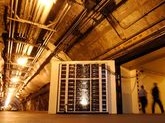





 In 2011, astronomers in Germany announced the discovery of a cloud of gas – with several times the mass of the Earth – accelerating fast towards the supermassive black hole at the center of our Milky Way. They originally said that the cloud would pass closest to the black hole in mid-2013, but a new analysis suggests the date of closest passage as early 2014. The passage of the gas cloud near the black hole is already underway, and numerous observing programs have been set up to monitor the region around the Milky Way's center during 2013.
In 2011, astronomers in Germany announced the discovery of a cloud of gas – with several times the mass of the Earth – accelerating fast towards the supermassive black hole at the center of our Milky Way. They originally said that the cloud would pass closest to the black hole in mid-2013, but a new analysis suggests the date of closest passage as early 2014. The passage of the gas cloud near the black hole is already underway, and numerous observing programs have been set up to monitor the region around the Milky Way's center during 2013.
